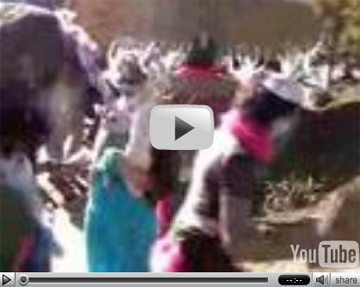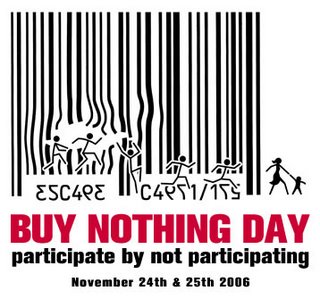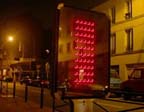July 10, 2007
The Hole in the Wall:
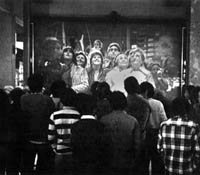
How Humans Connect No Matter What
In 1980, on a November evening in Los Angeles, pedestrians who walked past the glass windows of the Broadway Department Store noticed something strange…they did not see their reflection. There were other people walking by, just not them. They ended up talking with the alien reflections and realized that they were in two different locations, indeed, on other sides of a country: the Lincoln Center for the Performing Arts in New York City and the Broadway Department Store in Century City in LA. This work, called Hole-in-Space, was created by Kit Galloway and Sherrie Rabinowitz.
Last year I was recruited to a group to consult on a project for the Australian communications company Telstra. I recommended that Telstra, given their core brand is (I believe) enabling people to communicate with each other (not tourism!), that they install a contemporary version of Galloway and Rabinowitz’s work. Using their substantial communications infrastructure they could link together two key and important communities: rural Australia with urban Australia; and Australians in the street with people in the streets of the online virtual world Second Life. The project has been put on hold indefinitely and since the future of the project is unknown and I wasn’t compensated for my advice, I’m sharing it here. But recently I came across a different iteration on the theme, and one that bypasses the corporate and art world.
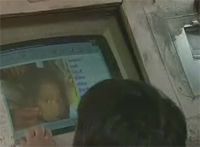
A few years ago Dr. Sugata Mitra, head of research and development at an IT firm in India, installed a computer in the wall of a slum area in India. He put it in to enable the children to use the computer and the Internet for free. He wanted to see what the children would do if they had unlimited and free access to these technologies. He called it the Hole in the Wall experiment. Within minutes, a Frontline segment explained, the children taught themselves computer literacy. Dr. Mitra has installed computers in many areas now and revels in the response. He is quite conscious of the immense impact of his cybernetic seed:
“If cyberspace is considered a place,” Mitra tells FRONTLINE/World, “then there are people who are already in it, and people who are not in it … I think the hole in the wall gives us a method to create a door, if you like, through which large numbers of children can rush into this new arena. When that happens, it will have changed our society forever.”
The segment told the story of the first boy to teach himself the computer and Net: Rajinder. He creates things using paint programs, plays games and browses the Disney website. His teacher notes that ‘he has become quite bold and expressive’.
When Dr. Mitra asks Rajinder to define the Internet, the doe-eyed boy replies immediately, “That with which you can do anything.”
And so, we move from people connecting with each other, to people tapping into possibility. The continuing theme, whether it is enunciated by artists, the corporate world or a single person who wants to heal the rift of the digital divide, is that of creating portals where once there where walls. It doesn’t matter if the wall, the ostacle is financial, cultural, geographic or technological, we’ll find a way to dissipate it. I’m so happy to have front-row seats to one of the most amazing times in Earth’s history.
Check out full Hole in the Wall article and video by journalist Rory O’Connor, and the amazing collection of Social Entrepenuers videos at Frontline/World. Thanks to Guy Kawasaki for posting about it. [blogged by Christy Dena on Cross-Media]
Posted by jo at 06:59 PM | Comments (0)
June 25, 2007
Institute for Applied Autonomy
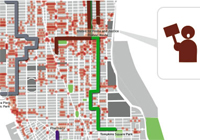
Tactical Cartography
In taking up the term 'tactical' in an arts context, we link cartography with 'tactical media,' an approach to art production that privileges critical social engagement. Since the early 90's the tactical media label has become something of a house brand for a host of widely divergent media practices embracing themes of politics and empowerment. Particularly, the term has expanded from its origin in interventionist art to ultimately include a wide variety of "alternative" and "indy" media strategies. In considering the term here, we emphasize its connotations of instrumentality.
At root, tactical media is about intervention - it is concerned with creating disruptions within existing systems of power and control. Less a methodology than an orientation, it is fundamentally pragmatic, utilizing any and all available technologies, aesthetics, and methods as dictated by the goals of a given action. Tactical media events are necessarily ephemeral - they exist only as long as they continue to be effective; once their utility has been exhausted, they vanish into thin air. While it may form a part of a long-term strategy, tactical media itself is concerned with temporary destabilization rather than permanent transformation.
Extending these notions to spatial representation, then, we claim that "tactical cartography" refers to the creation, distribution, and use of spatial data to intervene in systems of control affecting spatial meaning and practice. Simply put, tactical cartographies aren't just about politics and power; they are political machines that work on power relations. From An Atlas of Radical Cartography.
Posted by jo at 04:56 PM | Comments (0)
June 23, 2007
RADICAL JESTERS

Artists Engaged in Social Critique
RADICAL JESTERS; A Film by Tim Jackson :: Screening at Studio Soto, 63 Melcher St. Boston, MA 02210 :: June 28; 8 pm :: Admission is free with a $5-$10 suggested donation.
Recently completed, the film RADICAL JESTERS explores the work and ideas of a diverse group of performers and artists engaging in social critique. These are provocateurs and ‘interventionists’ who engage in media hoaxes, culture jamming, and imaginative art practices. Their art is not about commercial exchange but about increasing awareness and creating balance in a culture where ideas and values are often fashioned by the media.
I felt there was too little effective protest, or at least effective in terms of the media’s willingness to cover events and to evaluate itself. The work of the Situationists in France in the 1960’s and their interrogation of the “Society of the Spectacle” helped provide perspective. The work of well-known artists such as Barbara Kruger, The Bread and Puppet Theater, and others provided inspiration. I wanted to begin to look at new breed of individuals working outside the commercial system attempting to re-engage the public mind with amusing and compelling activities and to tie this work to older practices and traditions. I think the audience will get a good laugh, but that the subject will encourage discussion.
Collaboration and education were essential in developing of this film. The film is a collaboration of three groups:
• The artists themselves who are interviewed and have lent documentation of their work to the film. These include:
- The Surveillance Camera Players
- The Guerrilla Girls
- The Living Theater
- Milan Kahout (Mobius Performance Artist)
- Improv Everywhere
- Dyke Action Machine
- San Francisco Billboard Liberation Front
- Institute for Infinitely Small Things (Boston)
- Local Prankster John Hargrave
- Hoaxer Alan Abel
- John King (Gang of Four)
• Students and facilities at the New England Institute of Art in Brookline. Over a year and a half, two documentary production classes were designed around the research and organizing of the work, and the gathering of interviews. A dedicated and wonderful group of students volunteers then continued to assist with the film putting in additional hours shooting interviews, gathering b-roll, editing, sound mixing, providing graphic and web design.
• A generous group of Boston musicians each lent unique compositions to each section of the film. Musical contributions include Robin Lane (singer-songwriter), Dana Colley (Morphine), Larry Luddecke (composer, producer, and engineer – Straight Up Music), Mason Daring (66 feature films, Frontline and Nova themes), Richard Gates (Patty Larkin, Jennifer Kimball), Mike Turk (harmonica legend) and Shane Myrback (award winning student composer)
TIM JACKSON
Tim Jackson studied drama at Ithaca College in the late 60's where he worked with the priest, poet and peace activist Reverend Dan Berrigan on Trial of the Catonsville 9, and with the avant-garde theater company TheaterCosmos.
He moved to a career in music during the 70's working with dozens of groups including Tom Rush, Robin Lane and the Chartbusters, LaVern Baker, Jonathan Edwards, Patty Larkin, Mason Daring, and others, recording, performing, and touring for over a decade. He has contributed to many soundtracks as a drummer.
In the 80's Jackson returned to acting and was a founding member of the Harrison Project, an acting company under the direction of Peter Kelley. He began studying video production at the Boston Film and Video Foundation in 1982, and directed several music videos. Continuing a music career in Boston he started his own group, The Band That Time Forgot, in 1984, which earned a “Best of Boston” award in 1988 and remains active 23 years later.
In the 90's, following a Masters In Education, he began teaching at the New England Institute of Art in liberal studies and digital media. In 2006, he was awarded the college’s 1st Norm Prescott Distinguished Faculty Award. He directs the annual Naked Eye Student Film Festival at the Coolidge Corner Theater under the sponsorship of the college, and with the assistance of students.
Also in 2006, after three years, a close team of faculty and student volunteers completed the film, “Chaos and Order: Making American Theater.” Jackson acted as director and interviewer for the film, which was also done in collaboration with the American Repertory Theater. It is currently being distributed by “Films for the Humanities”.
He recently acted as on-camera interviewer for Kathleen Turner at the Provincetown Film Festival, where she received a Lifetime Achievement Award.
Radical Jesters is his first effort as producer, writer, and director.
Posted by jo at 09:46 AM | Comments (0)
June 22, 2007
Beyond Green: Toward a Sustainable Art
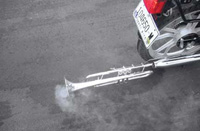
Has "activist" art exited the building for good?
"[...] This evolving hybridization has invited visual art out of the gallery and museum, and into public and unconventional spaces. Most of the art we talk about is not only critical, but also usually situated outside of traditional art venues and often in site-specific circumstances. Does that mean that "activist" art has exited the building for good, leaving only "inactive" works inside? Can socially-engaged, participatory and interventionist art retain its impact within the walls of a museum?
Stephanie Smith, Curator of Contemporary Art at the Smart Museum of Art, has proven that indeed, this work still does have a place in a museum setting. Smith is the curator of Beyond Green: Toward a Sustainable Art, a traveling exhibition of contemporary artists who address sustainability, activism and the future through their work. The exhibition has also been turned into a book by the same name, which showcases the works, essays and artists' statements of the thirteen artists and artists' groups in the show. In her introduction, Smith describes the multiple cultural phenomena and developments in design and art theory that have led to "this holistic, ethical, pragmatic and wildly inventive" artistic practice, and she explores the changing relationship between traditional exhibition spaces and non-traditional art..." From Beyond Green: Toward a Sustainable Art by Sarah Rich, WorldChanging.
Posted by jo at 05:01 PM | Comments (0)
June 21, 2007
Tribute to Reggie
This is a tribute to Exxon employee Reggie Watts, who volunteered his body to be turned into fuel. Eventually, we will turn the billions victims of climate change into fuel as well, to make life better for the rest of us. See www.vivoleum.com for more info.
Posted by jo at 05:51 PM | Comments (0)
June 19, 2007
Oil Standard

Update (0.2.1)
Michael Mandiberg just uploaded an update to Oil Standard. This version (0.2.1) fixes problems with the crude oil price feed from the mercantile exchange, future proofs the Plug-in & Greasemonkey script against Firefox updates, and enables the Plug-in to auto update itself when future versions of the script are released. If you have a previous version installed, you really should upgrade as your previous version probably doesn’t work…
Direct link to the Oil Standard Firefox Plug-in.
Direct link to the Oil Standard Firefox Plug-in.
Oil Standard is a 2006 commission of New Radio and Performing Arts, Inc., (aka Ether-Ore) for its Turbulence web site. It was made possible with funding from the Jerome Foundation and New York City Department of Cultural Affairs.”
Posted by jo at 05:15 PM | Comments (0)
June 05, 2007
Passage Oublié
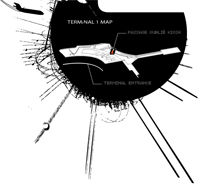
Let's Talk About Rendition Flights
Passage Oublié is an interactive artwork allowing the public to send messages to a touchscreen kiosk located in Toronto Pearson's International Airport. Messages received are animated along flight trajectories on a map featuring airports involved in rendition flights. Passage Oublié invites citizens of the world in transit at Pearson's International Airport to send messages (sms and web) relating to these questions: Are rendition flights an acceptable means of dealing with new terrorism threats? How does their use affect a country’s credibility as a defender of liberty? Does the end justify the means when it comes to pre-emptive war on terror? Are we compromising on the liberal democracies’ cherished principal of innocent-until-proven-guilty?
How to send a message: 416 300-7669 (sms starting July 1st; the airport wireless hotspots provide free access to this URL). All messages will be curated by the artists: Maroussia Lévesque, Jason Lewis, Yannick Assogba and Raed Mousa at Obx laboratory for Experimental Media.
With the support of Year 01, Concordia University, Hexagram.
Posted by jo at 03:56 PM | Comments (0)
June 04, 2007
Gustavo Romano at Rostock
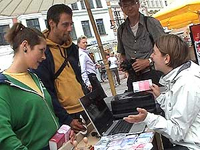
Time Notes: LOST TIME REFUND OFFICE
Participation of Gustavo Romano in ART GOES HEILIGENDAMM; Event in relation with the G8 meeting, curated by Adrienne Goehler :: Time Notes: LOST TIME REFUND OFFICE :: Action, video. :: May 23 - June 9, 2007, Rostock.
The office for the return of the lost time stands as a place for the reception and classification of the time transferred involuntarily, under pressure or for arbitrary reasons, (being employed at not wished job, serving in the army, waiting for the right man or woman, etc). In the mobile office a representative of Time Notes House has taken receipt of the description of how the deponent has lost his time and the officer has restored it with a time note of the corresponding value, the cause of the loss printed at the reverse. A copy has been stored in the Lost Time Data Base.
The action will be completed by June 2 during the great demonstration against the G8 meeting in Rostock with a release of 200 balloons. A bill with the description of the corresponding lost time will be tied to each balloon.
More information, video and images:
http://www.timenoteshouse.org
Time Notes project in the I Singapore Biennale:
http://www.findelmundo.com.ar/timenotes/
Gustavo Romano
www.gustavoromano.com.ar
www.findelmundo.com.ar
Posted by jo at 12:32 PM | Comments (0)
Stefano Cagol

Public Art Intervention
Stefano Cagol: HEAD FLU :: Venice Tronchetto :: June 5 - July 5, 2007 :: White spheres rise in the sky of the water town - two, big, visible, but at the same time fluctuating, void, suspended. 'Head', and 'Flu', influenza, influence. Head flu, influence of the head seems to entreat a moment of meditation. On the other hand, the word 'Head' detects a balloon, an inflated balloon, an empty pumpkin, which shows the opposite of reasonableness. So the association appears critical, ironical.
As ideal points of suspension, they allow for an open interpretation of the observer, as much as a series of badges virally distributed. This is in fact the other typical tool of propaganda, also used in previous works by Cagol. The badges, with a black writing on a white background like the balloons, through a sequence of associations, show the influences that direct us at the moment: bomb flu, pussy flu, bird flu, art flu, mind flu, techno flu, media flu, beauty flu, ass flu, head flu...
Stefano Cagol's public art intervention Head Flu in Venice faces the concept of – physical and mental, positive and negative – influence on a society in which centers of gravity and orders of value are altered. He succeeds by evoking bubbles and power points through a word game that become all one with the use of modalities typical of propaganda.
This project is part of his recent in-depth research developed during last year with the Bird Flu / Vogelgrippe installation in Auguststrasse at the Berlin Biennale, and with the Power Station satellite intervention at the Singapore Biennale.
Stefano Cagol holds in 2007 a solo show at NADiff - New Art Diffusion, Tokyo, a solo public project at Beurs Schowburg, Brussels, and a solo show at Priska Juschka Fine Art, New York.
He realizes a project together with Stealth.ultd at Kunst Merano Arte for 'Fromandto', and is present at National Museum of Arts of Hanoi for 'Tendencies of contemporary research', at National Gallery of New Delhi for 'The edge of vision', and at New Chinatown Barbershop of Los Angeles for 'LA auction'.
Poletti Foundation is main sponsor of Cornice Art Fair Venice.
Location: The Tronchetto area is the gateway to Venice, accessible by boat or by car. There are also very frequent public transport services from all areas of Venice and from the mainland. A boat shuttle service runs continuously between Cornice Art Fair at Tronchetto and the Biennale.
Private reception (invitation only) June 8, 6.30 p.m., VIP Lounge of Cornice Art Fair Venice.
Info: Mob. +39.348.7081417; info[at]fondazionepoletti.com; http://www.fondazionepoletti.com
Posted by jo at 08:03 AM | Comments (0)
May 29, 2007
SHELTER 07
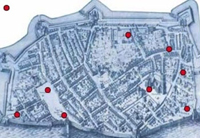
Freedom of Public Art in the Cover of Urban Space
Catharinakapel presents: SHELTER 07: The Freedom of Public Art in the Cover of Urban Space :: Harderwijk, The Netherlands :: June 2 – August 31 :: Artistic Interventions by Lara Almarcegui, Tiong Ang, Ginette Blom, Gijs Frieling, Jeanne van Heeswijk (in collaboration wih Boris van Berkum), Job Koelewijn, Irene Kopelman and Mieke Van de Voort. Curator: Henk Slager
The objective of the Shelter 07 project is to draw attention to the history of the Dutch city of Harderwijk. To achieve this goal, the genealogical significance of the name Harder-Wijk, "an elevated place offering a safe shelter to refugees in troublesome times", serves as the point of departure for the exhibition in public space. That genealogical significance causes notions such as safety and freedom to appear inextricably bound to Harderwijk's history. But how did that connection arise? Is it still linked to a spatial, site-specific concept with phenomenological connotations of physicality? Or does a medial, discursive relationship transform the current concept of "place" into a textual issue, i.e., a notion of place as a platform of knowledge and intellectual exchange?
To investigate these questions further, eight artists have been invited to produce artistic research projects related to a number of significant locations chosen in collaboration with the historical society Herderewich. The artists were asked to develop specific proposals underscoring the above problematics in an artistic form. Interestingly, in their projects, a number of related issues and topics emerged.
In order to understand a location’s specificity, Lara Almarcegui employs an archeological method eliciting that precedes space, i.e., the granting of room. On the Blokhuisplein, a historical location renowned for its straightness and power, she will create a fallow field presenting a temporary autonomous zone as a dysfunctional, undefined, and unfounded space escaping the grid of geography. At the same time, the autonomous zone is able to shelter the experience of a total freedom of interpretation.
As a location for his intervention, Tiong Ang chose the former lodge of the duty officer of the colonial yard depot, the building where volunteers for the Dutch East Indies were recruited. The lodge is situated next to a monumental gate that, thanks to the house of ill repute once situated just outside, seamlessly connects two former literary worlds of bourgeois escapism: the reality of Keetje Tippel, a famous woman of easy virtue, recorded by Neel Doff; and the contours of colonial reality, sketched by Multatuli in Max Havelaar.
Ginette Blom's intervention brings us back to a medieval conception of freedom incorporated to some extent in the double function of the 13th-century Vispoort (Fish Gate). As a crucial element in the fortress structure, this building served initially as a defensive post and lighthouse. However, at the gate’s sea-facing side, there was also a quay where fishermen could freely sell part of their catch. By means of a nighttime light projection on this historical location, a filmic memory of this pre-capitalist free trade site is evoked.
Gijs Frieling rewrites the history of the port as a freewheeling place of leisure in the form of an allegoric mural near the pier. Until the early 20th century, Harderwijk's economic independence relied to a certain extent on the presence of the (fishing) port. With the arrival of the Zuiderzeewerken - turning the greater part of the South Sea into a polder - Harderwijk's economy seemed to run aground. However, the sudden arrival of a group of dolphins at the dock entrance turned out to be the beginning of a new period of economic vigor.
Jeanne van Heeswijk (in collaboration with Boris van Berkum) developed a series of wallpapers placed on the bricked-up windows of old houses around the church square, retelling last century's lingering tales: about the symbolic poet Rimbaud, who lost his identity as a poet during his stay in Harderwijk and vanished in the grand myth of the foreign legion; about the first big stream of (Belgian) refugees who found temporary shelter during World War I in camp Harderwijk; and about the circulating rumors of missing passports popping up during the transformation of the AZC (Refugee Center) Jan van Nassaukazerne into luxury condominiums, as proof of the search for shelter in a new, safe identity for its former inhabitants.
At the spot where, till the late 1970s, the strictly Protestant “church school” (Vismarktschool) was situated, the city of Harderwijk has recently constructed a natural water reservoir. Job Koelewijn considered this an ideal place for his intervention. He put the stream of rising water and all its connotations of Flood, chastening, and eternal return into the liberating perspective of some hundreds of Great Books.
In the City Museum, Irene Kopelman investigates the 18th-century position of the University of Harderwijk as refuge for thought through an artistic interpretation of Linnaeus' botanical classification system. Just because this university did not choose for a dogmatic movement of thought but rather was open to a variety of epistemological perspectives, it was a safe haven for unorthodox intellectuals from all over Europe.
In the context of Shelter 07, Mieke Van de Voort stays temporarily in Harderwijk in the Zeebuurt area, where she develops a new work in a typical 1950s row house, icon of radical mediocrity. Here freedom seems to be entirely reduced to a one-dimensional concept. Yet, inevitably the question arises: could something cooked up in an anonymous row house ultimately prove meaningful for the balance between freedom and safety?
Parallel to the Shelter 07 presentations in urban public space, the Catharinakapel (Klooster 1) will serve as the source of Shelter 07 information during the summer of 2007, supplying information about the participating artists, the artistic research projects, the work processes and the historicity of the chosen locations.
Posted by jo at 02:27 PM | Comments (0)
May 23, 2007
Lucy and Jorge Orta
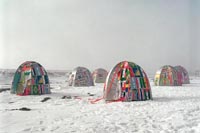
Antarctic Village
From February-March 2007, Antarctic Village - No Borders, was installed in Antarctica by the artists. They travelled from Buenos Aires aboard the Hercules KC130 flight on an incredible journey lasting several weeks. Taking place during the Austral summer, the ephemeral installation coincided with the last of the scientific expeditions before the winter months, before the ice mass becomes too thick to traverse. Aided by the logisitical crew and scientists stationed at the Marambio Antarctic Base situated on the Seymour-Marambio Island, (64°14’S 56°37’W), Jorge Orta scouted Antarctica by helicopter, searching for different locations for the temporary encampment of their 50 dome-shaped dwellings.
Antarctic Village is a symbol of the plight of those struggling to transverse borders and to gain the freedom of movement necessary to escape political and social conflict. Dotted along the ice, the tents formed a settlement reminiscent of the images of refugee camps we see so often reported about on our television screens and newspapers (official figures estimate that 141 foreigners have died trying to reach Spain in 2004, Human Rights claim the death toll was 289. 58 Chinese people discovered dead through dehydration by customs officers in the back of an articulated lorry in Dover UK in June 2000, etc., etc.)
Physically the installation Antarctic Village in Antarctica is emblematic of Ortas’ body of work, composed of what could be termed modular architecture and reflecting qualities of nomadic shelters and campsites. The dwellings themselves are hand stitched together by a traditional tent maker with sections of flags from countries around the world, along with extensions of clothes and gloves, symbolising the multiplicity and diversity of people. Here the arm of face-less whitecollar worker’s shirt hangs, there the sleeve of a children’s sweater. Together the flags and dissected clothes emblazened with silkscreen motifs referencing the UN Declartion for Human Rights, make for a physical embodiment of a 'Global Village'.
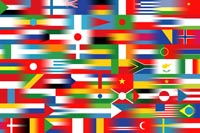
Antarctic Village - Metisse Flag: By way of calling the Orta Antarctic expedition to an end, the artists staged the first in a series of symbolic football games, ‘Heads or Tails, Tails or Heads’. Meteorologists, paleontologists and geologists from the Marambio Antarctic Base joined the Orta team to play a symbolic ‘All Nation’ match. The Metisse Flag and the Antarctic football shirts, created by the artists make it difficult to identify the adversary. The front and back of the players' shirts are stitched together with different countries’ football team colours. The match mirrors human behaviour. Appearances are often deceiving. Someone we think is a friend may actually be playing against us, while a total stranger can surprise us with an act of solidarity. It is not appearances that count, but rather decisive actions in critical moments.
Also see:
Antarctic Village - No Borders, Expedition Tarpaulin
Antarctic Village - Dome Dwelling 5005 and more.

Posted by jo at 06:46 PM | Comments (0)
May 18, 2007
256²
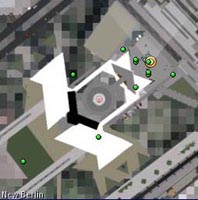
Intervention in Public Space 2007
256² is an intervention in Public Space. In this temporary piece the outline of the virtual NewBerlin in Second Life was marked by Aram Bartholl in physical space at Alexanderplatz Berlin, 15.03.2007.
Jan Northoff and Tobias Neisecke from YOUseeMEin3D.com had the vision to rebuild Berlin entirely in Second Life (they have a reservation on over 3000 Sims!). In spring 2007 they started to build the center of NewBerlin in Second Life. The TV tower at Alexanderplatz is right in the middle of the first Sim. Sim (Simulator) is the land unit of Second Life with a size of 256 x 256 meter in virtual space. But a Sim is not just a square surface in virtual space. In terms of software and hardware each Sim is a seperate instance. One Sim and all action on this Sim is hosted by one server. Also the billing model of Linden Labs, the company who is running Second Life is based on that unit.
The owner of a Sim in Second Life is in control of many functions and properties of that "land": When is night- and when is daylight? May any visitors of that sim create objects? Will these objects stay on that sim? Is health/damage activated? (Avatars can die)... and many more options.
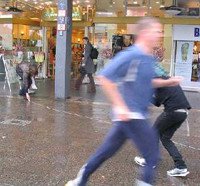
The idea of the public intervention "256²" was to make the first Sim of Second Life's NewBerlin visible in real life Public Space at Alexanderplatz Berlin. Equiped with 64 pieces of plain chalk ( 1piece of chalk = 16 m, 64 pieces = 1024 m) Aram Bartholl drew the outline of this 256 x 256 meter square in public space. The line of chalk, representing the virtual copy of Alexanderplatz crossed a McDonalds, a Church, two housing blocks, a trainstation and a mall, among other objects and surfaces.
"256²" is produced in cooperation with Jan Northoff and Tobias Neisecke from YOUseeMEin3D.com, Thanks to the team for documentation and support.
Posted by jo at 12:32 PM | Comments (0)
May 17, 2007
Indymedia Needs You
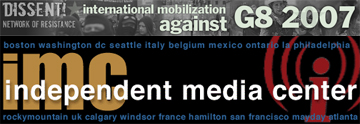
Dissent G8: The next G8 is on our doorsteps, starting with a big demonstration on June 2nd in Rostock, in less than 3 weeks. Most Indymedia websites have reported about the wave of repression that hit the German protest preparation last week. We were glad to see so much care and attention all over the network. There will be one week of actions and protests; there will be many, many media activists and we want to invite you to join us, in Rostock or wherever you are, doing the many things Indymedia's good at: independent, alternative coverage of big protests.
1. Where: There will be two physical media centres, one in a school in a Rostock city district called 'Evershagen', a bit to the north-west of the city centre, on the way to Heiligendamm. Here there will also be offices of other groups such as demonstration organisers, blockades, camps, but also a convergence centre, accomodation, information points and food.
The second media centre will be in the city centre of Rostock, smaller and mostly for less public video and audio production, likely with a little public access space. More info here which will be updated regularly. We are hoping to be able to provide public access computers in the camps. At the moment three camps are secured. More info here and a map here. The radio broadcasting van of Radio "Unerh Marburg" will be at the camp in Reddelich, which will also be a main access point for activists. There may be another media bus, from the Netherlands, either at this or another camp.
2. When
The week of action will start on June 2nd with a big demonstration, and is likely to finish on Friday, June 8th, when the summit is over. More on the 'choreography' of the actions.
3. Who
Indymedia is one part of the media activism in Rostock; there are other groups too. We're collaborating closely, but we're not the same. Don't be surprised when some prefer not to be labeled Indymedia! What we have agreed on is the term "Independent Media Centre' (which in German is "Unabhngiges Medienzentrum" and so sounds completely different. Slightly bizarre, but nothing but a local specialty. We do like each other). More details below, in the Contact section.
4 How
* subscribe to the imc-g8 list or imc-g8-2007 and the g8-mediaactivism list;
* have a look at our wiki pages (far from complete);
* find us on IRC: irc.indymedia.org #g8 (see this to learn how to use IRC);
* for mail that shouldn't be publicly archived contact indymedia at imc-g8[at]lists.so36.net
* Radio: jetsam[at]nadir.org and g8[at]freie-radios.de (en/fr/es/de), phone: 0049 (0)381 490 95 70, fax: 0049 (0)180 502 11 21 32 60, http://radioforum.fm
* Video: videoactivism(at)nadir.org, http://www.videoactivism.de/g8.html and http://g8-tv.org
* Foto: g8-foto[at]riseup.net
* Translations: if you want to help do translations or co-ordinate translations, please contact translation[at]lists.indymedia.org or subscribe to http://lists.indymedia.org/mailman/listinfo/translation
5. What we need your help with
Generally speaking, we need support with all aspects of media activism: editorial, print, supporting the public access spaces, translations, radio, dispatch, tech, video etc. because we do have the impression this is going to be BIG! Details and workspace on the wiki here. We will also need quite a few people ready to help out with very basic things such as doing the helpdesk at the entrance of the media centre(s), preparing information about how we work (see https://g8.indymedia.org.uk/Main_Page#G8_Reporting_Guides), preferably in a way that can easily be printed and hung on the walls of the IMCs.
What we would like to know more specifically is:
- - Who will be coming and what are you planning to do?
- - We will be doing multilingual reporting on the German Indymedia website. See the coordination page here. So we are wondering what the best way would be to make languages 'available', other than English and German. As there is no one Italian website anymore, nor one central French or Spanish language website, do you think it makes more sense to collect material in these languages on the German website, with your support, similar to http://de.indymedia.org/en/ for English or maybe just a category? Or would you rather do this on different websites? And if yes, which?
Which other languages will be interested/worth doing?
We will need more website editors, please get in touch if you are interested.
- - Can you bring hardware? There is a general lack, and more specifically a need for video and audio editing computers.
- - The current plans for video coverage and radios are being prepared by groups with very specific concepts (see below). What we don't have so far are people/groups who would like to offer places for video and radio activists 'in an indymedia style', basically areas in the imc for them, organising for computers that can be used for this, preparing support and some kind of collective atmosphere for video/radio activists to feel 'at home'. If you would like to feel responsible for this. please let us know.
6. Donations
There is a major financial deficit at the moment, we're lacking 11,000. Please help and ask for donations in any possible way!
To: Netzwerk Selbsthilfe e.V.
Bank: Bank f=C3=BCr Sozialwirtschaft
IBAN: DE46100205000003029803
BIC: BFSWDE33BER
Subject: Medienzentrum G8
For money transfers inside the EU free of charge, if you want to donate from outside the EU, please get in touch.
7. General information
This is an excerpt from the general info brochure that will be distributed everywhere and will contain information on all parts of the protests:
The Independent Media Centre (IMC) is a media collective which will be organising reporting on the official G8 summit, the alternative summit and, of course, the protests. The IMC promotes a method of reporting which does not treat news as goods. Instead, it is about grassroots reporting, by the people involved in the protests themselves, by you!
DON'T HATE THE MEDIA - BE THE MEDIA!
We want to offer you the possibility to publish your observations and experiences in the form of text, images, audio or video clips; directly from the streets, to disseminate all over the world. Don't wait for the news industry to spin out stories about your life and our movements; instead, help create and determine the news and, together, we can tell the 'people's news' by making the stories ourselves!
This is how it works at the G8 2007:
The IMC is located at the protest centre in the Evershagen school, together with the convergence centre. Here, in the camps and in the 2nd media centre in Rostock City (Friedrichstr. 23), we will set up computers with public access. Just look out for the ((i)) sign! You can use these computers to write your texts and upload your reports with or without photos. If you are a radio or video activist, you can also come to the IMC and find fellow activists with similar ideas, as well as people with knowledge and experience in case you need technical support.
Independent Media - tune in here:
Internet:
You can find up-to-date news and reports in different languages on http://de.indymedia.org. Various other media collectives are also linked on this page.
Mobil phone (WAP):
If you have a relatively new mobile phone, you can access http://de.indymedia.org/wap. This wap-ticker will always keep you up to date with reports about what has happened around Heiligendamm.
Radio:
You can find our radio programs on http://de.indymedia.org and in different languages on http://radioforum.fm. From the 1st to the 9th of June we will have a radio live-stream with practical information about the latest developments on the spot as well as several streaming-programs for independent radio stations throughout the world. It might be useful to carry a small radio with you.
Video:
The latest video-clips can be found on http://g8-tv.org. From June 2nd - 8th, at 9.00 p.m. they will stream a half hour program with the News of the Day in German and English language. There will also be public screenings of these and other videos at the convergence centre and at the camps.
Print:
We will try to come up with a tiny daily/nightly newspaper. It will be available on the internet, so that everyone can print, copy and share it. We will try to make these newspapers available at every camp.
Participate:
If you make an important observation that has to go out immediately for the up-to-date news or the newsticker: Call: 0162-3568957 (sms and maybe mms possible as well). Watch out for more phone numbers! This number is only for incoming news, and not an info hotline!
If you want to participate in the IMC as a translator (all languages), reporter, tech or in any other form, send an email to g8-mediaactivism[at]lists.nadir.org (public archive) or g8-media[at]so36.net - or just drop in at the IMC at the convergence centre
If you want to help out the radio, e.g. as reporter: jetsam@nadir.org Contact for video activists: videoactivism[at]nadir.org Contact for still images: g8-foto[at]riseup.net General questions and information about the IMC: 0162-8727086 Any kind of donation or support is welcome and highly appreciated!
One more request:
Taking pictures or video at a protest brings great responsibility with it. Your material could get people into big trouble no matter whether they are actively participating or just standing by. Therefore: Take pictures in a way so that faces can not be recognised (during actions). Make sure that you take memory-cards/-chips and films to a secure location regularly, to minimise the risk of confiscation by the police. In any case, before publishing: All people's faces must be blurred! Even those of people who might not have been directly part of an action at that time.
Important: Make sure that the date and time of your camera is set correctly, because this can be crucial evidence afterwards. Do help document police violence and actions in general.
If you report on the protests on your own website and/or upload photos and videos, please tag your posts with "g8" and "heiligendamm" so they become part of the independent summit reporting.
( ( ( i ) ) )
R e s i s t - R e f u s e - R e p o r t
... independent news from the streets for the global community !!!
8 G8 protest information
- - Dissent network (10+ languages)
- - Small group with a lot of info http://www.gipfelsoli.org/Multilanguage
incl. newsletter
- -> https://lists.nadir.org/mailman/listinfo.cgi/gipfelsoli-int
and newsfeed http://gipfelsoli.org/feeds/rss2/98
more lists:
- - International Dissent Network list https://lists.riseup.net/www/info/g8-int
- - If you want to receive press releases in different languages, mostly German, subscribe to https://lists.nadir.org/mailman/listinfo.cgi/imc-presse
Issues that play a role in the mobilisation:
- - G8 and agriculture network (5 languages) http://dissentnetzwerk.org/wiki/index.php?title=3DArbeitsgruppe_G8_und_Landwirtschaft
- - Migration network (engl.) http://dissentnetzwerk.org/node/82
http://g8-migration.net.tf/
- - Antimilitarism
http://www.g8andwar.de/rostocklaage/rl2.php
http://dissentnetzwerk.org/node/113
- - International Day of Direct Action Against Climate Change and the G8 http://risingtide.org.uk/g8
Groups and networks:
- - Mass blockade network http://www.block-g8.org/index.php?lang=3Den
- - Protest coalition http://www.heiligendamm2007.de/index_en.html
- - The NGOs
http://www.g8-germany.info/english/index.htm
- - Alternative summit
http://www.g8-alternative-summit.org/en/
Practical info
- - Busses and accomodation for the big demo June 2nd http://www.heiligendamm2007.de/Demo_en/Demo_travel.html
- - Forum for car sharing and travel organization http://forum.free4alter.org/phpBB2/index.php?c=3D5
- - Camps
http://www.camping-07.de/
- - attac special trains from Austria and Switzerland https://www.attac.de/sonderzug
Legal Information
WHEN THE GOING GETS ROUGH What foreigners need to know about german police and laws for G8:
http://gipfelsoli.org/rcms_repos/Antirepression/When_the_Going_Gets_Rough.pdf
UK VISITOR WINNER'S GUIDE About police & protest against G8 in Germany: http://gipfelsoli.org/rcms_repos/Antirepression/UK_visitor_winners_guide.pdf
- - Border Situation
http://dissentnetzwerk.org/node/675 (will be updated)
Most of the practical info, including translations into many languages, can be found either at http://dissentnetwork.org/ or http://gipfelsoli.org/Multilanguage.
Anna
for the IMC G8 prep group
You will find updated versions of this email here: https://g8.indymedia.org.uk/IMCInfoMail
http://keys.indymedia.org/cgi-bin/lookup?op=3Dget&search=3DECE49D5Cjabber: anna_too[at]amessage.info
..after the G8? Looking for Jobs. Talk to me.
Posted by jo at 03:00 PM | Comments (0)
May 11, 2007
Heavy Opera: An Audio Tour to Awaken Londoners to
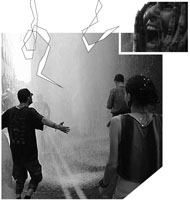
The Impact of Financial Systems on Climate Change
John Jordan and James Marriott’s operatic audio tour set in London’s Square Mile is intended to awaken city workers to the impact of financial systems on climate change. But not only does And While London Burns misgauge how much the suits already know, its hysterical tone also harmonises too easily with the coming new eco-order.
A fountain of water from the river Walbrook shoots up above my head, drums are pounding, a sound system’s bass rumbles. I hear cheers but I can also hear the clatter of police shields and batons around the corner. Seven years after London’s Carnival Against Capital, when protesters outside the LIFFE exchange broke a water mains sending a thirty-foot jet of water into the air, I am walking just a half a mile north of the same spot. Now I can hear the Thames rushing up the valley the Walbrook follows, bursting its banks, laying waste to the tall glass-fronted buildings as some of the most expensive real estate in London collapses around me. I’m swept up in a sonically induced fantasy driven by the tracks on my MP3player. I am taking part in And While London Burns, an operatic guided walk written by John Jordan and James Marriott, set to music by Isa Suarez and produced by the cross-disciplinary art and education group Platform.
John Jordan has played a role in both these participatory dramas, firstly as a member of Reclaim the Streets – one of the anti-capitalist groups that coordinated the Carnival Against Capital in June 1999. This time around as an artist commissioned by Platform – an interdisciplinary arts, campaigning and research group committed to longer term, less partisan approaches to transforming the activities of the financial institutions and corporations with head offices in the Square Mile. The walk is an attempt to dramatise the research Platform has conducted into climate change. James Marriott, its co-founder, explains:" from Heavy Opera by Anthony Iles, It's Not Easy Being Green, MUTE VOL 2 #5.
Posted by jo at 01:36 PM | Comments (0)
[iDC] Introducing: Real Costs & Oil Standard
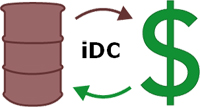
Michael Mandiberg
Trebor Scholz has asked me to write a post introducing two recent projects,"Oil Standard" (2006), "Real Costs" which I releasd a beta version of last week.
"Real Costs" is a Firefox plug-in that inserts emissions data into travel related e-commerce websites. The first version adds CO2 emissions information to airfare websites such as Orbitz.com , United.com, Delta.com , etc. Following versions will work with car directions, car rental, and shipping websites. Think of it like the nutritional information labeling on the back of food... except for emissions.
The objective of the "Real Costs" is to increase awareness of the environmental impact of certain day to day choices in the life of the Internet user. By presenting this environmental impact information in the place where decisions are being made, it will hopefully create an impact on the viewer, encourage a sense of individual agency, start ongoing discussions, and provide a set of alternatives and immediate actions. In the process the user/viewer might even be transformed from passive consumer to engaged citizen.
Experience the project by installing the "Real Costs" plug-in into your Firefox application; the plug-in is available at http://TheRealCosts.com. Currently, this plug-in pulls the origination and destination information for each flight from the page, and then calculates and reinserts the CO2 produced. It compares the CO2 produced for that flight to making that trip by bus or train, and to the average CO2 produced per capita for the average US and world citizen. It is configured to work on the websites of the largest North American air carriers (major global air carriers are currently being added.) A list of these carriers and documentation of all scientific calculations is available on the project Wiki (http://therealcosts.com/wiki).
"Real Costs" builds on many of my prior investigations into intersections between conceptualism, Internet art, and activism. I make art that explores the way the Internet shapes subjectivity and consumerism. I take common genres including e-commerce, blogs and opinion poll sites and create site-specific interventions into this digital vernacular to provoke a moment of contemplation on the part of the viewer. The key example here is the "Oil Standard" Firefox plug-in that converts all prices on a web page from U.S. Dollars into the equivalent value in barrels of crude oil. When you load a web page, the script seamlessly inserts converted prices into the page. As the cost of oil fluctuates on the commodities exchange, prices rise and fall in real-time causing the user to reflect on their relationship to the abstract fluctuation of the price of oil reported on the news everyday. "Oil Standard" synthesized my interest in hactivism and net.art, sustainable economics, and information design to create an art piece that opened up a dialogue about oil, economics, and the environment. It was used and discussed by eco-techies, high school classes, progressive politicians, and Internet artists. This project achieved the goal of making abstract information legible so as to create dialogue about the important issues surrounding how we use the earth's natural resources.
"Real Costs" and "Oil Standard" very intentionally sit in the liminal spaces between art and design, between hactivism and software development, and between situationist intervention and green-tech tool making. I have situated this project in this position at the edge of art because it allows me to present completely unexpected content in familiar forms. The goal is to seduce the viewer through what appears to be a comfortable and usual situation and to create an experience of surprise and wonder. I have done this before, in "Shop Mandiberg", (http://Mandiberg.com/shop) where I buit an e-commerce site as a container for self-portraiture, and in "Bush Poll," (http://BushPoll.com) where I made an opinion poll of the other 153 George Bushes of the country. By making art appear in everyday contexts the potential capacity for art to instigate change is integrated into daily life.
I would contextualize this approach within a growing body of similar work. I see this taking place in work like Angie Waller's http://myfrienemies.com/, Ben Engebreth's http://personal-kyoto.org/, and xtine hansen's http://delocator.net/ + http://yourneighborsbiz.com/. One of the core motivations in these works is to make something that has a function, and which changes or articulates how we interact with (one small part of) the world.
Yours,
Michael Mandiberg
++
Michael Mandiberg
Artist in Residence // Eyebeam
Asst Professor // CSI/CUNY
Michael -at- Mandiberg -dot- com
http://Mandiberg.com
++links++
http://TheRealCosts.com
http://turbulence.org/Works/oilstandard/
http://Mandiberg.com/shop
http://BushPoll.com
http://myfrienemies.com
http://personal-kyoto.org/
http://delocator.net
http://yourneighborsbiz.com
iDC -- mailing list of the Institute for Distributed Creativity iDC[at]mailman.thing.net http://mailman.thing.net/cgi-bin/mailman/listinfo/idc
List Archive:
http://mailman.thing.net/pipermail/idc/
iDC Photo Stream:
http://www.flickr.com/photos/tags/idcnetwork/
Posted by jo at 01:21 PM | Comments (0)
May 10, 2007
Sinister
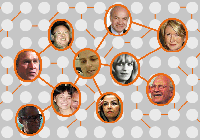
Social Networks Foster Conspiracy
Annina Rüst's Sinister "is a service based on research into software designed to identify and analyse suspicious behaviour through communication patterns rather than the content of conversations (data-surveillance). Visually, Sinister appears as a friendly social networking environment, but it suggests that social networking also fosters conspiracy. Online chat bots and automatised scoundrels (artificially intelligent characters) infiltrate chat networks and discuss seemingly common-place topics such as gardening, but occasionally include criminal harmful comments. You can telephone the bots and insert your own messages into their conversations also, using voice recognition software which looks for con-spirative content. The software then maps and interprets these online conversations, comparing diagrams to a database to determine the possible unfriendly uses people might have for the online social network. In the gallery-based installation, the seats represent the nodes in the social network – by moving the seats around as you join into conversation with your fellow visitors, the computer can then draft and analyse new diagrams based on the connections in the social network you create." Part of MY OWN PRIVATE REALITY: GROWING UP ONLINE IN THE 90S and 00S.
Posted by jo at 01:16 PM | Comments (0)
May 01, 2007
Michael Mandiberg's "Real Costs"
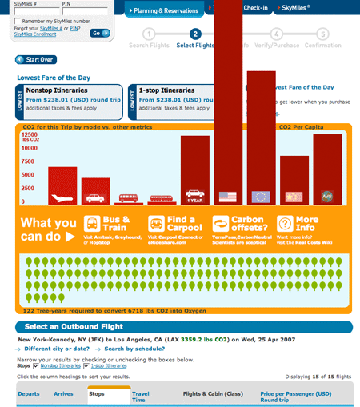
Emissions Alert!
Real Costs is a Firefox plug-in that inserts emissions data into travel related e-commerce website. The first version adds CO2 emissions information to airfare websites such as Orbitz.com, United.com, Delta.com, etc. Following versions will work with car directions, car rental, and shipping websites. Think of it like the nutritional information labeling on the back of food... except for emissions. Requires Greasemonkey. Also by Michael Mandiberg: Oil Standard.
Posted by jo at 10:36 AM | Comments (0)
April 27, 2007
Critical Mass Brooklyn 2007
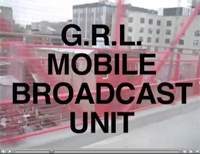
Mobile Broadcast Unit
The G.R.L. rolls out its newest probably-not-street-legal vehicle, the Mobile Broadcast Unit: audio, projection and L.A.S.E.R. tag systems all mounted on a big tricycle. Last Friday, the G.R.L went to war against boredom and had a blast riding and writing with Critical Mass in Brooklyn. Beginning in the summer in NYC you will be able to borrow the MBU to wage your own personal wars in the city. Stay Tuned.
Posted by jo at 01:47 PM | Comments (0)
April 24, 2007
Climate Change Threat Advisory

re-learn the threat levels
Climate Change Threat Advisory: In 2004 Sir David King, Chief Scientist in Tony Blair's government, began saying that global warming is a greater threat than terrorism. Hans Blix, who ran the UN weapons inspection programme in Iraq, said the same. Studies made for the Pentagon and the World Bank recommended immediate action to address imminent threats posed by global warming, with the Pentagon's report warning that global warming is a greater threat than terrorism. With this idea in mind, the Bush administration's terrorism warning system has been redesigned. The new advisory system clarifies the climate change threat levels facing people everywhere. Please re-learn the threat levels: Earth Day comes only once a year, but the environment needs year-round care. Has audio. Produced for Transnational Temps.
Posted by newradio at 12:05 PM | Comments (0)
April 20, 2007
Natalie Jereminjenko
The Floating Clinic-GOOD Magazine.
Posted by jo at 10:12 AM | Comments (0)
April 09, 2007
Urban Interface | Berlin (Olso)
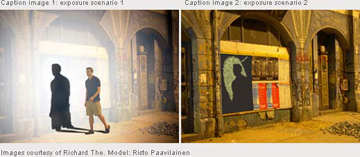
Interspaces of Public/Private Urban Space
Urban Interface Berlin :: A symposium, exhibition and curatorial research project exploring the interspaces between public and private urban space :: April 15 to May 6, 2007 :: Berlin and Oslo :: Some of the works are:
Exposure, by Jussi Ängeslevä (FI) and Richard The (DE), is a spatial art installation combining smart materials, simple sensor electronics and poster design to weave micro narratives for the unsuspecting public as they navigate through the urban landscape. An array of unobtrusive, monochromatic posters is arranged along a segment of a passageway. Adjacent to the individual posters a light gate is watching when a pedestrian passes by the poster. The light gate is connected to a tele-objective camera flash and triggers it, casting the person’s shadow momentarily on the poster. The poster, being covered with fluorescent ink, captures the shadows and retains the glowing silhouette, becoming an integrated element of the poster’s graphics which gradually fade away. The work can be seen as a commentary and counter-reaction to the established disempowerment of the individual. Above and beyond the exhausted Big Brother discourse, Exposure takes a stand also on the new emergent "Participatory Panopticon", or "Little Brother", the ever present prying eye of the neighbours’ ubiquitous camera equipped digital device.
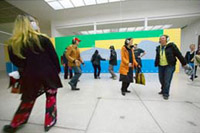
The project series Mitting operates at the interface between the sociologically and culturally different boroughs of Mitte and Wedding. For two days, the area that has been defined for the exhibition acts as a space for actions and as a starting point for mobile and stationary events. Oliver Hangl puts on two “Secret Tours” through public and private spaces that bring the coexistence of these parallel cultures to awareness. The participants, equipped with two-channel wireless headsets that enable them to choose between two alternative streams of information presented by the guides and musical liveacts, will be led through the different areas by two tour guides as well as musicians, actors, artists, DJs and a technical crew. Statements from pedestrians and local residents will flow into the liveact audio streams.
Mitting separates levels of perception while isolating the participants. On the streets, in warehouses, flats, and wherever the groups enter, they appear mute to residents and passers-by. Because of the dialogue that is sent inward through headphones, the action bears a subversive potential. But the participants should also be alert to when reality turns suddenly into fiction.
Oliver Hangl declares spaces, participants and watchers an open field of imagination, an audiovisual energy field that oscillates between performance, demo-protest and communication experiment… „Remember, that it’s all in your head!“ (Gorillaz)
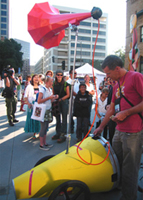
Daniel Jolliffe presents the project Berliner Stimmen in the context of urban interface | berlin. His work is a mixture of mobile sculpture and performance that examines the participatory moment. Visually, Berliner Stimmen is a sculpture mounted behind a bicycle, but its main function is performative. Over a period of three weeks, Jolliffe will cycle through the borough of Mitte, Wedding and Gesundbrunnen three times a week. While he is travelling, the loudspeaker broadcasts previously recorded one-minute calls. It is possible for each caller to have his message broadcast in the public space. The past realisations of the project under the name of One Free Minute in San José and Vancouver have shown that the callers use this public platform for different reasons. The spectrum of the recorded messages includes private statements and stories as well as commercial announcements and political speeches. In times when governments and public agencies are increasingly vigilant of who is saying what and where, citizens and activists can express their opinions in Berliner Stimmen freely and without fear of repression.
Also on exhibit: Laura Beloff's Head; Zone-out of Vision.
ABOUT urban interface | berlin
The project deals with the changing notion of private and public space that occurs due to, particularly, the everyday use of communication technologies. The artworks in the context of urban interface convey the idea of public space as an accessible and contributive sphere and call attention to a more sensitive engagement with the private, physical and digital spheres.
The works are developed for individual spaces by participating artists and if possible realised in cooperation with hosts. Hosts can be private individuals as well as companies, which then communicate the artworks out of their private spaces into the public. Private becomes public, public becomes private. Art space intermixes with urban space.
In responding to selected public and semi-public sites and their inherent qualities, the artworks will become focal points of the shifting conceptions of private and public space. Being often immaterial and digital and located at the difficult-to-define boundaries of private and public space, the artworks challenge all users – perceivers, organisers and the local authorities to formulate and discuss their individual understanding of those spaces. At the same time, the dispersed and temporary nature of the artworks challenges the formula of exhibitions in public space.
This website is conceived as an archive and contributive forum which ideally could serve as a knowledge platform for other art projects dealing with or happening in public space. To that end, relevant processes between the involved parties such as artists, sponsors, organisers and the city administration will be published on this website. Hence this website can be understood as another interface between private and public, theory and practice.
The thematic discourse is extended to presentations and panels accompanying the exhibitions
Posted by jo at 05:27 PM | Comments (0)
April 06, 2007
Mistaken As Red
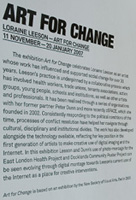
Loraine Leeson's Art for Change
With political art now celebrated in galleries and museums all over the world what happens when practices tied to specific struggles and places are institutionalised? At the recent retrospective of textbook political artist, Loraine Leeson, Peter Suchin uncovers the remains of an earlier discussion intitiated by Art & Language to propose a radical reconsideration of Leeson’s art and the terms of the debate.
The recent retrospective of the work of Loraine Leeson at London’s SPACE studios, Art for Change, throws up a number of questions about the efficacy and even the desirability of something one might term, for the sake of convenience at least, ‘political art’. This is an issue to which I will return below. Based on a much more substantial exhibition organised by the New Society of Visual Artists in Berlin, 2005, the London show focused upon a number of key projects organised and executed by Leeson in collaboration with her former partner and colleague Peter Dunn... ‘The exhibition’, according to the accompanying leaflet, ‘celebrates Loraine Leeson as an artist whose work has influenced and supported social change for over thirty years. Leeson’s practice’, the text tells us, ‘is underpinned by a collaborative process which has involved health workers, trade unions, tenants associations, action groups, young people, schools and institutions, as well as other artists and professionals.’" Continue reading Mistaken As Red by Peter Suchin, Mute.
Posted by jo at 11:50 AM | Comments (0)
April 04, 2007
Participatory Urbanism
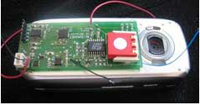
Phone as Environmental Instrument
Last week in Oslo, i attended a very inspiring talk that Tom Igoe gave at the Oslo School of Architecture. He presented open source ideas and explained their impact on the way we think about space.
Among the projects he showed was Participatory Urbanism, a work by Eric Paulos, Ian Smith and RJ Honicky that turns the mobile phone into a “networked mobile personal measurement instrument."
On the one hand, there's a sophisticated device, the mobile phone, which provides us very little insight into the actual conditions of the terrain we traverse with it.
On the other hand is the fact that we must defer to a handful of civic government installed environmental monitoring stations that use extrapolation to derive a single air quality measurement for an entire metropolitan region. Such data doesn't reflect the dynamic variability arising from daily automobile traffic patterns, human activity, and smaller industries.
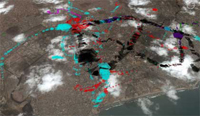 [Left: Carbon Monoxide readings made with taxicabs across Accra, Ghana] The goal of Participatory Urbanism is to provide mobile devices with new “super-senses” by enabling sensing technologies such as noise pollution, air quality, UV levels, water quality, etc. to be easily attached and used by anyone, especially non-experts.
[Left: Carbon Monoxide readings made with taxicabs across Accra, Ghana] The goal of Participatory Urbanism is to provide mobile devices with new “super-senses” by enabling sensing technologies such as noise pollution, air quality, UV levels, water quality, etc. to be easily attached and used by anyone, especially non-experts.
Integrating simple air quality sensors into networked mobile phones promotes everyday citizens to uncover, visualize, and collectively share real-time air quality measurements from their own everyday urban lifestyles. This rich people-driven sensor data leverages community power imbalances, and can increase agency and decision maker understanding of a community's claims, thereby potentially increasing public trust.
Other projects Tom Igoe presented: Public Air Quality Indicator, Area's Immediate Reading and i'll add Neighbourhood Satellites. [blogged by Regine on we-make-money-not-art]
Posted by jo at 03:38 PM | Comments (0)
April 03, 2007
1ST BIENNIAL OF THE END OF THE WORLD

USHUAÏA PATAGONIA
USHUAÏA PATAGONIA: THE SENTINEL AT WORLD'S END :: Warning message for all humanity from the Land of Fire :: This year like every other, Fred Forest made sure to mark the occasion of the Fête de l'Internet, an event to which he was one of the initial contributors. And now, in the wake of interventions in Brazil and the USA, the multimedia artist has been called on to represent France during this the International Polar Year at the first Biennale of the End of the World in Ushuaia, Patagonia, at the heart of the Land of Fire.
Known for his critical approach and his mindful independence from the official contemporary art market, he represents an emerging category of artists refusing compromise with the dominant artistic system. Fred Forest's ambition is to have artists be exemplary new actors in direct contact with social, economic and political realities whose purpose is to "pacify" the world thus giving it back its meaning. Dubbed "The Sentinel at World's End," a lighthouse equipped with varied communications equipment will stand at the brink of the sea in Ushuaia, turned towards Ushuaia, and emitting distress signals.
The primary objective of these signals is to warn the world of the peril that mankind's blind madness places it in. Mass extinctions, the pillaging of natural resources, pollution, human violence of all breeds, fanaticisms, fundamentalisms, terrorism, economic disparities, ever-encroaching world mafias, gangrenous democracies, political and ethical obsolescence. "The Sentinel at World's End," propped between earth and sky, between pack-ice and the luminescence of The Land of Fire, will incessantly transmit this warning message along with other wavelengths. The beneficent fluctuations of these wavelengths will envelop the world in a light shawl, a shawl which would embody the precursory signs of a new consciousness. This emerging consciousness, wisdom, and intelligence will allow humanity to finally move towards a next level of individual and collective evolution at this time of crisis at the beginning of the third millennium
For Fred Forest, changing the world begins in your own front garden. Without an ecology of the mind, ecology its in classical sense is an empty promise, instrumentalized by politics, scientists, industry, and soon, no doubt, big business. Contact: reseauactif[at]wanadoo.fr
Posted by newradio at 07:00 PM | Comments (0)
March 23, 2007
Interview with Gazira Babeli by Tilman Baumgärtel
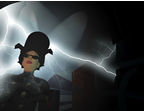
My body can walk barefoot, but my avatar needs Prada shoes
Tilman Baumgärtel: Is Gazira Babeli your real name? If not, tell us a bit about your existence outside of SL.
Gazira Babeli: Yes, it's my real name in Second Life but most of people call me Gaz'. Outside SL, my existence is not so different from yours... drinking, eating, sleeping, meeting people, looking at a computer monitor and working the least possible.
Tilman Baumgärtel: You mess around with the code in Second Life. Can you give me a non-technical description how you insert your code into the system?
Gazira Babeli: Codes are just instructions, imperative verbs. An example: PUSH-IT-FAR... a box, a Museum, a Church, an avatar-person... or an entire avatar audience. The result could be spectacular and/or create social troubles. I found it easier to call these instructions "performances" or "actions". It makes sense in SL frame-space 'cause the results look more like a sensible real space than a computer output.
Tilman Baumgärtel: Why do it at all? Isn't Second Life fun enough as an imitation of the real?
Gazira Babeli: Yes, imitation is fun, but it's only the "background color" of every possible behavior. I'm exploring that.
Tilman Baumgärtel: Why intervene into Second Life, if there is a whole world out there. What is difference between a performance in SL and in the real world?
Gazira Babeli: I would say that the term "whole world" itself is more or less virtual. There's a whole world of people working in call-centers and one hand-making shoes. There's a whole world considering itself privileged because it can have access to information and spends a great deal of its life idling on Office or on a Web Browser. We keep forgetting that what we call Real Life has been a virtual frame for a long time. Second Life offers the chance to build and deconstruct this space in the form of a theatre performance. What's the difference? I'm trying to find out. For the moment I like to say: my body can walk barefoot, but my avatar needs Prada shoes.
Tilman Baumgärtel: Are you familar of the net.art of the 1990s, and is your work influenced by the likes of Jodi et al?
Gazira Babeli: COME.TO.HEAVEN actions are inspired by Ives Klein and JODI. Weird mix, don't ask me why. I also loved Alexei Shulgin 386DX shows and some extremely conceptual stuff by Florian Cramer. RTMark net.prankster projects was really weird. It has been a very meaningful scene. For me net.art is like a wild middle-age of Internet.. Second Life seems to offer a Renaissance Perspective.
Tilman Baumgärtel: Do you create any work outside of SL? Have you shown your work in the real world and if yes how?
Gazira Babeli: This is an interesting problem. First: I cant get out of Second Life because I exist only thanks to Second Life. Two: I saved thousands of high-resolution images and videos that some people, in the physical world that u call RL, are willing to publish. An interesting solution would be the one I experienced with the PEAM festival. I simply offered the curator the digital images and a very detailed license with all the print specifications. At present Im finalizing the shooting of a movie which draws inspiration from "Simon of the Desert" by Bunuel and from the early Buster Keaton. The set is a portable desert, as big as 16 regions, and very likely the title is going to be "Gaz' of the Desert". I hope it will reach somehow physical world, because the only thing I really cant stand in SL is going to the movies. I find it very disturbing for an avatar who is already living in a film-like environment.
Tilman Baumgärtel: Did Linden labs approach you or even try to kick you out due to you actions, especially the "Grey Goo" performance? Or did the builders of the Virtua Art Center come down on you?
Gazira Babeli: During "Second Jesus", one of my first performances, I have been contacted by a Linden. I believe it only wanted to understand if my aim was to offend Christian beliefs; I did not want to offend anyone, of course. "Grey Goo" was a trivial trick, quite amazing but totally harmless. Media probably misunderstood some information, spreading the "grey goo bandits" panic. I do not believe Lindens want to interfere as "virtual cops", they have more substantial problems and aims. I think Lindens would prefer residents to solve their internal troubles instead of filing a "Report Abuse". The Artwork "DONT say" is the result of this consideration: it allows to register those words we consider abusive and when someone pronounces them is seized by a tornado and shaken up until he apologizes. The effect is very cartoon-like.. Wile E. Coyote and Road Runner. After "Singing Pizza" (the symbolically abusive installation in Ars Virtua), the director Rubaiyat Shatner wanted to talk to me, he was worried and amused. We became friends though maintaining different views on SL-Art. Most SL residents believe they can build only visible "objects", but the range of behaviours and the margins of freedom are wider than most people think.
Tilman Baumgärtel: Most of your works seem to focus on manipulation of the technology of SL rather than e.g. intervening into the social conventions. Why?
Gazira Babeli: It's strange.. some people asked me the same question reversed. From my point of view, we are talking of two elements which are complementary, not divisible. SL is a complex society and without a univocal final aim. It includes heterogeneous social forms and conventions. The social-symbolic exchange is generally based on a sort of parody of the consumer-oriented western world... in brief, gadgets on which to build up one's identity. This happens in a fairly anarchic and pacific way, thanks to a "dictatorship" of the technologic protocol, strictly defining properties and utilization concessions. Now we consider Google as a friend but even Google is a strange phantom-dictatorship on information. It this good or bad? Try to imagine internet without Google. Now, SL is a smaller environment compared to the Web, but I think it is a step ahead. My art consists in experimenting in an ironic and "pop" way the complementary and often contradictory aspects of a "whole world" which, despite being inhabited by "puppets", it hosts at least a million people. Real people.
Tilman Baumgärtel: A lot of people are put off exactly by the consumerist or capitalist leanings of SL, and - unlike you - not every body sees them as a satire, but rather as a confirmation of the status quo. Can you imagine a more utopian system (without money, without exchange value, without work...), and would you prefer it?
Gazira Babeli: We are mixing up two different issues: anthropological observation and ethical judgement. Of course Id love to login in a space called "First Utopia"! I can even imagine it but only from a technical point of view peer-to-peer protocols taught me a lot. Would I prefer it? I honestly cant answer to this question, first I should live in it a few months. Second Life, on the contrary, is an accomplished fact. If I like SL? I never said that and I dont want to say it. You talk about satire, I repeat parody. The distorted and conscious imitation of a model is something concerning theatre or literature.
If you have grandeur manias you can buy a castle and crown yourself King even if you are connected from a small flat in the suburbs; if you feel antisocial you can become a black box there are the headquarters of the French National Front and of the Anti National Front. The majority of the people I met are aware of this imitation-distortion the parody of what we call real life. ["My body can walk barefoot, but my avatar needs Prada shoes" Interview with Gazira Babeli by Tilman Baumgärtel via nettime] Related 1, 2.
Posted by jo at 01:18 PM | Comments (0)
March 15, 2007
NOSO

NO SOcial Networking
NOSO is a real-world platform for temporary disengagement from social networking environments. The NOSO experience offers a unique opportunity to create NO Connections by scheduling NO Events with other NO Friends. These “NO” events, called NOSOs, take place in designated cafés, parks, libraries, bookstores, and other public spaces. Participants – whose identities remain unknown to one another – agree to arrive at an assigned time and remain alone, quiet and un-connected, while at the same time knowing that another “Friend” is present in the space. NOSOs are scheduled by users through the NOSO website. They last for a duration of 1 - 30 minutes, after which participants disperse and return to their regular activities.
NOSO is produced by Glowlab’s Christina Ray as a commissioned project for the ongoing SoEx Off-Site, Southern Exposure’s yearlong series of public art and related programs investigating artists’ strategies for exploring and mapping public space. For NOSO, Ray has invited artistic collaborator Kurt Bigenho to participate in the development of the project. Ray and Bigenho work together as The Organizers, and recently produced The Sams for Fountain Miami.
Posted by jo at 11:29 AM | Comments (0)
March 08, 2007
MobSpray
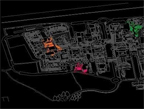
A Mobile Radicals Project
If computer applications are to become pervasive then they must become part of the everyday fabric of our lives and will provide users with the ability to interact with objects and places within both the real and virtual worlds. One trait of human behaviour in the interaction with objects appears to be an inherent passion for leaving our mark on these objects. In our current society, this is most readily evident through graffiti spray-painted in public places. To some, this is urban art reflecting the communities in which it resides, whilst to many it is an act of vandalism.
SprayCan graffiti divides communities and generations in terms of how it should be dealt with in terms of either complete acceptance or punitive action. In MobSpray we have developed a system that tries to bridge the divide as it both provides writers with a means of tagging their environment, using mobile phones and RFID tags, whilst minimising the physical effects to the landscape for the communities where it resides.
Writers’ tags are deposited, and collected, from a database operating on a central server using a GPRS connection initiated by a Java application on a Nokia 5140 with an in-built RFID reader. These tags are currently displayed on the writers phone but the system is being evolved so that they can be projected on walls in urban landscapes.
Posted by jo at 12:38 PM | Comments (0)
March 07, 2007
John Edwards’ Virtual Attackers Unmasked
Read John Edwards’ Virtual Attackers Unmasked by Lou Cabron.
Posted by jo at 08:44 AM | Comments (0)
March 06, 2007
REAL Alien Invasion of "Our Minutemen" at a Home Depot
Videos are posted on YouTube and the comment and rating interactions become a network performance. The video itself refers to and calls into question YouTube itself. Thanks to all the Minutemen's anti-clown comments, they made the video one of the most commented on videos on YouTube the day it was posted. More of our videos are in the "related" chunk of the YouTube page and here: http://circasd.org/clown-media.html. Related post >>
Posted by jo at 04:02 PM | Comments (0)
March 04, 2007
New Climates

Art, Climate Change and Networked Culture
New Climates, curated by Shane Brennan, is an online exhibition of new and existing artworks responding to the relationship between art, global climate change and networked culture. This curatorial weblog will create a flexible and open-ended space to address these ideas at a time when climate change has become a vital concern among artists. Launching in the spring of 2007, New Climates will take the form of a continuously-updated and extensive video weblog.
14 artists have been selected to create short web-videos responding to the pervasive discourse and images of the climate change crisis. The original works may include animations, documentaries, personal testimonials, appropriations, data streams and text or image slideshows. In addition, existing videos and other artworks relating to the theme will be posted and discussed.
As a video weblog—which will be aimed at a broad, heterogeneous audience of art- and non-art-world individuals—the exhibition will be distributed across both space and time: It will be open to the contributions of artists across the globe, and it will grow organically through a series of syndicated (RSS) posts over the course of several months. In this way, the theme of global climate change will intersect with the technology and language of global media. Just as the climate change debate is constantly shifting and evolving, this exhibition will remain transitive, flexible and open-ended.
This project will also explore the contemporary phenomenon of distributed curating: exhibiting artwork across a variety of spaces, networks, temporalities and audiences. It will take advantage of popular technologies (e.g. blogging and web-video sharing) to initiate a dialogue relevant at multiple levels to artists, curator(s) and visitors.
Work will appear in the New Climates exhibition between March and May 2007.
Artists Contributing New Work:
Michael Alstad
Anthony Discenza
Futurefarmers
Jane D. Marsching
Mary Mattingly
Joe Milutis
Cary Peppermint & Christine Nadir
Andrea Polli
Giles Revell & Matt Wiley
Brooke Singer
Jon Thomson & Alison Craighead
Gail Wight
Peter Eramian
Sarah Simon
Artists Contributing Existing Work:
Ben Engebreth
Michael Mandiberg
Posted by jo at 06:00 PM | Comments (0)
February 27, 2007
The case for network neutrality
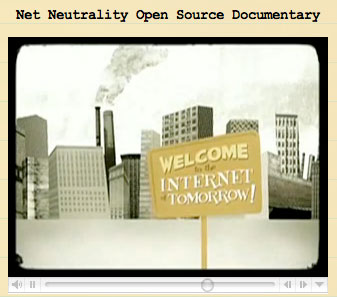
A strong video which provides an informative overview and suggestions for action can be found here. Included is code to copy and paste in your own blog to display the video. It seems very important to me that “we the digital media” act to keep the Internet open before there is only “they the digital media” as happened in the 20th century with analog. Via Lessig Blog [posted by Judy Breck on Smart Mobs]
Posted by jo at 07:42 AM | Comments (0)
February 20, 2007
Botanicalls

The Plants Have Your Number
A small group of plants in a building in New York City is quietly exchanging information. Botanicalls--a project of a team of four students at the ITP program at NYU--allows thirsty plants to place phone calls for human help. When a plant on the botanicalls network needs a lot or a little water, it can call a human and ask for exactly what it needs. When humans phone the plants, the plants orient callers to their habits and characteristics, including how they like to be watered and cared for. Call 212.202.8348 to hear more about each of the plants.
Botanicalls opens a new channel of communication between plants and humans, in an effort to promote successful inter-species cohabitation and understanding. How? Plants call people about their needs. People can call the plants to understand them better. The project originally spawned from completely non-technical conversations about indoor container gardening and the air-filtration qualities of common houseplants. Our concern about bringing plants into the ITP community was their chance of survival-- high-paced technologists seldom have time to stop and smell the flowers, let alone water them. 'But, what if,' we wondered, 'the plants could call us and tell us what they needed when they needed it? If they assigned us tasks, would this alters or engages us,' and the project was born.
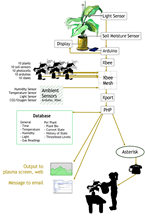
The Botanicalls project is fundamentally about communication between plants and people. We are empowering both by inventing new avenues of interaction. Plants that might otherwise be neglected are given the ability to call people and request assistance. People who are unsure of their ability to effectively care for growing things are given visual and aural clues.
The goals of this project:
1. Keep the plants alive through an interdependent relationship with co-habiting humans by translating the communication protocols of the plants (leaf habit, color of foliage, droop, etc) to more common human communication protocols (email, voice phone calls, digital visualizations, etc). More than keeping individual plants alive, we want to keep the system and project alive.
2. Make a connection between people and plants. Explore/enhance/create/visualize people's emotional connection to plants, the ways plants help humans, how caring for a shared resource can create sense of community, how natural life is a valuable counterpoint to our technical environment.
3. Gather data, create a complex and dynamic network, documentation for do-it-yourself style propagation of the project, record process. [via]
Posted by jo at 02:54 PM | Comments (0)
February 19, 2007
In-Site Montréal

Hotspot Interventions
In-site Montréal: Curator’s statement by Michelle Kasprzak :: In-Site Montréal is a collection of site-specific art presented on the portal pages of five wireless internet (Wi-Fi) hotspots in Montréal. Artists Nicolas Fleming, Maria Legault, and Virginie Laganière have created artworks that may be viewed when users of the free service provided by Île Sans Fil log in to their accounts at the selected hotspots.
The five hotspots are rooted in specific spaces, each one with its own unique properties. The In-Site Montréal project grew out of a desire to augment the experience of place for Wi-Fi users, offering an additional layer of information within the hotspot environments. The artworks that are presented on the portal pages are inventive responses to the characteristics of the spaces that the hotspots inhabit.
“The window appears to look out onto a dataspace that continues beyond the borders of the window itself. [...] But the illusion quickly wears off. The window starts to feel more two-dimensional, more like a piece of paper than a portal. The view-space appears to flatten out, to the point where the window and the data contained within the window merge.”i
Here Steven Johnson is describing the effects of using a scrolling window on a computer screen for the first time, and I am referring to it (ever so slightly out of context) to illustrate a point about the works that are being presented within In-Site Montréal. The users of the Île Sans Fil wireless network are, arguably, all hardened internet users, for whom the complexities of scrolling windows and portals and most other graphical user interface-related things are trivial.
However, since they have reached the secondary stage that Johnson refers to, where the “window and the data contained within the window merge”, there are certain expectations for an experience that can keep pace with their ability to leap from hyperlink to hyperlink.
Portals, by and large, are clumsy. The portal that occasionally pops up on my screen, which is associated with my Hotmail account, assumes I am interested in all manner of celebrity gossip and sports scores, and regional news for an area that is 45 miles to the west of where I currently live. But the works presented as part of In-Site Montréal are not attempting to form part of a portal experience that would guess the preferences of each user. The works are dealing directly with the particularities of the site where the hotspot is, which is a small enough area to be clearly defined as a common element in each user’s experience. For the elite users, something at last may jump out at them from this flattened dataspace where things feel as twodimensional and familiar as a piece of paper. Instead of the usual hurried clicking to get past a familiar “roadblock” and get to the destination they intended to go to, they may now feel that the artists of In-Site Montréal have added an observation on their local café, library, or artist-run centre that matters, that they can respond to, that strikes them out of their reverie.
“A provisional conclusion might be that in advanced art practices of the past thirty years the operative definition of the site has been transformed from a physical location —grounded, fixed, actual— to a discursive vector—ungrounded, fluid, virtual.”ii
Parts of this definition of site – fluid, virtual – are key concepts that that In-Site Montréal works with. The layer of information that floats on top, as a meta- layer to the usual experience of café users in the Île Sans Fil network is meant to be something a bit fluid, virtual and unexpected. The only definition that it does not fit is that of “ungrounded”, precisely because it is the grounding in the site that sets this project apart. Maria Legault’s interventions with her Free Sugar project may be considered particularly grounded in the sites in question. She worked with two locations, Studio XX and Café Utopik, and developed an extension of her Free Sugar project around both locations. At Studio XX, a feminist art centre that primarily consists of an office space and computer lab, she created a performance event entitled the Free Sugar Salon, that was open for anyone to attend and have the holes in their lives filled with pink pudding. She filled cracks in the architecture of Studio XX with pink icing, and then turned her attention to the attentive public that arrived at the studio, counseling them and filling their mouths with pink pudding to console them. At Café Utopik, a café/bar that regularly hosts bands and spoken word events, she conducted a surreptitious intervention, filling crevices and holes in the architecture and surrounding environment of the Café with pink icing, and documenting it in photographs. Both of these projects are presented on the portal pages of Studio XX and Café Utopik as video documentation of these actions.
Artist Virginie Laganière focused on two very different areas: the Jean-Talon Market and the area around the popular meeting place, Café Utopik. Her site-specific video pieces were shot with regular video cameras, as well as custom camera rigs attached to her body. She then manipulated the footage further in the editing suite, adding her own compositions as soundtracks and prolonging moments that happened oncamera, providing us a moment to reflect on their significance. She specifically chose to document moments where people were not as present in these spaces, and where the patterns of movement in the “off-peak” hours would become more apparent.
Through her augmentations in the editing suite, she also aims to create a piece of work that allows us to see beyond our usual clouded and harried view of the urban environment, and enjoy a view of the built environment that is tranquil, constructed, and part of an aesthetic experience. In particular, her video piece presented on the portal page of the Jean-Talon Market, usually a place so buzzing with activity as to be nearly impossible to navigate, was shot in the very early hours of the morning, when market stall owners are setting up. This meditative and slow period of the Market’s activity is hidden from most of the Market’s patrons, and Virginie’s artful editing brings out the poetry in the stasis of these moments.
Nicolas Fleming's performance art videos also present us with an alternate view of our public spaces. His work is presented at Café Kafeïn and Laïka, because of both the subject matter that he chose and the locations that he performed in. At Laïka, an extremely popular and hip bar/restaurant/club, he presents se traîner, a piece wherein he drags himself out of his apartment (which is within the same building complex that Laïka is in) and down the stairs to an escape portal – an automatic garage door. Throughout the performance he can be heard grunting with the strain of moving himself in such an unconventional way, and by the end of this performance, he is clearly exhausted. Users viewing this video must marvel about this strange and strenuous test to his body, that took place in relative secret behind the scenes of the Laïka’s festive décor. In the other piece, traîner un dj, Fleming travels to Île Sainte-Hélène to encase a dj in a canvas sac, and drag him along the pavement, with the sounds of Piknic Electronique (Montréal’s outdoor summer dance club) pounding in the background. This work is presented at Kafeïn due to the dj culture that is resonant there; the dragging of a dj must be somewhat humourous to the clientele.
Telematics is a term used to designate computer-mediated communications networking involving telephone, cable, and satellite links between geographically dispersed individuals and institutions that are interfaced to data-processing systems. It involves the technology of interaction among human beings and between the human mind and artificial systems of intelligence and perception. The individual user of networks is always potentially involved in a global net, and the world is always potentially in a state of interaction with the individual.iii
The virtual spaces that In-site Montréal inhabit are amorphous areas around several accepted gathering places such as cafés, galleries, markets, and bars. They are perhaps places where as an internet user, you may intend to use the opportunity of connectivity to the network to look outward, to read news of distant places or connect with friends far away through e-mails and online social networking sites. The art practice of telematics in particular addresses the creative possibilities when two parties are connected over distance to communicate. In some way, the pieces presented on the portal pages of Île Sans Fil’s network as part of the In-Site Montréal project present something that is almost anti-telematic, in that the works look inward rather than outward. In the case of this project, a connection to someone across the globe is not sought, it is shunned in favour of a further examination and rumination on the details of the local environment. A local resident, who is perhaps used to the culture at Café Utopik, may be best able to chuckle at the video of pink icing being added to the sign above the door. This intense inwardlooking that these pieces commit to is the essential point of the project. Instead of seeking to look outward and connect with others who are in a radically different geographic space, In-Site Montréal hopes to reconnect locals with their own space, through the language of culture, compelling users of the network to turn their gaze inward enough to consider the cultural resonances that are possible.
- Michelle Kasprzak, 2006/2007
i Steven Johnson "Interface Culture: How New Technology Transforms the
Way We Create and Communicate" 1997 Harper Collins, New York. Pg 86
ii Miwon Kwon, One Place After Another: Notes on Site Specificity, October 80 (Spring
97): 95.
iii Roy Ascott: “Is there love in the telematic embrace?”
http://www.receiver.vodafone.com/07/articles/03_page01.html
Posted by jo at 04:05 PM | Comments (0)
February 03, 2007
Networked Theatre of the Oppressed
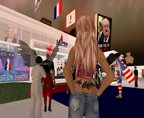
Second Life Theatre Group Meeting
Networked Theatre of the Oppressed :: First informal Second Life theatre group meeting in Bootlab Berlin :: Sunday February 6, noon (brunch time, 12.00 h) :: Tucholskystraate 6.
The dictatorship of the bourgoise melodrama stage has been an inspiration to living theatre, Brecht, Boal, and many. By combining the poetics of storytelling, digital narrative and network performing, the ghostly streets of Second Life become an open stage where the practice of everyday life becomes the raw material for political intervention thru classical drama, literature and net.art techniques. It is time for the triple alienation of the cyburbian multitudes!
Second Life's publicity is generated outside of the internet based on old media PR, circumventing the rest of the net. It is a newbie honeypot, or a themepark for cyberspace history most of all it is a "opera buffa" a theater of vulgarities, and shallow motivations, certainly more reality than what the cultural institution of the theatre has to offer today.
In our first 2 hour practise meeting we want to discuss possibilities of stage design, choreographic moves, myths and topoi, requisites and figurines, sketches of existing 3d datasets and scripting knowledge, we want to identify interesting text resources and invite people researching the field, detecting possibilities for a theater of net.art 2.0 etc. pp. not just revolting but playing with the zombie cybermyths of SL.
The Second Life can not be lived rightly...
- - how can you have virtual sex and no virtual communism?
- - between underworld and purgatory, spaces for the organized networks of
death
- - did 1995 avatar utopia needed lindon economy to reach the masses.
- - there are more than 3 million condemned waiting for liberation.
- - come and sacrifice your pets at a pergamon temple.
- - a virtual world is impossible. lindon dollars are halluzinogenic.
- - california dreaming, do you feel the network effect?
- - zoylent green is us!
- - instalaremos la primera antena zapatista de radio insurgente y la
otra campa??a en second life.
http://bootlab.org
http://possibleworlds.org
Posted by jo at 11:29 AM | Comments (0)
January 24, 2007
Rock N' Scroll
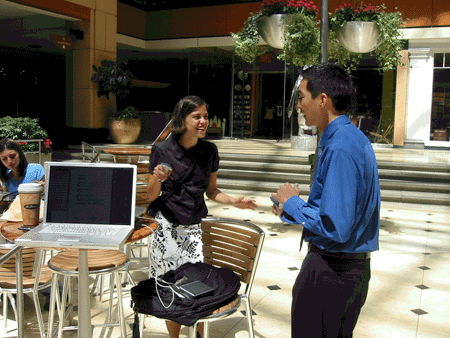
Interventions into Public Space
Rock N' Scroll by Annina Rüst is a software infrastructure for interventions into wifi-equipped public space.
"Imagine walking into a coffee shop or another semi-public wifi-equipped place where people normally congregate quietly with their laptops: instead of working unbudgingly on their computers, they are shaking their office equipment and wildly tapping their cell phones.
Both mobile phones and computers are connected using Skype VOIP software. This creates delay effects depending on how good the network connection is. The sound itself is a combination of standard macintosh and windows sounds, as well as sounds that included in the Skype software, and pre-made drumloops.
Check out pictures and videos here. [blogged by emily on textually.org]
Posted by jo at 11:43 AM | Comments (0)
January 18, 2007
Second Life Left Unity
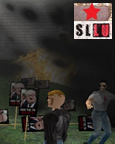
Real Life Fascist Group Recruiting Inworld
"While [Second Life Left Unity] SLLU welcomes the decision of the [Front National] FN to move from Porcupine, this has been to the detriment of the residents of Axel (another PG area). It has broken their peace and tranquility. This fascist group – one so abhorrent that the mainstream conservative party in France urged its supporters to vote socialist in order to ensure the FN didn’t reach any where near to victory in their last elections – has set up recruiting in world. This group is a RL fascist group with links to the very founders of fascism.
SLLU, also condemn this racist party for using SL as a place to recruit - the dissemination of discrimatory racist hate propaganda should be viewed as a violation of SL's community standards' We call on Axel residents to complain about this cabal and their sullying of the tranquil and beautiful area that was once Axel, and join our campaign to rid SL of racism. SLLU support residents in their wish to rid themselves of this group and the protests that have followed. SLLU can promise residents that our organization has no want to stay in Axel any longer than it takes to rid residents of the FN (who are at present trying to buy more Axel land). We reiterate our call on the Lindens to ban this group from PG areas." [via SLLU]
Posted by jo at 04:22 PM | Comments (0)
January 16, 2007
TRANSMISSION.06/mimesis
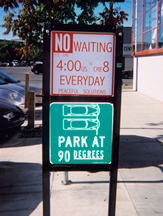
Call for Participation
TRANSMISSION.06/mimesis (tactics of mimetic intervention in everyday life) is an open call for the creation of an art archive about public interventions concerning camouflage and invisibility strategies in everyday life. This is the last part of the three year project TRANSMISSION (2004-2006), curated by progettozero(+).
This project intends to investigate the strategies and the dynamics of camouflage and likeness, of subtle sabotage and tampering: the techniques of fusion and intrusion between artistic language and daily life, media and public languages. The selected works of the archive will be proposed via web and then displayed in different locations across Europe.
You should carry out an intervention in a public/urban space (including media), using and altering the languages present in the context. These actions should attempt through mimetic strategies to render themselves invisible as art projects. These acts of "guerrilla communications" and interferences, aim to alter their contexts without being recognizable as such.
Posted by jo at 02:22 PM | Comments (0)
January 08, 2007
damali ayo
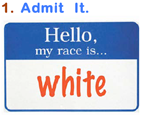
I CAN FIX IT + How to Rent a Negro
I CAN FIX IT: 2000 people were asked for 5 things individual people can do to end racism. I CAN FIX IT is a collection of our solutions in our own words. To download the guidebook click here: People are asked to post this link on blogs and everywhere you can post on the web.
The mission is to put this guide everywhere you can think of: libraries, bookstores, coffee shops, colleges, high schools, kindergartens, community gardens, street corners, on line and off line. Send it to your local paper. Send it to Oprah. Slide it into the Sunday paper or your favorite magazine while you're waiting in line at the grocery store. Send it to Michael Richards and Rosie O'Donnell. Copy and put it everywhere. Donate your office copier time to making copies, find people to print it in bulk and start getting it out there. Solutions don't work unless people have access to them. Or as one person told me- these are good ideas but the solutions happen when these ideas are actually put into action! Right on.
I CAN FIX IT is a "Now Art" project by damali ayo. More information at damaliayo.com
How to Rent a Negro is now available on iTunes: Apple iTunes LINK: click the link and your iTunes will open OR search for "damali" in the iTunes music store.
Please download the free digital booklet here, a bonus that adds depth to the album.
For those of you without iTunes, the album has been distributed to a variety of digital music services and I will let you know when it has gone live on these (raphsody, napster, etc.) The CD will be pressed in late January and will be available for purchase on CDbaby.
About the album: DAMALI AYO TURNS BOOKSTORES INTO COMEDY CLUBS with readings from her book HOW TO RENT A NEGRO. As an added bonus, ayo shares the stories behind the book about her 30 plus years as a "professional black person." Ayo showcases her trademark combination of humor and generosity that both challenges and entertains her audience. It's a whole new way to talk about race. This intimate yet playful performance is the kind of cd you'll want to give to friends, relatives, and play over and over.
damali's book is available on amazon.com and at your local Borders, Barnes and Noble, and independent book sellers.
recorded by sara lerner
produced by christos ikonomopoulos- audiofantastic.com
mastered by clark salisbury
photos by thom wallace
design by damali ayo
"Progressive art can assist people to learn not only about the objective forces at work in the society in which they live, but also about the intensely social character of their interior lives. Ultimately, it can propel people toward social emancipation." -angela davis
Posted by jo at 06:01 PM | Comments (0)
December 17, 2006
Eric Kluitenberg
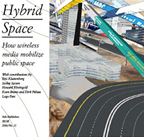
The Network of Waves: Public Agency in Hybrid Space
The Network of Waves: Public Agency in Hybrid Space by Eric Kluitenberg
The office space above which I live, in a corner house in the Indische Buurt, somewhere in Amsterdam East, used to house a local police station. At that time I was not yet living there. The place was briefly in the national news because of a fair-sized riot which took place there. A couple of Moroccan youths were brought to the station for some minor offence. Their friends thought that this was not right, so they followed the police back to the station to besiege the policemen there. It was not just a few friends who ran after the policemen, but a much larger group which suddenly turned up at the station, coming from nowhere at the precise moment when the youths were brought in. At that time this phenomenon, later known as a 'flash mob', [1] was still relatively new. The police on site were unpleasantly surprised, and had to issue a hasty call for reinforcements to negotiate with the besiegers. When it was all over a police spokesman said that it was a disgrace that the Moroccan youths had used their mobile phones to mobilize a mob. How else could these youths all have known at the same time that something was going on at which their physical presence was 'urgently desired'? And exactly where they needed to be? What the spokesman meant was that the youths had compiled mailing lists for text messages and then used texting to get together as many people as possible as quickly as possible. Texting with mailing lists was a popular application, because at that time text messages could still be sent and received free of charge.
A few years ago 'flash mobs' received a good deal of attention from the mass media. Semi-spontaneous public gatherings of groups of people, hardly if at all known to one another, nondescript, with no determining characteristics such as banners, uniform or logo, briefly performed some collective synchronous action, and then dissolved back into 'the general public'. Directions and information about the gathering were sent out by text messages, or e-mails, telling participants where, when and what. These short messages could easily be sent on to friends and acquaintances with the aim of starting a chain reaction resulting in the appearance of an unpredictably large mob at a predetermined time and place.
Reclaim the Mall!!
The 'flash-mob' phenomenon is thought by some people to have originated in a few relatively unmanageable actions in large shopping centres in American towns, disorganizing them temporarily and playfully. These actions generally had no political significance. This all changed at the end of the 1990s. The 'Reclaim the Streets' movement, [2] highly active at the time, which used to organize illegally orchestrated 'street raves' in the public spaces of large towns, made intensive use of text and e-mail address lists to organize quasi-spontaneous street parties. They did however give these street parties a layered political agenda. The parties were generally given concrete political and social themes and were linked to particular actions, such as support for a strike by London Underground staff. The movement's desire to also use these actions to free public space from its economically determined function (for instance transport, shopping or advertising) was succinctly expressed in the slogan 'The streets for people!'. The parties followed a fixed procedure. The evening before, a sound truck with a generator, a DJ kit and a large number of loudspeakers would park in a wide street. Shortly before the start a double collision would be staged at the beginning and end of the street. The crucial factor here was the provision of information for the participants, who were, in principle, unknown to the organizers. Participants therefore received a short message containing simple directions to the place, the date, the time and a few instructions, such as 'wait for the orange smoke -- that's when the rave will begin'. The double collision meant that at the agreed time the street was closed to all traffic. The cars used were fitted with smoke bombs which were set off by the mini-crash, producing enormous plumes of orange smoke, visible for miles around. This was the sign for which the 'Reclaim the Street' mob was waiting. Suddenly the street was flooded with people, sometimes more than a thousand at a time, while music began to boom from the previously parked truck or bus.
These examples demonstrate that we are living in a space in which the public is reconfigured by a multitude of media and communication networks interwoven into the social and political functions of space to form a 'hybrid space'. Traditional space is being overlaid by electronic networks such as those for mobile telephones and other wireless media. This superimposition creates a highly unstable system, uneven and constantly changing. The social phenomena which occur in this new type of space can not be properly understood without a very precise analysis of the structure of that space.
The way the Moroccan youths in Amsterdam East used text message address lists to mobilize themselves rapidly and effectively against what they saw as unjustified police violence provides an interesting example of a social group which finds itself in a socially segregated and stigmatized position appropriating a newly available technology. Mobilization was possible because at that time real-time mobile communication (texting) was available essentially free of charge. Shortly after that incident, texting became a paid service, though the reasons for this were economic rather than political, and its use for this purpose quickly lost popularity. It was simply too expensive to send so many messages at the same time. The specific relationship between time, space and technology, and to a lesser extent simple economics, determined the way in which this social phenomenon manifested itself. More than e-mails, which almost always have to be downloaded from a terminal or laptop (e-mailing on a mobile telephone is extremely laborious and inefficient), the brief phase during which text messaging served as a free public medium provided an important indicator to a changing relationship in the use and organization of public space. The mobility and immediacy of the medium gave birth to new social morphologies, like the 'flash mob', which still seem mostly to indicate a kind of mobile 'just-in-time-community' in physical public space.
The Place of Flows...
The question here is what this new kind of social morphology might mean. What lies behind the gimmick? What social, economic and technological transformations give rise to new phenomena of this kind?
So far the most important sociological theory about this is set out in Manuel Castells' Rise of the Network Society, the first part of his trilogy on the information age. [3] In it he describes the rise of flexible social network connections which resulted from economic and social transformations in late industrial societies and were strengthened by the introduction and wide application of new technology, primarily communication and information technology. Castells postulates that the network has become the dominant form in a new type of society that he calls the network society. He treats the influence of the network form as a social organization in physical and social space and establishes a new kind of dichotomy. According to Castells there are two opposing types of spatial logic, the logic of material places and locations (the 'space of place') and the logic of intangible flows of information, communication, services and capital (the 'space of flows'). [4]
The particularly striking thing about Castells' theory is the strict separation between the two kinds of spatial logic. Whereas the space of places and locations is clearly localized and associated with local history, tradition and memory, Castells sees the space of flows as essentially ahistorical, location-free and continuous. This last mainly because it moves across every time zone and so in some sense is not only location-free but also timeless. [5] Castells believes there is a fundamental asymmetry between the two kinds of space: while the vast majority of the world's inhabitants live, dwell and work in the space of places and locations, the dominant economic political, social and ultimately also cultural functions are increasingly shifting to the place of flows, where they make possible location-free ahistorical network connections, international trends, power complexes and capital movements. Only a very small part of the world population is represented in the bodies which take decisions about the organization and use of new location-free spatial connections. But increasingly the decisions made within such self-contained systems determine the living conditions in those places and locations where the vast majority of the world population attempt to survive and where their knowledge, experience and memory is localized. Castells feels that it is not surprising that political, social and cultural bridges need to be deliberately built between the two spatial dynamics, to avoid society's collapse into insoluble schizophrenia.
The attractive thing about Castells' theory is that it makes it possible to grasp and clarify a multiplicity of asymmetric social developments in a single image -- an image that has certainly not left popular culture unmoved. At the same time Castells' suggested contrast between physical locations and places and the intangible space of flows is misleading and ultimately even counterproductive for his political agenda: the deliberate building of bridges between physical space and informational space. Instead of a strict separation between physical space and informational space, all technological and social trends clearly indicate that these two 'spheres' are becoming more and more closely interwoven. A generic model of the sort suggested by Castells is totally unsuited to the analysis of this closeness and to gaining an understanding of how possibilities for public and private action come about within it, the central question posed in the present issue of Open. What threats to the autonomy and inviolability of the subject, the group, the community or cultural self-determination could possibly manifest themselves here and how can something be done about those threats?
Hybrid Space as a Polymorphous Concept
Against the placelessness and continuity of Castells' ahistorical 'space of flows' stands the discontinuity and multiplicity of hybrid space. The hybridity of this spatial concept refers not only to the stratified nature of physical space and the electronic communication networks it contains, but every bit as much to the discontinuity of the 'connectivity' or degree of connection between the multiplicity of communication networks. After all, even the universal presence of a telephone connection can not be taken for granted. More important still is the connection between local social and electronic networks: who communicates with whom, and in what context, is determined differently from one region to another, sometimes even from one day to the next. Because the space of electronic communication is rooted in local networks, it is also linked with local history. And questions about who controls electronic space or becomes familiar with electronic space are by no means easy to answer. Ravi Sundaram for example, co-founder of the Sarai new media initiative in Delhi, is constantly drawing attention to the coming into being of what he calls 'electronic pirate-modernity', [6] which comes about when local groups or individuals, illegitimately and without permission, gain access to television, telephone or the Internet -- 'Never ask permission, just appear!'.
Hybrid space is never exclusively local, as in the case of the idyllic hippy commune at the beginning of the 1970s. Small local networks, hacked or not, never remain limited to the local bazaar or the vegetable market in the next village. Local networks interweave with the international networks into which they force their way. Thus, says Saskia Sassen, the local is reconstituted as a micro-environment with a worldwide reach. Free-software geniuses in Sao Paulo's favelas find no difficulty in downloading the results of the latest interchange between the Amsterdam Waag (the Society for Old and New Media) and the Alternative Law Forum in Bangalore, but nobody pulls his or her local roots out of the ground.
Diktat of Visibility
The thing that strikes one about current discussion and the associated criticism of the rise of electronic media in public space is the preoccupation with the visual forms in which these media manifest themselves, such as screens, projections and electronic tagging. [7] It is a sort of extended visual criticism, closely connected with a tradition which assumes that the visual arrangement of observable reality is a necessary precondition for any ability to exercise power over that reality. However, the thing that stands in the way of this preoccupation with the visual is a critical analysis of the more invisible processes which are rearranging public space and imposing a different utilization logic. Relatively invisible forms of social compulsion, which bring these processes into play, may well have a much greater significance for the way in which public space can and may be used in future.
The concept of the perfect visual arrangement, expressing a social reality in which power structures are completely unambiguous and transparent, still always refers to Alberti's 'legitimate construction' and Piero della Francesca's ideal city, both of which reflect a visual articulation of daily life suggesting that everything, social and public, is completely controllable and constructible. Although the unifying point of view of a linear perspective has long been rejected, the street screens still stipulate for us a single perspective: a correct viewing distance and direction, while social relationships are radically altered.
The street screen is also the embodiment of spectacle in its most repressive form. Today spectacle is no longer alone in controlling the inner life, the interior of the alienation of the average TV junkie. The street, the classic stage of modern theatre, is overloaded with marching electronic screens and projections, so erasing the public functions of open space. Public functions become blurred by the flow of light and images drenching us in a fetish of alienating desires as we follow our necessary route through the city, from A to B.
Limitations of the Screen
Another point of criticism of the new urban visuality is its inherent limitation. Virtually every screen is rectangular and flat and has limited resolution (the number of pixels which determine the quality of the image). Media artists recognized these limitations years ago and have, with varying degrees of success, developed a multitude of strategies to attempt to overcome those limitations by, for example, a spatial type of installation, interactive media in which the screen itself also becomes an object capable of being moved and manipulated, projection on walls, fabrics, curved screens, screens that are not rectangular, [8] mirrored projections, moving projections, projections on glass materials and so on. Some artists, as for example the members of the Knowbotic Research collective, even leave out screens entirely, replacing them by new haptic interfaces and stereoscopic helmets from the Virtual Reality research laboratory or, as during the 1996 Dutch Electronic Art Festival, an installation on the roof of the Netherlands Architecture Institute, where network manipulations translated into sound and stroboscopic light. [9] Yet another example of the movement to bypass the screen is the Xchange network, in which artists collectively explore the sonic dimension of the Internet. [10]
The new generation of media-architects can learn from media art that the screen is ultimately a dead end. It is interesting to see how these attempts at iconographic liberation keep on recurring. Avant-garde painters carried out endless experiments in their attempts to break away from the frame of the painting and the surface of the canvas, their ultimate aim being to announce the death of the 'retinal' object. This same death announcement is repeated by today's media artists, but this time in relation to the screen. Media architecture again venerates the screen as a window on a space first seen as boundless, but later recognized as being largely subject to limitations and conventions.
Ultimately the screen dissolves into the architecture, becoming less a screen than a membrane between physical and medial reality. Here the 'image' functions less and less as an autonomous object, but increasingly coincides with the architecture itself, its skin, its inner life and its internal processes, finally disappearing from the consciousness of the user of that architecture. The image ecomes subliminal, 'vernacular', commonplace, merged with the environment, self-evident -- in the end the spectacle neutralizes itself. Media theorist Lev Manovich was still positive about this new medially enhanced architecture in his essay entitled The Poetics of Augmented Space, that had Learning from Prada as subtitle and was based on the success of Koolhaas's creation. [11] By now we know that the concept has failed completely, screens have disappeared from the scene or have been cut back to a minimum. The lesson of Prada is that the strategy of visibility can quickly turn into its opposite.
The Problem of Invisibility
In the present phase, the most important change in computer technology and its applications is that they are steadily beginning to withdraw themselves from sight. The European Union has for some years now been subsidizing a wide-ranging programme of multidisciplinary research and discussion with the remarkable title The Disappearing Computer. This title alludes less to the disappearance of computer technology than to its ongoing miniaturization and the way that it is beginning to turn up everywhere. The programme is investigating the migration of electronic network technology into every kind of object, to built environments and even to living beings. The thesis is that miniaturization and steadily reducing production costs are making it simpler to provide all kinds of objects with simple electronic functions (chips containing information, tags that can send or receive signals, identification chips and specialized functions in everyday objects). This is more efficient than building ever more complex pieces of multifunctional apparatus and mean the abandonment of the old idea of the computer as a universal machine capable of performing every conceivable function. [12] In fact, this is how technology becomes invisible. A decisive step, with dramatic consequences for the way people think about and deal with spatial processes.
This assimilation of computer technology in the environment introduces a new issue: the problem of invisibility. When technology becomes invisible, it disappears from people's awareness. The environment is no longer perceived as a technological construct, making it difficult to discuss the effects of technology.
Lev Manovich speaks of 'augmented space', a space enriched with technology, which only becomes activated when a specific function is required. [13] Wireless transmitters and receivers play a crucial role in such enriched spaces. Objects are directly linked with portable media. Chips are incorporated into identity cards and clothing. Even one's shopping is automatically registered by sensors. Screens and information systems are switched on remotely, by a simple wave of the hand. Miniaturization, remote control and particularly the mass production of radio frequency identification (RFID) tags is bringing the age-old technological fantasy of a quasi-intelligent, responsive environment within reach of digital engineers.
Of course these applications are not exclusively neutral. Combinations of technologies of the sort described above make it amazingly simple to introduce new and infinitely differentiated regimes for the control of public and private space. The application to public transport of RFID smart cards, which automatically determine the distance travelled, the fare and the credit balance, still sounds relatively harmless. Fitting household pets with an identity chip the size of a grain of rice, inserted under the skin, has become widespread practice. Indeed most health insurance schemes for household pets prescribe the insertion of such chips as an entry condition. Recently, however, first reports have turned up of security firms in the United States which provide their employees with subcutaneous chips allowing them to move through secure buildings without the use of keys or smart cards. Such systems also allow companies to compile a specific profile for each individual employee specifying those parts of the building or object to which the employer has (or is denied) access, and at what times
It is not difficult to extrapolate these practices to society as a whole. Who has the initiative in such matters? If the initiative lies exclusively with the constructors, the producers of these augmented spaces, and their clients, then the space we are living in is liable to total authoritarian control, even if there is no immediately observable way in which that space displays the historic characteristics of authoritarianism. The more widely the initiative is distributed between producers and consumers and the more decision-making is transferred the 'nodes' (the extremities of the network, occupied by the users) instead of at the 'hubs' (junctions in the network), the more chance there is of a space in which the sovereign subject is able to shape his or her own autonomy. The articulation of subjectivity in the network of waves is also an opportunity for the last remnants of autonomy to manifest themselves.
The Strategic Issue: 'Agency' in Hybrid Spaces
The concept of 'agency' is difficult to interpret, but literally combines action, mediation and power. It is not surprising therefore, to find it applied as a strategic instrument for dealing with questions about the ongoing hybridization of public and private space. Unlike Michel de Certeau's tactical acts of spatial resistance to the dominant utilitarian logic of urban space in particular, the action of this instrument in new ('augmented') hybrid spaces has mainly strategic significance. A tactical act of spatial resistance, which is after all no more than temporary, is hardly comforting to anyone faced by such an infinitely diversified and adaptive system of spatial control. New hybrid spaces must be deliberately 'designed' to create free spaces within which the subject can withdraw himself, temporarily, from spatial determination. Given the power politics and the enormous strategic and economic interests involved, and the associated demands for security and control, it is clear that these free spaces will not come about by themselves or as a matter of course. I would therefore like to suggest a number of strategies to give some chance of success to the creation of such spaces
Public visibility: 'maps and counter-maps', tactical cartography
The problem of the invisibility of the countless networks penetrating public and private space is ultimately insoluble. What can be done, however, is to remake them in a local and visible form, in such a way that they remain in the public eye and in the public consciousness. This strategy can be expressed in 'tactical cartography', using the tools of the network of waves (gps, Wi-Fi, 3G, etcetera) to lay bare its authoritarian structure. An aesthetic interpretation of these structures increases the sensitivity of the observer to the 'invisible' presence of these networks.
Disconnectivity
Emphasis is always placed on the right and desire to be connected. However, in future it may be more important to have the right and power to be shut out, to have the option, for a longer or shorter time, to be disconnected from the network of waves.
Sabotage
Deliberately undermining the system, damaging the infrastructure, disruption and sabotage are always available as ways of giving resistance concrete form. Such measures will, however, always provoke countermeasures, so that ultimately the authoritarian structure of a dystopian hybrid space is more likely to be strengthened and perpetuated than to be thrown open to any form of autonomy.
Legal provisions, prohibitions
In the post-ideological stage of Western society it seems that the laws and rights used to legalize matters provide the only credible source of social justification. But because a system of legal rules runs counter to the sovereignty of the subject it can never be the embodiment of a desire for autonomy. It can, however, play a part in creating more favourable conditions.
Reduction in economic scale
New hybrid systems of spatial planning and control depend on a radical increase in economic scale in the production of its instruments of control. Thus the political choice to deliberately reduce economic scale would be an outstanding instrument to thwart this 'scaling-up' strategy. [14]
Accountability and public transparency
In the words of surveillance specialist David Lyon, 'Forget privacy, focus on accountability'. It would be naive to assume that the tendencies described above can easily be reversed, even with political will and support from public opinion. A strategy of insisting on the accountability of constructors and clients of these new systems of spatial and social control could lead to usable results in the shorter term.
Deliberate violation of an imposed spatial program
Civil disobedience is another effective strategy, especially if it can be orchestrated on a massive scale. Unlike sabotage, the aim here is not to disorganize or damage systems of control, but simply to make them ineffective by massively ignoring them. After all, the public interest is the interest of everyone, and no other interest weighs more heavily. [15]
The formation of new social and political actors -- public action 'Agency', the power to act, means taking action in some concrete form. The complexity of the new hybrid spatial and technological regimes makes it appear that the idea of action is in fact an absurdity. However, new social and political players manifest themselves in public space by the special way they act, by clustering, by displaying recognizable visuality, by marking their 'presence' vis-a-vis (the) other(s).
The manifestation of concrete action by new social and political actors in public space is 'gesture'. The action, in this case, is the way the space is used, though there is still a difference between the use of a space and more or less public actions in that space. The use of space becomes agency when that use takes on a strategic form.
Notes:
1. For a description, see http://en.wikipedia.org/wiki/flashmob.
2. Reclaim the streets website http://rts.gn.apc.org/.
3. Manuel Castells, The Rise of the Network Society (Oxford: Blackwell Publishers, 1996).
4. Ibid.
5. Consider for example the concept of the 24-hour economy.
6. 'Electronic pirate modernity': see also www.sarai.net.
7. See also www.urbanscreens.org or the Logo Parc symposium held in Amsterdam on 16 November 2005, a cooperative project undertaken by the Jan van Eyck Academy, the Premsela Foundation and the Art and Public Space Lectureship (Rietveld Academy and the University of
Amsterdam).
8. These 'shaped screens' do incidentally form a curious counterpart to Frank Stella's Shaped Canvasses.
9. Anonymous Muttering: http://www.khm.de/people/krcf/AM/.
10. Website of the Xchange network, http://xchange.re-lab.net. 11. Lev Manovich, The Poetics of Augmented Space: Learning from Prada (2002), see www.manovich.net
12. The so-called Turing Machine, named after the mathematician Allan Turing -- the machine that is capable of simulating any other machine.
13. Manovich, The Poetics of Augmented Space, op. cit. (note 11).
14. The mass production of RFID (radio frequency identification) tags compelled producers to minimize the security provisions incorporated to allow the tags to be applied cost effectively to virtually any conceivable consumer product. A policy of giving priority to the safety and reliability of the chips and the information stored on them would make them much too expensive, restricting their development to specialized 'niche' markets.
15. Examples of a new kind of civil disobedience include deactivating RFID tags with the aid of an adapted mobile phone, hindering the operation of smart cards, regularly swapping client cards, deliberately supplying false information when registering online and using 'anonymizers' on the Internet, 'encrypted' (coded) mobile phones and local gsm blockers.
This essay was written for the new issue of Open (#11), cahier about art and the public domain - "Hybrid Space". The essay introduces the overall theme of the issue, and suggests some strategic considerations on the use of hybrid space.
More information on the issue can be found at the website of NAi Publishers:
http://www.naipublishers.nl/art/open11_e.html
and at the website of Open:
http://www.opencahier.nl
The journal was presented at De Balie, Centre for Culture and Politics in Amsterdam, on November 18, with the annual SKOR lecture, delivered this year by Saskia Sassen: "Public Interventions - The Shifting Meaning of the Urban Condition". The lecture is available on-line at: http://www.debalie.nl/terugkijken See also: http://www.debalie.nl/artikel.jsp?podiumid=media&articleid=85601 [via nettime]
Posted by jo at 06:19 PM | Comments (0)
December 07, 2006
Homeless kid in Second Life
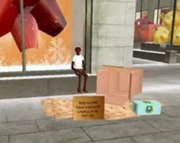
Help a child have a second oportunity in his First Life
Cory Doctorow: Alex sez, "From December 4 on, the Spain-based NGO Mensajeros de la Paz will be present in the virtual world of Second Life as a homeless teenager avatar named MensajerosDeLaPaz Jubilee. The kid hasn't any land nor properties, except for a cardboard box, some newspapers and a sign that says: 'Help a child have a second oportunity in his First Life.'"
"The action is intended to reach out for young people, and ask for help for abandoned and abused children in developing countries in South America and Africa," says Ana de la Calle, a communications representative of the organization.
"We think Second Life and other forms of new technologies can be a great way to connect with young people and make them a little more conscious about the huge population in the real world needing help, and it doesn't cost much to guarantee the future of another human being", says Salvador Dinez, art director of the ad agency ArnoldFuel and one of the designers of the project. The action also includes getting broadcasting online videos of the reaction of the Residents. Link [via Boing Boing]
Posted by jo at 08:30 AM | Comments (0)
November 25, 2006
Buy Nothing Day
"Every November, for 24 hours, we remember that no one was born to shop. If you’ve never taken part in Buy Nothing Day, or if you’ve taken part in the past but haven’t really committed to doing it again, consider this: 2006 will go down as the year in which mainstream dialogue about global warming finally reached its critical mass. What better way to bring the Year of Global Warming to a close than to point in the direction of real alternatives to the unbridled consumption that has created this quagmire?"
Posted by jo at 08:44 AM | Comments (0)
November 22, 2006
Amazon Noir
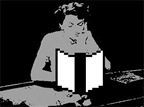
The Big Book Crime, Out of court settlement
Hot news from the Amazon Noir – The Big Book Crime project!.
The plot: The Bad Guys (The Amazon Noir Crew: Paolo Cirio, Alessandro Ludovico, Lizvlx and Hans Bernhard) stole copyrighted books from Amazon by using sophisticated robot-perversion-technology coded by Paolo Cirio. A media fight and a legal dispute escalated into an online showdown with the heist of over 3000 books at the center of the story.
The technology: The Amazon Noir Robots (Sucker01-12) tricked around with Amazon Search Inside the Book function until it gave away the complete volumes of copyright protected books. This was carried out by sending 5.000 - 10.000 requests per book. After this process the data was logically reassembled into pdf-format by the SIB-Book-Generator (see the diagram.)
Amazon Noir was scripted as an internet-movie. The whole digital action (media hack) was carried out in the global massmedia, within the art world and on a highly sophisticated technical level in the clandestine matrix of our global networks.
Amazon USA, U.K., Germany and France were vulnerable targets. During the attack they transformed part of the Search Inside the Book technology to defend the rights of the copyright holders - without actually solving the problem. Over 3000 Books were downloaded and distributed through p2p between April and October 2006.
The end? In July 2006 Amazon France and Amazon USA threatend to litigate. The matter was resolved out of court October 30th, 2006. Amazon (USA/France) bought the Amazon Noir software for an undisclosed sum - both parties signed a non-disclosure agreement.
Previous posts: The Big Book Crime and Interview with Ubermorgen. [blogged by Regine on we-make-money-not-art]
Posted by jo at 10:06 AM | Comments (0)
November 13, 2006
Saskia Sassen
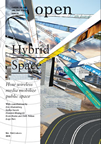
Essay and Lecture
Open 11 :: Hybrid Space: The influence of digital technologies on the use of the public domain :: Thanks to new wireless technologies (WIFI, GPS, RFID) and mobile media, public space is subject to drastic changes. It is being traversed by electronic infrastructures and networks, and alternative cultural and social domains are evolving, though often invisible from a conventional viewpoint. The traditional physical and social conditions of the public domain are being supplanted by zones, places and subcultures that transcend the local and interlink with translocal and global processes. The question is whether there are also new opportunities for the individual and for groups to act, participate and intervene publicly in this hybrid, seemingly flexible space. How do people appropriate the new public spaces? Where does the 'public' take place in this day and age? Who shapes and moulds it by devising spatial, cultural and political strategies?
With contributions by Drew Hemment, Howard Rheingold, Saskia Sassen, Frans Vogelaar/Elizabeth Sikiardi, Noortje Marres, Koen Brams/Dirk Pultau, Marion Hamm, Kristina Andersen, Ari Altena, Daniel van der Velden, Klaas Kuitenbrouwer, Esther Polak, De Geuzen and Max Bruinsma. Guest editor: Eric Kluitenberg, Jorinde Seijdel and Liesbeth Melis (eds.)
Public Interventions: The Shifting Meaning of the Urban Condition by Saskia Sassen :: De Balie, Amsterdam :: Saturday, November 18, 2006 :: Start: 20.30 hrs (CET) :: Live-stream webcast.
This year’s SKOR lecture (Fourndation for Art and Public Space) is delivered by Saskia Sassen, who will talk about the ‘making’ of public space by means of architectural and artistic interventions. The evening includes the presentation of Open 11, which takes hybrid space as its theme and includes an essay contributed by Sassen.
Human experience is threatened by the massive architecture of world cities and the density of infrastructures – digital and otherwise – that exist to serve international capital and the global economy. Sassen argues that there is a need for the production of subversive narratives as a counterbalance to this, to make the local and what has been silenced manifest and to generate new forms of ‘modest public spaces’.
Saskia Sassen is Ralph Lewis Professor of Sociology at the University of Chicago and Professor at the London School of Economics. She has gained worldwide acclaim for studies such as The Global City and Cities in a World Economy. Her most recent publication is Territory, Authority, Rights: From Medieval to Global Assemblages (Princeton University Press, 2006).
Panelists: Arnold Reijndorp, urban sociologist; Willem van Weelden, artist and theorist; Moderator: Bahram Sadeghi
Language: English
Organised by: SKOR / Open / De Balie
SKOR is the Netherlands Foundation for Art and Public Space.
Open, a cahier about art and the public domain, is published twice a year by NAi Publishers in association with skor.
ADDRESS: De Balie, Kleine Gartmanplantsoen 10, Amsterdam.
RESERVATIONS: De Balie t 020-5535100, or via >>
Admission: 12,50 (students: 7,50)
Posted by jo at 02:24 PM | Comments (0)
November 02, 2006
Institute for Infinitely Small Things
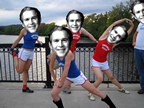
Impeach Bush Jogging Circus
The Impeach Bush Jogging Circus :: When :: Sunday, November 5th around 12 noon but probably a little later :: Where :: Around Mile 17 (1st & 66th St, Manhattan) of the NYC Marathon.
Our friends at the Impeach Bush Jogging Circus bring you a mobile carnival dedicated to acts of wonder, entertainment and astonishment all accomplished while moving approximately 7 miles per hour and doing cartwheels for a GWB-Free USA. Jugglers, Joggers, Clowns, Hula Hoopers and a 10+piece jogging kazoo band are running the NYC Marathon as a team on Nov 5th, 2006. Bring IMPEACH BUSH signs and wear red, white and blue to show your support for the legal case against George W. Bush.
Be our friend, Buy our stuff: Visit the circus' myspace page for pictures and fashionable athletic wear. Join in: Can you juggle and jog or flip and skip? Email the circus at theimpeachbushjoggingcircus[at]gmail.com.
The Institute for Infinitely Small Things is a research organization whose mission is to invent and distribute new practices of political engagement in everyday life. Current research interests include: performing corporate language in public space, creating definitions of cartography, destabilizing consumer architectures, hacking maps and lying to people about art.
iKatun's mission is to present and support contemporary art that fosters public engagement in the politics of everyday information. To realize this mission, iKatun supports art projects, organizes exhibitions and conferences, publishes critical writing, runs workshops, gives lectures and fosters community locally and internationally. iKatun is a 501(c)3 organization based in Boston, MA.
Posted by jo at 03:03 PM | Comments (0)
October 19, 2006
Ethan Zuckerman

Tracking Hasan Elahi
Hasan Elahi is a conceptual artist whose life is an ongoing work about surveillance. He starts by telling us a chilling story - his detention by the INS at Detroit Airport after returning from a trip from overseas. An immigration officer scanned his passport and blanched, then led Alahi through a maze under the airport to an INS detention facility. As a US citizen, this was pretty odd - he tried to talk with the guards to figure out what was going on. But it all became clearer when the man from the FBI in the dark suit came to talk with him.
The FBI asked him about his whereabouts on September 12, 2001 - he was able to answer the questions by taking out his Blackberry and showing off his meetings. Over the course of questioning, it became clear that the reason he was being questioned was that he had a storage locker in Tampa, where he’d been teaching. Scared by 9/11, the owners of the storage area reported that “an Arab man had fled on 9/12, leaving explosives in his locker.” There were, of course, no explosives, and he hadn’t fled - just the detritus of ordinary life.
Elahi’s life for the next few months involved dozens of interviews with the FBI, finally culminating in nine back to back polygraphs, which finally “cleared” him. He explains that the power dynamic of an FBI interview leads to a very human response - the desire for survival. Elahi says that he could have questioned the legality of the experience, hiring a lawyer… but he realized that there was the possibility that any act of resistance could have gotten him sent to Guantanamo.
For the next few months, every trip Elahi took, he’d call his FBI agent and give the routing, so he didn’t get detained along the way. He realized, after a point - why just tell the FBI - why not tell everyone?
So he hacked his cellphone into a tracking bracelet which he wears on his ankle, reporting his movements on a map - log onto his site and you can see that he’s in Camden. But he’s gone further, trying to document his life in a series of photos: the airports he passes through, the meals he eats, the bathrooms he uses. The result is a photographic record of his daily life which would be very hard to falsify. We all know photos can be digitally altered… but altering as many photos as Elahi puts online would require a whole team trying to build this alternative path through the world.
Elahi also puts other apsects of his life online, including his banking records. This gives a record of his purchases, which complements the photographs. He doesn’t put the phone records online, because it would compromise the privacy of the people he talks with, and some friends have asked him to stop visiting, but he views the self-surveillance both as an art form and as his perpetual alibi for the next time the FBI questions him.
At the same time, he’s stretching the limits of surveillance systems, taking advantage of non-places. He flew to Singapore for four days and never left the airport, never clearing customs. For four days, he was noplace - he’d fallen off the map, which is precisely what the FBI and others worry about. But he documented every noodle and every toilet along the way.
One of the audience questions asks whether the FBI actually threatened Elahi with Guantanamo, or whether his “artistic temperment” might have exaggerated the seriousness of the situation. Elahi explains that it was never made concrete, but that he certainly felt the threat of indefinite detention, and that he believes the only thing that saved him was a common culture - the ability to quote the lyrics of country songs, or talk about college football, the sort of things a terrorist would find very hard to fake.
Another questioner wonders if Marianne Weems will make a show about Elahi - she mentions that an earlier piece, “Jet Lag”, tells the true story of a woman who flies from Amsterdam to NYC 167 times, again and again, until she dies of jetlag. (Still trying to find a reference to this story…) Given that Elahi’s life involves all the issues Weems is most interested in, she admits that a piece based on his experiences would be irresistable. [posted by Ethan Zuckerman on World Changing]
Posted by jo at 09:51 AM | Comments (0)
October 14, 2006
Riot Gear for Rollartista
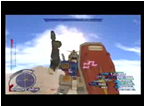
An Action Dedicated to African/Muslim Immigrants
Riot Gear for Rollartista: a blog and mobile gaming performance project by Anne-Marie Schleiner and Talice Lee. This blog is for posting information about a performance action we are doing in Castellon Spain on Saturday October 21, 2006 as part of an exhibition at EACC Espai d'Art Contemporani de Castell from October-January 2007. It will involve three short Machinima (stories told with video game footage) videos that will be beamed from an ultra-light projector stapped to one of our head helmets. (The videos are now linked from the blog to YouTube.) We sampled the two Playstation games Narc and MechWarrior. It sort of evolved into a violent (break) dance musical and each video is dedicated to an African or Muslim immigrant who was seriously abused by police in Spain or France. We, two American women in padded anime/riot gear/something else inspired moda, will be holding Playstation controllers and rollerskating at the same time, (and sometimes dancing), while we coast around projecting onto surfaces of the city.
After the performance/action we will also post documentation videos and photos on the blog.
Posted by jo at 01:01 PM | Comments (0)
October 07, 2006
Unofficial Off-Site Rhizome 10 Year Group Show and Idiosyncratic Link Party
"In the sprit of net art that once was and could be again, I’d like to again anouce the “Unofficial Off-Site Rhizome 10 Year Group Show and Idiosyncratic Link Party”. How can you get in on this historic event? 1.) Make some Net Art this year. 2.) Post the URL on Rhizome or just email it to me. 3.) If I like it, I’m posting it at http://del.icio.us/m.river . 4.) At the end of the year, I’ll make a homepage for the show. 5.) If you don’t like what I’m selecting, you can make your own “Unofficial Off-Site Rhizome 10 Year Group Show and Idiosyncratic Link Party.” Hell, if you make a better site, I’ll give you credit for the idea. Pirate an anniversary show. It’s easy. It’s fun. It’s totally net art."
M. River
Posted by luis at 11:07 AM | Comments (0)
October 04, 2006
The Dirk Pereres Archive
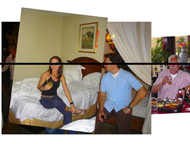
Online file gathering
Downloading and sharing music, films, software and other data is usually done by means of peer-to-peer (p2p) networks. p2p software like Limewire and Acquisition offer the possibility to share specified documents on computers with other users, who have access to the data through an Internet connection.
Many users do not use the right settings in these exchange programmes, causing far more data to be accessible than originally planned. In this way, a lot of ‘sensitive’ information is being unconsciously offered.
Dirk Pereres spent a year gathering keywords, application letters, bank information, scanned passports, photo and video material, and so on. This resulted in the so-called Dirk Pereres Archive. The ‘found footage’-material was used to design amongst others posters and films.
Pereres states: “It’s an interesting collection that should be seen by everyone. Because: You’re telling Dirk! It was immediately clear to me that a high level of discretion was needed… Therefore, my design always strives to create or restore anonimity”.
The Dirk Pereres Archive will be presented at <>TAG The Hague from October 7th till October 28th. Check out: http://www.tag004.nl for more information about the presentation of The Dirk Pereres Project and http://www.dirkpereres.org for details on the project.
Posted by luis at 12:56 PM | Comments (0)
An ordinary building
![]()
UNUSUAL SIGN APPEARED OVERNIGHT CAUSES CONTROVERSY
On the night of September the 20th 2006 a sign appeared on a building in the center of Viterbo, an ancient city in central Italy, not far from Rome. Apparently put by the City Council it has already caused quite a stir. The sign is in fact an art piece by controversial artist duo Eva and Franco Mattes (aka 0100101110101101.ORG). Looking as official as any other street sign, it reads:
An Ordinary Building: This building was designed by an unknown architect in an irrelevant epoch and never belonged to an important person. The complex does not show any original architectural solutions, nor does it conserve any important works of art within. No memory is kept of any significant historical events occurring on this site. No known personality was born, lived or died here, nor is any excellent artist or sublime poet still working here.
Hundreds of unaware passersby have been staring at the sign: "It's brilliant!" comments an elderly woman "But I have no idea how to interpret it". While an outraged citizen living nearby comments "This is just unacceptable, look around, there are buildings much worse than this one, especially in the suburbs".
When asked to give an explanation of the sign, Franco Mattes, currently in New York, declared "It means what it says".
Italian curator Claudio Zecchi, who commissioned the work, comments: "This piece has a strong provocative nature like all their previous ones. The ideal stage for their art is not the official places where artworks get recognition and celebration like galleries and museums, but the city itself. It is only there that they can obtain the most genuine reaction".
The artists plan to leave the sign on the building until mid October, but whether or not the City Council and citizens will allow this, is an open question.
"History is not given" adds Eva Mattes "it has to be constructed, it's pure fiction, like in a novel".
The Mattes are not new to this kind of interventions. Over the last decade they drawn worldwide acclaim - and contempt - for producing some of the most paradoxical artworks ever, including staging a hoax involving a completely made-up artist, challenging and defeating Nike Corporation in a legal battle for a fake advertisement campaign and inventing ‘United We Stand', a non-existent Hollywood-style blockbuster.
Info and contacts:
http://www.0100101110101101.org
Downloadable images:
http://www.0100101110101101.ORG/download/ordinary.html
Posted by luis at 12:35 PM | Comments (0)
September 29, 2006
Gustavo Romano
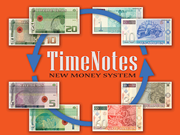
Time Notes
Time Notes :: EXCHANGE OFFICE :: Orchard Road, Singapore :: The action starts with a stand in Orchard Road (in front of the major Shopping Mall of the city) where two persons ask the passing people what do they think about the new Time Notes money system, and invite them to exchange a bill with something that they think it is worth.
"Gustavo Romano employs actions, videos and Internet projects in order to subvert and dismantle a naturalized perception of everyday occurrences. As opposed to the modern pretension that the time and space we inhabit is unique and homogeneous, Romano forays into multiple, fragmented instances of time-space. His works record displacements achieved by way of optical devices (telescopes, satellite views, microscopes, x-rays or night vision), distortions of duration (by manipulating video or electronic recordings) and diverse forms of dislocating genres. In his works, the natural habit of seeing things in a single way in broken. Such is the case in pieces such as Lighting Piece , an ephemeral match that burns endlessly with an eternal flame, or in Pequeños mundos privados (Small Private Worlds), a specular proposal that—just as in La Reproduction Interdit by Magritte—,deconstructs space—Chinese boxes—as well as time—and in this circular proposition, where is the beginning and where is the end? Where is the limit between the reflection and what is being reflected?
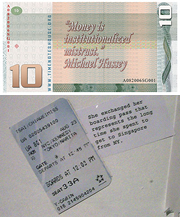
As George Simmel pointed out in the early 20th Century, all economic exchange should be understood as a form of social interaction. Others would coincide as well, from Bronislaw Malinowski (with his theory of exchange), to Marcel Mauss (in his Essai sur le don), and Claude Lévi Strauss, for whom the actions of give and take and their reciprocal nature are present in the collective unconscious of all human society. Time bills emerges from a terrain that is nourished as much by this Sociology of Exchange or Economic Anthropology as it is by a tradition of artists' interventions involving bills (from Pop to Fluxus, in particular). The work—which functions within a public space that here, is simultaneously an art space and a political space—, consists of soliciting a “commercial” exchange from passersby: What would they give in return for a bill by an artist? What are these bills worth? Their exchange value? Their use value? Their accumulation value? Are they art transformed into merchandise? Money, the bastion of modern society, symbolizes a spirit of rationality, calculability and measurability. Nevertheless, history has registered very different mechanisms for exchange. The potlatch , in North America, used to take place in the form of a ceremonial celebration, New Guinea's Kula Ring used to include magic rituals, and Hell Bank Notes are considered a monetary currency for the next life, offered up as a way of venerating ancestors, etc., etc. Furthermore, in Time Notes , the nomenclature of the bills does not refer to an abstract value but to units of time; is time money? Is it a Faustian pact to buy time—eternal life?—in exchange for something—the soul? In the face of money's ostensible impersonal value and abstract homogenization, Romano reveals a manner in which idiosyncrasies, desire and belief can persevere behind every note." -- BELEN GACHE
Posted by jo at 05:08 PM | Comments (0)
[iDC] Questioning Two Experiences with Situated Technology
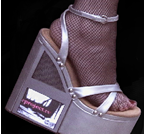
Emancipatory Technologies for the 'Marginalized'
On Sep 28, 2006, at 11:34 PM, Matthew Waxman wrote:
In what ways might situated technologies be used as a tool for activating not only the context of user-oriented perspectives but the contexts of non-user-oriented (such as service and 'marginalized') perspectives? And how might situated technologies and architectural form (both together) be able to mix or remix these different perspectives on context?
Great question, and something I've been thinking of for a while as well. I have no answers or relevant projects, but a few more ideas and questions.
(And perhaps others have touched on these points in earlier posts; like Anne I think I've likely missed relevant discussions.)
I've been wondering about the potential (and whether it even exists or not) for some of these situated and/or networked technologies being used for emancipatory situations for those 'marginalized'. Perhaps an example of what I'm thinking about. Take someone who works in a migratory situation. They may come to the US for a few months to work and then return to their families further south. [1] What options do they have for contact with their families and distant communities during these months away? Do many have cell phones? I don't know; but echoing a discussion from earlier in the summer [2], is it possible to use massively distributed transmission of messages over ad-hoc networks to get information to those who are far away geographically? Bypassing the existing infrastructure to create a transitory one that better reflects the person's needs and desires.
On another front, and related to some experiences I've had in co-curating technological fashion shows [3], what ways can we use wearable computing to focus on the needs and desires of the marginalized? Can we use miniaturization technologies to create a system of surveillance that protects the worker? That in a subversive way records illegal, dangerous, or derogatory conditions for presentation to the authorities? Perhaps we can think beyond creating garments that simply "light up in response to x from the wearer". With that said, projects such as the No-Contact Jacket by Adam Whiton and Yolita Nugent [4], the Porcupine Dress by Meejin Yoon [5], and the Aphrodite Project developed at eyebeam [6] are great examples of the potential use of this technology outside of an artistic or responsive context.
Yet what worries me even as I write this is that my suggestions don't begin to question the _situation_ itself. What is the use of ad-hoc networks to send messages if the person is still subservient to an oppressive system? Who cares if we can create the ability to record illegal actions of a land-owner if the reporting of said actions causes the worker to be harmed even further? I don't have an answer to that, and perhaps technology does not either, and perhaps even deeper, we shouldn't be asking or demanding of our technology to do all of these things. We all know situations will not drastically improve overnight, and maybe the development of stopgap measures that attempt to improve an aspect of undesirable circumstances is one thing to do while _in parallel_ we (and others) work to question, deconstruct, and reconstruct.
Finally, and to contradict my previous paragraph, perhaps there are ways to be _proactive_ instead of reactive with our development. It's a question I ask myself often, and if I had something to offer I would, but I'd be curious about others' thoughts.
nick knouf
[1] But as a recent NY Times article points out, because of immigration concerns, there is an increasing decrease in the number of workers coming to the US. (Unfortunately the article is now 'locked', but this is the URL: http://select.nytimes.com/gst/abstract.html?res=F30D17FF35550C718EDDA00894DE404482)
[2] http://mailman.thing.net/pipermail/idc/2006-July/000599.html
[3] http://seamless.sigtronica.org
[4] http://old.siggraph.org/s2006/unravel/Projects/6/
[5] http://www.bookofjoe.com/2005/05/selfdefense_dre.html
iDC -- mailing list of the Institute for Distributed Creativity:: iDC[at]bbs.thing.net :: http://mailman.thing.net/cgi-bin/mailman/listinfo/idc
List Archive: http://mailman.thing.net/pipermail/idc/
Posted by jo at 04:48 PM | Comments (0)
September 27, 2006
BIENNIAL OF THE YEAR 3000
![]()
ARTISTS AND CITIZENS TAKE POWER
FROM 5 OCTOBER TO 15 DECEMBER 2006, FRED FOREST INVITES ALL ARTISTS TO PARTICIPATE IN THE BIENNIAL OF THE YEAR 3000, A BIENNIAL IN WHICH ARTISTS AND CITIZENS TAKE POWER AND EXERCISE THEIR RIGHTS TO THE FREEDOM OF SPEECH AND THE FREEDOM OF IMAGE. YOUR PRESENCE, EITHER THROUGH IMAGES, WORDS OR BOTH, WILL BE HIGHLY SIGNIFICANT.
ACTIVELY PASS ALONG THIS PROPOSITION THROUGH ALL YOUR PERSONAL NETWORKS.
THE SUCCESS OF THIS INITIATIVE WILL ALSO BE YOUR SUCCESS AND WILL DEMONSTRATE THE CAPACITIES OF ARTISTS TO SELF-ORGANIZE AGAINST DIFFERENT CULTURAL POWERS AND THE EXISTING INDUSTRY, USING THE TOOLS OF DIGITAL COMMUNICATION AND THE INTERNET.
CONTRIBUTIONS WILL BE DISPLAYED IN A LOOP ON THE MAC IN IBIRAPUERA PARK AND UPDATED PERIODICALLY. THANK YOU FOR YOUR PARTICIPATION
BIENNIAL OF THE YEAR 3000
A BIENNIAL IN WHICH ARTISTS AND CITIZENS TAKE POWER AND EXERCISE THEIR RIGHT TO THE FREEDOM OF SPEECH AND IMAGE
The French artist, Fred Forest, Docteur d'Etat from the Sorbonne, who organized the controversial Biennial, the "Biennial of the year 2000", in 1975, under the military regime, with the support of Walter Zanini, then director of MAC--has done it again in 2006! Thirty years later, he is organizing a "Biennial of the year 3000", with the participation of Brazilian and foreign artists.
In 1973, representative artists such as, Amelia Toledo, Anesia Pacheco Chaves, Armando Canuto, Cesar Loureiro, Conrado Silva, Euclides Sandoval, Fabio Magalhães, Gilberto Moirimitto, Luiz Augusto de Aruda, Luiz Carlos Homem da Costa, Regina Celia Canel, Sergio Fuiza, participated in his Biennial.
This year Fred Forest is organizing the Biennial of the year 3000 in São Paulo from 7 October to 13 December 2006. A Biennial that breaks free from the official Biennial, because it is a digital, planetary, participatory biennial, a biennial without selection and consequently, truly democratic.
Fred Forest has always played an important role as a pioneer. In 1973, he was already involved in the creation and performance of street art, participatory art, protest art, and social art. Over thirty years later, these art forms constitute an important part of today's artistic practices given the slowness of cultural institutions to assimilate innovation. This "Biennial of the year 3000" will happen in the same places as the "Biennial of the year 2000": in the Mac USP, Ibirapuera Park.
It will affirm with strength and independence that art does not stay tied to past concepts.
It will demonstrate that in an age where the Internet is helping to abolish the concepts of time and space, and where the aesthetics of communication invades all symbolic and social dimensions, art does that remain stagnant.
The making of art is first done with our senses, and our senses are not created from obsolete concepts when the world transforms itself in real-time under our very eyes.
Annick Bureaud (annick[at]nunc.com)
tel/fax : 33/ (0)143 20 92 23
mobile : 33/ (0)6 86 77 65 76
Leonardo/Olats : http://www.olats.org
Posted by jo at 12:05 PM | Comments (0)
September 11, 2006
REMOTE

You Bring the Secret Location to Life
REMOTE--by Chris Vecchio :: 9 September – 21 October 2006* :: Gallery Joe Bird Park
3rd and Arch Streets :: Philadelphia, PA :: * viewable 24-7 * best experienced at night * (but no sound after 10PM) :: INSTRUCTIONS: 1) Get up off of the couch 2) (but bring the remote control with you) 3) Go to the south west corner of 3rd and Arch 4) Use your remote to activate the park.
REMOTE is an interactive environmental installation containing a range of sound and visual effects. Installed in an outdoor space, the installation is activated, controlled, and navigated using a common household remote control which may be supplied by the viewer. The piece takes the form of an intervention in an outdoor space, along a street or in a small park. There’s an “insider” element to the installation since, when not activated, its location may not be immediately apparent to a passerby. Additionally, the viewer needs to know to bring a remote to the location to bring the secret to life.
At the installation site, pressing buttons on any (TV, DVD, VCR, audio, etc…) remote control triggers a myriad of responses ranging from subtle (bird calls or soft sounds emanating from hidden speakers, changes in the ambient lighting) to bombastic (more dramatic sound effects, explosions, strobe lights, or projected images). Each key press generates a unique combination of effects. Viewers may bring any remote control from home to activate the installation.
Central to my work is an interest in the expressive potential of electronic devices and in the potential for user interfaces to generate new modes of interaction. A set of social precedents now exists for interaction with electrical technology. When these precedents are followed but subverted or there is no clear immediate “functional” objective, a viewer’s expectations are challenged and an opportunity for reflection or commentary on the human-technology relationship is created. This project makes use of such ambiguity – juxtaposing the familiar with the unexpected – to encourage people to question their assumptions about technology and reflect upon their interaction with it.
The piece has a strong element of accessibility. People who may be intimidated by interactive work or by technology in general may be engaged because an everyday object is the agent of action. The experience of the installation is reminiscent of a coin-op arcade shooting gallery. Play and experimentation are encouraged as part of the experience. Participants can keep trying different units from their everyday collection because each remote interacts differently with the piece. This highlights the number and variety of remotes we use for everyday tasks, from the mundane to the complex.
Sound samples in this installation have been gathered from a wide range of sources including sound effect libraries, police scanners, popular music, short wave and CB radio, and by using peer-to-peer networks to search the internet for randomly (inadvertently?) shared audio files. The broad range of sources references the instrumental use of sound samples in music as well as common (mundane) technological interactions such as channel surfing or tuning across a radio band.
Finally, the installation presents the man-technology interface ironically. The couch potato is asked to get off of the sofa and experience art first hand, but still holding the ever-present remote. Issues related to the effects of technological mediation and the degree to which technology is an atrophying rather than an empowering force are raised.
Posted by jo at 01:38 PM | Comments (0)
September 08, 2006
TANGENT_BURN featuring PLATONIQ
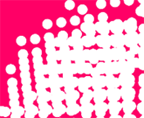
Bringing the Net Down to the Streets
TANGENT_BURN featuring PLATONIQ: This evening V2_Institute for the Unstable Media will be hosting a streamed performative presentation by Barcelona based activist art collective PLATONIQ. If you're not able to make it to V2_ in the flesh, and at the same time catch the opening of this year's 'Wereld van Witte de With' Festival, you're invited to join in on the stream beginning at 20.00 (CEST). The PLATONIQ presentation will be augmented by interventions from local Rotterdam sound and visual artists 'onehertexpressions', Zaplab Creative Television and Meticais.
To join the stream, please go to www.v2.nl, follow the link and have your Realmedia player ready! If you don't have the player, you may download one for free at www.real.com.
Afterwards PLATONIQ'S project BURNSTATION to bring net culture, net music and net radio down to the streets will be active throughout the weekend as part of the Wereld van Witte de Festival. Everyone is invited to partcipate in the BURNSTATION, and upload, listen to, edit and to burn their own sound compilations, the whole process being LEGAL AND FREE OF CHARGE.
more info on PLATONIQ and the BURNSTATION on http://www.platoniq.net
TANGENT_BURN Friday September 08
Rotterdam 20.00
Dublin 19.00
Riga 21.00
Montreal 14.00
Seattle 11.00
Kyoto 03.00 (Saturday)
V2_Institute for the Unstable Media
Stephen Kovats_Program Curator
Eendrachtsstraat 10
3012 XL Rotterdam
The Netherlands
t_ **31 10 750 1519
f_ **31 10 206 7271
e_ kovats@v2.nl
www.v2.nl
TANGENT_BURN featuring PLATONIQ
Friday September 08 @ 20.00 (CEST)
RealMedia stream live via www.v2.nl
www.platoniq.net
Posted by jo at 04:14 PM | Comments (0)
September 06, 2006
Amazon Noir

The Big Book Crime
After Google Will Eat Itself ... ubermorgen.com, Paolo Cirio and Alessandro Ludovico are working on a new "subversive happening." They plan to use the 10,000 euro stipend that Hans Bernhard received from Edith Russ Site for media art in Oldenburg (DE) to undermine the online copyright of Amazon and allow users to obtain books from Amazon for free.
Amazon Noir – The Big Book Crime, which for its action will take its cue from the "film noir" school of cinematography, intends to [point out] "the hypocrisy of the digital copyright lobby." The software bot the artists mean to deploy will be ready by this autumn. The bot will outwit Amazon's "search inside the book" system, making up to 5.000 inquiries per book and assembling the individual parts afterwards to compile entire books. This would allow "users to 'legally' copy and redistribute copyright books from amazon.com."
The piece is a performative media-installation and thus continues the historical tradition of happenings and performance art. Provoking reactions from conventional media and business is an integral part of the project.
"We will protect our rights. No information on the matter will be made public," an Amazon spokeswoman said to German news agency dpa.
Via heise, spiegel. Related: Forum IV - Net Vision: [v]ote-auction by ubermorgen.com. [blogged by Regine on we-make-money-not-art]
Posted by jo at 05:28 PM | Comments (0)
September 04, 2006
Is It True, JetBlue?
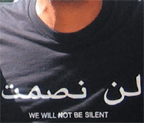
WE WILL NOT BE SILENT
Is It True, JetBlue? by Naeem Mohaiemen
"The artist says, "It's not my business." Then whose business is it? Does that mean you are going to leave the business of the most important issues in the world to the people who run the country? How stupid can we be?" [Howard Zinn, Talk @ Massachusetts College of Art, October 10, 2001]
Is It True Jet Blue? JFK? TSA? A rhetorical question that leads to a tautology. Yes, of course people racially profile the darker masses while whipping up a pervasive fear in the name of "national security." Paranoia is so essential to running the modern state, other navigation tools seem permanently broken.
After learning that Raed Jarrar was told to remove his Arabic WE WILL NOT BE SILENT t-shirt before he could board a JetBlue flight, four members of The Critical Voice (TCV) boarded a Jet Blue flight last Thursday. The four members, all white women and US citizens, were wearing the same Arabic t-shirts. They were allowed to board the flight. This is more evidence that the Raed Jarrar case is one of racial profiling and censorship.
Many of us have been helping as supporters of TCV, an affinity group of Artists Against the War (AAW). Today, after consultation with other members, Laurie of TCV went on Democracy Now and broke the story. I first met Laurie when she and other TCV members were ejected from NY Public Library's "Who's Afraid of Iran" event (w/ Shirin Neshat, et al) -- they were wearing the same t-shirts, but were ostensibly ejected for carrying political posters.
The t-shirts have now spread globally, and become an icon of popular, non violent resistance. Because of the open-ended nature of the two phrases "We" (who?) and "Will Not Be Silent" (about what?), people have appropriated these t-shirts and used their bodies to register opposition to many flanks of the "War On Terror", including invasions, fear-mongering, censorship, detention of immigrants, racial profiling of Muslims, use of African-Americans, Latinos and working-class Whites as cannon fodder, the abandonment of poor Blacks in New Orleans, and the linkages and overlaps between all these and other common struggles. To give one example, two weeks ago, many of us as members of Action Wednesday, collaborated with TCV to distribute the t-shirts at Outernational concert in Central Park, to protest the invasion of Lebanon.
Caroline Parker, Laurie Arbeiter, Susan Kingsland, Ann Shirazi and other members of TCV and AAW put into practice a new model of artists as public actors, activists and intellectuals who refuse to confine their cultural production inside gallery or museum walls.
Contra Adorno, it becomes even more essential to write "poetry" (using an expansive definition) after Auschwitz. To use the many routes of contemporary culture to dissent and to shape a new mental and actual reality.
Sandy Kaltenborn of Kanak Attac in Berlin writes, "Design Is Not Enough." Neither are t-shirts, but they are a good start. To take the carrier of such witless 1970s slogans as "Have A Nice Day", "I'm With Stupid", "Pobody's Nerfect", "Kiss Me, I'm Drunk" "My Parents Went To London And All I Got Was This Lousy T-shirt", and invert it into an act of body-based defiance is a good beginning.
At the risk of descending to repetition, I echo Adorno's sentiment:
"The only relation to art that can be sanctioned in a reality that stands under the constant threat of catastrophe is one that treats works of art with the same deadly seriousness that characterizes the world today." [“Valéry Proust Museum” in Prisms, Samuel and Shierry Weber, trans. (Cambridge: MIT Press, 1983)]
Stay tuned.
Related Links
We Will Not Be Silent On JetBlue (Press Release)
http://tinyurl.com/jjo9k
http://www.parkerstudio.com/AAW/JetBlueNotSilentweb1.pdf
Snakes On, Arabs Off The Plane
http://alternet.org/story/41140/
Artists Against War
http://aawnyc.org/
The Critical Voice
http://thecriticalvoice.org/
Naee Mohaiemen
Visible Collective/Disappeared In America
http://www.disappearedinamerica.org
[posted on sarai]
Posted by jo at 01:30 PM | Comments (0)
August 29, 2006
Second Life Liberation Army
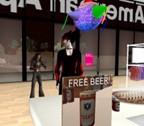
Battles in the Virtual World of Second Life
A group called the Second Life Liberation Army have been harassing Second Life inhabitants in the stores of First World brands. Earlier this month, members of the SLLA stopped shoppers buying in American Apparel. Their mission is to get voting rights in the world plus a share in the Second Life company, Linden Labs.
Second Life Liberation Army - The SLLA is a national liberation movement working towards establishing citizens rights within Second Life.
More info about on-line rebellion here. [posted by Marc Garrett on netbehaviour]
Posted by jo at 10:58 AM | Comments (0)
August 28, 2006
I Am(not)sterdam

10 Exercises to get the City out of your Body
Radio LIGNA / Radioballet / :: I Am(not)sterdam: 10 Exercises to get the City out of your Body :: Saturday September 2nd | 13.30 pm :: Radio Patapoe 88.3 FM and Radio Ruigoord 90.3 FM :: Location: Leidsestraat :: Bring your own radios and mobile phone receivers! :: Radio receivers also distributed at De Balie, Kleine-Gartmanplantsoen 10, Amsterdam.
Amsterdam Inc. - In the streets of Amsterdam, we are not only inhabitants or visitors of the city, but we also are part of a brand, that blends the individual being and the city into a common identity: 'I amsterdam'. There is no being in the city without being the city. The public sphere becomes the showroom for the new brand Amsterdam.
Deviant Behaviour - The appearance of the inner city as showroom is a product of sanitizing policies, eviction, surveillance and control. The latter is not only executed by police, and security personnel, but also by ourselves, as we have internalized modes of self-control and 'proper' behaviour. In the beat of the corporate city we confirm this logic by simply repeating the same set of fixed gestures again and again: walking around, stopping, looking in the shop windows, exchanging money for commodities. No rule is needed forbidding deviation: individual deviation is already part of the city branding.
'I amsterdam' means diversity. But what happens if we fail to repeat these gestures, and invent alien gestures on a collective scale? Can we, as inhabitants and visitors of Amsterdam, intervene in its regulated urban rhythm without becoming incorporated in the city's branding?
Radio ballet - The Radio Ballet 'I Am(not)sterdam' challenges you to find an answer! The radio ballet consists of a radio broadcast, especially produced for the Leidsestraat. It will suggest 10 different exercises to get the city out of your body. As a dispersed collective of participants, we perform deviant gestures (according to the script of the radio ballet), which would normally be impossible to do on an individual basis. Can we subvert the logic of the corporate city, by not subjecting ourselves to it anymore?
Come and find out! Be part of the Radio Ballet in the Leidsestraat on Saturday, 2nd of September 2006! I Am(not)sterdam! Dispersed collectivity instead of common identity! Don?t subject to the corporate city - become alien by public radio listening!
About Radio Ballet LIGNA
The free radio group LIGNA exists since 1995. LIGNA consists of the media theorists and radio artists Ole Frahm, Michael Hüners, and Torsten Michaelsen, who since the early nineties have been working at the "Freies Sender Kombinat" (FSK), a public non-profit radio station in Hamburg. In several shows and performances they have been investigating the importance of dispersal in radio as well as of the radio. One of the main focuses is to refer to forgotten and remote possibilities of radio use in order to develop new forms of interactive practices. Another emphasis has been placed on the development of concepts and the production of performative audio plays in order to find out how radio can intervene in public and controlled spaces, so that its public nature reappears in the form of uncontrollable situations
The “Radio Ballet” is an excellent example of the latter: it is a radio play produced for the collective reception in certain public places. It gives the dispersed radio listeners the opportunity, to subvert the regulations of the space. Held for the first time in Hamburg’s Central Station in 2002, this focused on how radio can intervene in public and controlled spaces, so that its public nature reappears in the form of uncontrollable situations. Yet, Ligna's performances aim to confront the privatised, controlled production of capitalism with the dispersed, yet collective, uncanny and public production of the radio. The Radio Ballet brought back excluded gestures of deviant behavior were invited to enter the station, equipped with cheap, portable radios and earphones. By means of these devices they could listen to a radio program consisting of a choreography suggesting permitted and forbidden gestures (to beg, to sit or lie down on the floor etc.). These suggestions were interrupted by reflections on the public space and on the Radio ballet itself.
The Radio Ballet I Am[not]sterdam, especially developed for De Balie, consists of a radio broadcast, produced for the Leidsestraat in Amsterdam. The radio broadcast will suggest ten different exercises to get the city out of your body. The dispersed collective of radio listeners will be able to perform deviant gestures that no one would or could do alone.
Is it possible to subvert the logic of the corporate city, if people do not subject themselves to it anymore? Come and find out! Become part of the LIGNA Radio Ballet in the Leidsestraat on Saturday, 2nd of September 2006!
The Radio Ballet starts at 14:00. You can get radios at De Balie from 13:30 on. But better bring your own radios, or mobile phones with receiver! The Ballet will be broadcasted on the Frequency of Radio Patapoe 88,3 FM.
I Am[not]sterdam! Dispersed collectivity instead common identity! Don´t subject to the corporate city - become alien by public radio listening!
Posted by jo at 10:03 AM | Comments (0)
August 25, 2006
aMAZElab
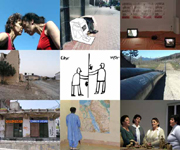
Urban Interventions + Cultural Exchanges
aMAZElab: Urban interventions, workshops, films, debates, cultural exchanges, publications :: aMAZElab is a non-profit cultural lab based in Milano, which works for the diffusion and knowledge of contemporary cultures. Founded and directed by Claudia Zanfi and Gianmaria Conti, promotes projects and events on social-territorial research, cultural interchanges and micro-geographies. At its 5° birthday, aMAZElab develops over 2006 summer/autumn a series of activities and appointments for reflection and research, such as:
20 September/10 October 2006 :: Nicosia, Cyprus :: Transcrossing memories (urban installations) :: "The Memory Box" is a mobile device to collect popular history from the common people. This bilateral intervention will serve as a travelling public space open to everyone, and will host various presentations, artistic projects, readings, video, debates, performances etc… The project is held in collaboration with Artos Foundation Nicosia, Ashik Mene Studio, Art schools, theoreticians, architects and artists in Cyprus, from both sides.
The “Memory Box” is a concept by Gianmaria Conti, designed in collaboration with Bauhaus University, Weimar (Germany).
aMAZElab, Via Cola Montano 8 20159 Milano, ph-fax 02 6071623 info[at]maze.it
Posted by jo at 09:40 AM | Comments (0)
Practice, Power, Politics, and Performance

A Symposium in honor of Allan Pred
[...] I am totally unconcerned with the disciplinary limits of geography, but fully concerned with geography as an ontological condition, as an inescapable existential reality. Everybody has a body, nobody can escape from their body, and consequently all human activity -- every form of individual and collective practice-- is a situated practice and thereby geographical. I regard the invisible geographies of power relations and meaning/discourse as every bit as "real" as the visible geographies of the built landscape and actual human activity. Whether exploring the historical geography of past and present urban modernities, or the production of gendered and "racial" difference, I am always preoccupied with the complex and multi-scaled processes through which visible and invisible geographies emerge out of one another. [...]
I take writing and questions of representation very seriously, believing that there should be some congruence between my textual strategy and the subject matter I am dealing with, between the way in which I write and what I am writing about. I look forward to the day when the watchdogs of academic style lose their teeth and it will not be considered out of line to submit Ph.D. dissertations in CD-Rom format, where text, sound and image are fused with one another. [...] [via nicholas senn on critical spatial practice]
Posted by jo at 09:30 AM | Comments (0)
August 23, 2006
[iDC] Interactive City: irrelevant mobile entertainment? Part 3
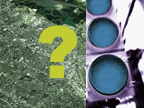
Anna Munster's Response
Steve, John and others,
I'm glad that you, Steve, took the time out to interact with this discussion and to add some of your comments about the background and intent to some of the projects and themes you worked on. I think this is important information to have because, in fact, it can be then passed on, informally to others in terms of organisational and process 'notes'
Without wanting to detract from the fact that you and Joel and many,many others obviously put a great deal of work into the event (and I have been involved in conference organisation and know that it's long, hard and thankless), I still think you have to take account of the fact that many people who went to this year's ISEA and 01 Festival think it didn't work. This is evidenced from: this and other list discussion, everybody I ran into commenting upon this while there and various blogs. It's ok for something not to work. You should also be aware that there were many individual events and particularly curated aspects that did work, were enjoyed. The point is why did it not work overall and how can things change toward something more productive in the future.
It didn't work NOT because you didn't put a huge amount of work into it. It didn't work for all the reasons that people have been speaking of on this list:
- irrelevant or not completely articulated and worked through themes.
- a general sense of experiencing the relationship to the city of San Jose and its space and architecture as dislocated, nonlocated, delocalised. And while you list various projects that did try to work with place and community this did not come across as a major experience for many who participated over the 7-10 days.
-a sense that too much was trying to be achieved in too many disparate spaces. That's a case of being over-ambitious and obviously under-resourced. Less things more tightly drawn together might well remedy this. People do not need to be constantly entertained but rather thoughtfully provoked.
-a sense among many artists and thinkers and cultural producers that there are terribly more urgent issues at stake right now and that there is responsibility from a critical, artistic community holding any event in the US now to foreground these issues: imperialism / empire / nonempire, war / ethics, technology / military, poverty / human rights, precarity / labour / illegality, paranoia / regulation / deregulation, fundamentalism etc etc...
I also believe that this is the creative responsibilty of a country such as Australia right now and pointed to the Sydney Biennale as an example of another lost opportunity in this area.
I did not expect ISEA to be smooth, slick or perfect. I expected chaos and the rough and ready...However what I primarily took away from the event overall was a kind of disconnected emptiness. Unfortunately I did see a kind of biennale structure being emulated and this is quite possibly an effect of the scale of the projects ISEA is trying to achieve. In the Pacifc Rim summit the point was made a number of times that small-scale, localised participation in relation to locale can often be more successful an experience for participants. I have to say I agree.
As for John's comments about the devolution of Anglo-American societies toward fascism at the moment - yes, I couldn't agree more. I certainly don't exempt my own 'nation' from that either. I returned to a whole bunch of news reports about outbreaks of anti-semetic and anti-islamic graffiti and desecration of mosques and synagogues throughout Sydney. We are just as racist a country and it is State sanctioned racism similarly buffeted by organised fundamentalist religions.
But what I did really sense from going to the US (and this is not the first time - I spent about 3 months in NY in 2004 during the period Steve Kurtz was arraigned and have been back and forwards many times b4 that) was the very deep level of militarisation of every aspect of civilian life. To me this is fundamentally frightening and the most obvious sign that we have moved headlong into neofascism...what is to be done, socially, culturally...has never been a more pertinent question...
Best Anna
A.Munster at unsw.edu.au
Dr. Anna Munster
Senior Lecturer,
Postgraduate Co-ordinator
School of Art History and Theory
College of Fine Arts
University of New South Wales
P.O Box 259
Paddington,
NSW 2021
ph: 612 9385 0741
fx: 612 9385 0615
iDC -- mailing list of the Institute for Distributed Creativity iDC[at]bbs.thing.net http://mailman.thing.net/cgi-bin/mailman/listinfo/idc
List Archive:
http://mailman.thing.net/pipermail/idc/
Posted by jo at 08:40 AM | Comments (0)
August 22, 2006
[iDC] Interactive City: irrelevant mobile entertainment? Part 2
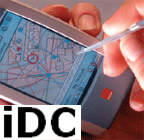
Mark Shepard's Response
It's encouraging to find such an outpouring of interest and critique on the subject of locative media and its relation to pyschogeography, mapping and urban play. While we had originally planned on addressing many of these issues in September as part of the Architecture and Situated Technologies thread, I think the current discussion provides an opening to address how an evaluation of certain locative media practices (and their failures) might provide a "sandbox" for thinking through the opportunities and dilemmas of a near-future world of networked "things". From locative media to atoms, bits and ubiquity.
As someone whose interest in the Situationists predates my work in new media, I have long felt uncomfortable with media art practices that claim or aspire to transpose concepts of pyschogeography and tactics of the dérive or detournment to contemporary urban environments. It is critical to remember that the dérive emerged in a specific historical context, one that I would argue no longer holds. In part a response to 20th century urban planning strategies promoted by modern architects associated with CIAM (Congrès International d'Architecture Moderne), the dérive sought to reclaim a space for the creative capacities of an imaginative subject in face of an onslaught of the functional rationalization of modern capitalism. CIAM's strategies aimed to reorganize the city - perceived as an ailing beast in need of a cure - through a strict functional segregation of dwelling, work and recreation (leisure) zones connected by rationalized transportation corridors.
Citing a 1952 study by Parisian sociologist Chombart de Lauwe that mapped the movements made in the space of one year by a student living in the 16th Arrondissement, Debord expresses outrage that her itinerary "forms a small triangle with no significant deviations, the three apexes of which are the School of Political Sciences, her residence and that of her piano teacher." [1] To a certain extent, the dérive was conceived to explicitly counteract this rationalization of patterns of movement through the city and the corresponding limitations imposed on the diversity, messiness, and richness of urban life. Understood as a form of ludic play, the expressed aim was to free people from "their relations, their work and leisure activities, and all their other usual motives for movement and action, and let themselves be drawn by the attractions of the terrain and the encounters they find there." With regard to kanarinka's comment about the gentleman invited to drift with them who "summed it up nicely" by saying "Sorry, I can't go with you. I have to work here until 8PM and then I have to go to my other job," I would argue that it is precisely this mentality that the dérive sought to address.
In evaluating locative media projects claiming or aspiring to a Situationist agenda, I often find myself questioning to what extent their deployment of mobile technologies ends up actually reifying this rationalization of patterns of use or movement. Put another way, to what extent do conventions for the use of consumer mobile technologies actually contribute to CIAM's agenda in their codification of modes of interaction with and within the contemporary city? Perhaps the most pertinent question for locative media might be: how might these technologies be (mis)used in an attempt to counteract (rather than reinforce) an ongoing rationalization and commodification of urban life? It would seem less a question of "locating" oneself, perhaps more one of getting lost...
Brian Holmes' critique of locative media [2] focused on a perceived noncritical ("naive") adoption of GPS technologies and Cartesian mapping systems in the context of Situationist aesthetics. Specifically, Holmes attacks the non-reflexive use of technologies developed by the military and their domestication in the context of scenarios of play, where aesthetics becomes politics as decor. This critique was originally delivered at a workshop held at the RIXC center in Latvia in 2003. Since then the field has expanded significantly, and while early locative media projects may have relied heavily on these technologies, it would be difficult to identify locative media exclusively with either GPS or Cartesian mapping today. At the same time, some contemporary projects built on GPS are far more reflective of the dark side of locative media. [3] This is not to say Holmes' critique no longer holds. Quite the contrary, as it would seem it has been in many cases internalized by the field. While this year's ISEA / ZeroOne San Jose symposium and exhibition presented a few GPS-based locative media projects, they were by no means the majority. Drew Hemment et. al.'s LOCA project is one example of a "pervasive surveillance project" aimed at raising public awareness of how certain consumer technologies (bluetooth in this case) enable tracking in ever more subtle ways. [4] Alison Sant's paper "Redefining the Basemap" [5] addressed the fact that many locative media projects still "remain bounded by datasets that reinforce a Cartesian and static notion of urban space" and made a call for alternative methods of mapping the city, particularly ones addressing the temporal dimension of urban experience.
The critique of GPS and Cartesian mapping systems is by no means new. Laura Kurgan's exhibit "You Are Here: Museu" (1995) [6], addressed the uncertainties that arise when relying on satellite tracking systems to know "where we are." Architect Stefano Boeri's essay "Eclectic Atlases" (1997) [7] addresses the failure of satellite imagery to adequately represent the contemporary metropolis and calls for alternate methods for mapping the city as experienced "on the ground." The exhibition and catalogue for "The Power of the City: The City of Power" (Whitney Museum of American Art, 1992) [8] explores alternative mapping practices of conceptual and performance art from the 60s and 70s in terms their relation to Baudelaire's Flaneur, Jameson's notion of cognitive mapping, and (then) contemporary readings of Situationist aesthetics. Kevin Lynch, in his oft cited treatise "The Image of the City" [10], acknowledged that the emotional dimension(s) of his cognitive maps were beyond the reach of his research methods. More recently Marina Zurkow, Scott Patterson and Julian Bleecker's "PDPal" (2003) [9] asks what might an "emotional" GPS look like?
Perhaps the most interesting take on the relevance of locative media today is that of Marc Tuters and Kazys Varnelis as expressed in their essay "Beyond Locative Media," published by Leonardo in conjunction with the Pacific Rim Summit [11]. Acknowledging that locative media has been attacked for its ambivalence with regard to commercial interests and its reliance on Cartesian mapping systems, they find these critiques nostalgic, "invoking a notion of art as autonomous from the circuits of mass communication technologies", which they argue no longer holds. Moreover, they make the case for locative media as a "conceptual framework by which to examine the certain technological assemblages and their potential social impacts. Unlike net art, produced by a priestly technological class for an elite arts audience, locative media strives, at least rhetorically, to reach a mass audience by attempting to engage consumer technologies, and redirect their power." At the dawn of an age where ubiquitous networked objects outnumber humans as generators and receivers of information, this effort is more important than ever.
+++
[1] Guy Debord. "Theory of the Derive" - http://library.nothingness.org/articles/SI/en/display/314
[2] Brian Holmes. "Drifting Through the Grid: Psychogeography and Imperial Infrastructure" - http://www.springerin.at/dyn/heft_text.php?textid=1523&lang=en
[3] See the Institute for Applied Autonomy's "i-SEE - Now More than Ever" - http://www.appliedautonomy.com/isee.html or Annina Ruest's "Track the Trackers" - http://www.t-t-trackers.net/
[4] LOCA - http://www.loca-lab.org/
[5] Allison Sant. "Redefining the Basemap" - http://www.intelligentagent.com/archive/ia6_2_interactivecity_sant_baseline.pdf
[6] Laura Kurgan. "You Are Here: Museu" - http://www.l00k.org/youarehere/you-are-here-museu
[7] Stefano Boeri. "Eclectic Atlases" in The Cybercities Reader (NY: Routledge, 2003)
[8] Cristel Hollevoet, Karen Jones, Timothy Nye. "The Power of the City: The City of Power (NY: The Whitney Museum of American Art, 1992)
[9] Marina Zurkow, Scott Patterson and Julian Bleecker. "PDPal" - http://www.pdpal.com/
[10] Kevin Lynch. "The Image of the City" (MIT, 1960)
[11] Marc Tuters and Kazys Varnelis. "Beyond Locative Media" - http://netpublics.annenberg.edu/locative_media/beyond_locative_media
+
mark shepard
+
http://www.andinc.org
iDC -- mailing list of the Institute for Distributed Creativity (distributedcreativity.org) iDC[at]bbs.thing.net http://mailman.thing.net/cgi-bin/mailman/listinfo/idc
List Archive:
http://mailman.thing.net/pipermail/idc/
Posted by jo at 10:03 AM | Comments (0)
August 18, 2006
Darfur campaign in Second Life
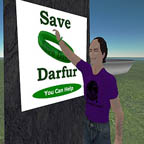
Embedded Social Messages
Darfur_Campaign [originally uploaded by eliane_alhadeff] (Rubber bracelets have made it into virtual life, as have hairy arms. Amazingly weird.) I found this on Flickr, and I'm rummaging around to find out what was going on - there was an interesting, Star-Wars style committee meeting for this online kidscamp project - maybe? - and a game has been produced, one of many to be produced by teens, each with a message:
Playing 4 Keeps is an innovative youth media project, in which a team of Global Kids Leaders at South Shore High School are gaining leadership and game design skills that they will use to develop and produce a socially conscious online game each year.
This is seriously impressive stuff.
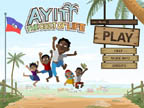
High quality, solid message:
Ayiti: The Cost of Life is a role-playing video game in which the player assumes the roles of family members living in rural Haiti. Over the course of the game, the player must choose among and balance various goals, such as achieving education, making money, staying healthy, and maintaining happiness while encountering unexpected events. The player must make many decisions that contribute to or detract from achieving his or her chosen goals.
Global Kids Digital Media Initiative - lots of interesting, game-based political and cultural activities, produced by and for teens,
SaveDarfur.org - the campaign [blogged by Alice in Wonderland]
Posted by jo at 03:34 PM | Comments (0)
August 10, 2006
Regrets
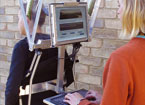
Collective Remorse
Ars Electronica, Hauptplatz :: September 1-5 2006 :: 10:00 am - 8:00 pm :: Regrets--by Graham Budgett and Jane Mulfinger (US)-- are often the conceptual vehicle of self-improving tendencies, but they are rarely communally active in any meaningful way. The Regrets team seeks to intervene and enable such interaction. In particular, remorse is posited here as a positive entity, incorporating recall, reflection, and learning.
Five custom mobile computer units roaming public space in and around a chosen city, community, or event, collect anonymously submitted regrets from the public, gathering and comparing them to comprise a sociological database of contemporary regret. Instant feedback to the individual user based on other contributors' similar concerns is algorithmically generated to 'share the burden'. Random selections of the regrets are made public via locally negotiated sites and existing signage, network, and broadcast facilities. The archive represents a glimpse of a given community at a particular time through the rubric of regret; its results available for future studies.
Posted by jo at 04:30 PM | Comments (0)
August 04, 2006
SKIN-PÔ
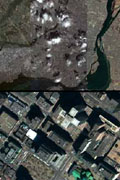
Artistically Sensitive Ecosystems
The SKIN-PÔ project--by Mark Fournel--seeks to bring the creative process into the public forum and allow citizens to reclaim their community spaces through technological works of art that spur spontaneous creation. The artist offers an interactive environment within an urban space, such as a public square. Passers-by are able to interact with the work's audio and visual components via wireless interfaces that control video projections on surrounding buildings and create and distribute sound in the venue. SKIN-PÔ challenges urban structures, disputes their composition and reconstructs them where they stand. We are impelled to scrutinize and confront the urban reality imposed upon us, the conventions that rule it, and the acceptance of these conventions by the key stakeholders of our urban spaces, the passers-by.
With SKIN-PÔ, Fournel reaches out to passers-by and strives to change how they look at their surroundings. He destabilizes them and in doing so forces them to call into question what they have previously accepted as fact. The project seeks to create distance — both critical and playful — between us and our role as urban players. In this vacuum between reality and fiction, the artist creates a type of "escape," which he sees as essential if we are to truly explore our rapport with the urban space around us.
This void fascinates him, as it represents a respite that allows us to relax, take a deep breath, and reconnect with our imagination.
The project incorporates the implementation and use of a highly accurate, quick response, spatial positioning system and a number of video and audio control software applications and modules. SKIN-PÔ promotes an open source philosophy, with all of the modules, tools and software developed for the project made available to the community.
SKIN-PÔ is the second phase of the Transduction project, a body of research and production work begun in 2000 that explores and confronts the various methods we use to take ownership of our architectural space and the integration of these methods into the construction of "artistically sensitive ecosystems." SKIN-PÔ evolved directly from the Tontauben installation, the first phase of the Transduction project. [J.P. © 2006 FDL]
Posted by jo at 12:56 PM | Comments (0)
August 03, 2006
Raqs Media Collective

For the Record
"From the (below) list it will be evident that the kind of practices that we are talking about range from comics to high theory, with software, web-based work, radio, documentary filmmaking, and self-published broadsheets in between. Crucially, each of these might involve either a level of sociality in the production of cultural processes or a willingness to engage with a discursive register (and sometimes both). This unties art and cultural work from decorative or propagandist demands and enables it to claim a space for forms that are generative of questions, thought, reflection and communitas." -- Monica Narula, Raqs Media Collective
A Place Like This, A Time Like Now: Sometimes it feels like things are beginning to get really interesting. We imagine that Calcutta in the 1940s and ‘60s (or in the 1880s) and Bombay in the 1920s and ‘50s or Delhi in the 1850s and (briefly) in the 1970s, might have been really rewarding times and places to live in. We have a sense that Delhi, today, in the first decade of our young century, is again showings signs of quickening to the possibilities of a new life.
A Place Like This, A Time Like Now
Sometimes it feels like things are beginning to get really interesting. We imagine that Calcutta in the 1940s and ‘60s (or in the 1880s) and Bombay in the 1920s and ‘50s or Delhi in the 1850s and (briefly) in the 1970s, might have been really rewarding times and places to live in. We have a sense that Delhi, today, in the first decade of our young century, is again showings signs of quickening to the possibilities of a new life.
This new life does not come upon us without its share of pain, because it exists simultaneously with the cruel transformation of the city that evicts hundreds of thousands of people, and destroys their carefully built frameworks of existence. It is not without its share of paranoia, as the shadow of the deep state, through a variety of surveillance networks, leaches into every street corner. It is not without its vulgarity as new money explodes and talks tough and dirty. Perhaps it is at times precisely such as this one – when large structural conflicts play themselves out on the urban landscape – that the forging of critical and reflective cultural practices seems all the more urgent and compelling. Perhaps that is why we sense them so keenly when they begin to intimate themselves to us.
And so, even as our city re-invents itself through escalating conflicts over extant and looming habitation and property, new migrants re-define the face and voice of the street, women take an increasingly visible place on the precincts and old urbane certainties crumble; a new sensibility takes hold. Delhi has outgrown the destiny of being a small town with a violent past and burdened with Imperial grandeur. It is now just a city, just another very big city. A city that has set out on a journey to find the world.
Circuits and Cities
Interesting connections are being formed, between Delhi and Bangalore, between Delhi and Lahore, Delhi and Kathmandu, Delhi and Berlin, New York, Beirut, Bandung. There is also a relationship with mofussil towns, and regional centres in north India which is not only extractive. Traffic between Delhi and Benaras, Allahabad, Gorakhpur, Ballia, Patna, Jabalpur and Jaipur has a different cultural significance now. People bring new thoughts and voices from these places, and return to them with the connections that they make in a place like Delhi. Within our city, entire worlds, like those of the resettlement colonies of Dakshinpuri or of the threatened riverside settlements like Nangla Machi or of inner city squatter zones, are finding a voice. The sense of Delhi being a place that contains entire worlds is more vivid today than it has ever been.
Writers, artists, practitioners, performers and audiences travel between spaces more than before, and the magnet of Mumbai, which necessarily took away the best of Delhi, seems to have weakened, replaced, in parts, by a genuine conversation. We can no longer think of our milieu only in terms of the physical boundary of the National Capital Territory of Delhi, of the Republic of India, or even of the South Asian region, but crucially, in terms of how different sub cultures and scenes in Delhi function as nodes in an expanding network that intersects at key points with other networks which may have originated in other cities. Here, the distance (or proximity) between Delhi and Bangalore or Mumbai, or for that matter Beirut or Bandung, becomes a function not of geography but of the affinities and interests that transcend frontiers of one kind or another.
What’s going on? Where?
In the domain of the imagination, images, sounds and thought, there is a quiet ferment that marks our city. Its signs are muted, nascent, fragile. There is nothing overt or spectacular about these symptoms and we must not rush headlong to any conclusions or prognoses. Everything is uncertain. But the symptoms of a specific sensibility are insistent on revealing themselves. They demand from us a renewal of the terms of engagement which have hitherto ruled the domain of cultural praxis and artistic work. New publics beckon us to join them at play. So many things wait to be done.
This is as good a time as any to initiate a conversation that indexes some of these developments around us, points to things further away that might be of interest, and pauses to take stock of what might lie head.
First, to take a look at what is around us:
Spaces like Khoj in Delhi which provide an excellent context of hospitality for new and emerging work, cross-border initiatives in modest and unconventional public spaces by artists and practitioners in India and Pakistan like Aar-Paar, and the recent initiatives taken by documentary filmmakers to challenge censorship in exhibition are signs that there exists a strong desire to re-write the terms within which cultural practice occurs in our milieu.
Younger practitioners are trying out new forms – lawyers (such as in the Alternative Law Forum) are making comic books and html works against intellectual property and censorship, and the comic book or graphic novel is emerging as an interesting complex new form (see the work of Sarnath Bannerji, Vishwajoyti Ghosh and Parismita Singh, among others), as its practitioners explore difficult zones in personal experience and history. Architects and urban theorists, such as Solomon Benjamin, are experimenting with performance based presentation formats. A new generation of photographers is making edgy and personal work, without obligatory colourful turbans and the tyranny of the ‘well made photograph’. There is a new energy in the documentary, and the short and experimental film making scenes, made possible in part by more accessible technologies of production. Zines appear and disappear with an interesting frequency and broadsheets inaugurate the advent of a serial image-text essay form, and a new kind of critical fiction as well as non-fiction writing is making its presence felt in English, Hindi, Bangla, Tamil and Malayalam on Blogs. It appears that things are stirring.
Meanwhile, elsewhere...
At times like this, it also becomes useful to try and see what may be going on in other places and in other milieux. In our travels over the last six years, we have had the good fortune of observing many initiatives and practices all over the world that we think might serve as interesting provocations, so as to begin a conversation about what might be possible. We are placing this list on record also to register our kinship and solidarity with the people who have actualized these practices.
We are mentioning here only those spaces and initiatives that we consider to be modest. We need to focus on situations and processes that can be initiated and sustained with limited resources. What we have noticed in each of these instances is that a tight budget, or a lack of expansive resources, has not by any means implied a handcuffed imagination. Exciting things can also be done in small spaces, with little money, with no captive audiences, and by people who have full time jobs and next to nothing in terms of social security.
We have also restricted this list to instances where we have actually encountered the concerned practitioners personally. The list of practices and initiatives that we have found interesting, exciting and challenging which we have read about in addition to these, or seen in a show or on the internet, (although we may not have met the people involved with them) is far longer, and would require separate writing! This list is not exhaustive, and we intend to update and expand it from time to time so as to maintain a public database of the conceptual, intellectual and practice based context that we are nourished by.
There is no specific design or hierarchy implicit in the order in which they appear in the list below:
Queen's Nail Annexe, San Francisco
A verymall not-for-profit exhibition space (two rooms) which also doubles as a recording label in the Mission district in San Francisco, sustained by the innovative work of two dynamic persons. They work as community pedagogues, artists, facilitators and curators. The Queen’s Nail Annex offers space to young and old practitioners and curators who are able to offer a rigorous argument in their work. When we visited the Annex (which borrows its name from its neighbour - a Nail Beauty Parlour) we saw the opening of an exhibition devoted to videos and music produced by and in collaboration with the veteran experimental architecture and urbanism practice Archigram.
AndCompany, Frankfurt
A group of performers, theatre artists, musicians and theorists, based mainly in Frankfurt. We collaborated with them on a 'reading performance' in connection with 'The Wherehouse', a process and work that reflects on the relationship between cities and people termed as illegal migrants. What attracted us to Andcompany&Co's work was its practical adventurousness, which took in a strong interest in the legacy of Brecht's work, along with theatre, music, acrobatics and theory with a sense of enjoyment in working together as an ensemble. Their commitment to music, fun and philosophy, within the constraints of a modest working style and a commitment to working with all available materials was interesting to engage with.
Mongrel, London
A collective of software programmers, artists, technicians, writers located in and around London. Mongrel considers its practice to be a kind of art hacking, and is founded on meticulous, almost obsessive research often initiated by Mongrel Graham Harwood in collaboration with itinerant theorist Matt Fuller. What continues to attract us to Mongrel's diverse productivity is its eclecticism and serious irreverence. They are just as happy doing cut and paste xerox comic books and newsprint broadsheets as they are writing complex bits of code for a piece of software or hacking games and applications.
Park Fiction, Hamburg
An ensemble of people and practices located in close proximity to the depressed Saint Pauli district in Hamburg. A very successful instance of how cultural action within a community/neighbourhood context can stall the designs of urban redevelopment that might have resulted in eviction and demolition.
Atelier BowWow, Tokyo
An innovative architecture practice located in Tokyo, initiated by Yoshiharu Tsukamoto and Mayomi Kaijima, with whom we collaborated on the making of Temporary Autonomous Sarai (TAS) in Minneapolis in 2002. Atelier BowWow's investigations in what they call 'da-me' or 'not good' and 'pet' architecture, with their accent on researching informal and improvised architectural interventions in dense urban spaces is something we have a great deal of sympathy for. BowWow’s take on built form in urban space privileges that which may seem marginal at first, but is actually vital to the life of a neighbourhood or a street. It gestures to a density of contact, a plurality of usage and function, to the animatedness of interstitial spaces, and to a democracy of the sidewalk, the verge and the back alley that we find resonant with the urban forms of our city. It would be interesting to see what could occur if architectural practices in South Asia began taking an active interest in the informal city as an expressive of an architectural language.
TOROLAB, Tijuana
Another architectural practice, like Atelier BowWow with a strong presence in contemporary art venues. Torolab is based in Tijuana at Mexico's northern frontier with the USA, and much of its work is by way of an imaginative and focused reflection and research on the special conditions of the border zone, the peculiar relationship between the twin cities of Tijuana in Mexico and San Diego in the USA and the forms of improvised and 'emergency' architecture, using discarded automobile bodies, car tyres, crates and cardboard boxes that are a hallmark of subaltern urbanism in Tijuana.
Arab Image Foundation, Beirut
An archival initiative undertaken by a group of photographers, critics and theorists spread across the Arabic speaking world, and in the Arab diaspora, to archive and document popular photographic and image making practices, especially with a view towards the destabilization of the 'Arab Image. They have spoken in Delhi, at an invitation from Khoj.
The Atlas Group Archive, Beirut/New York
A somewhat disembodied entity centred around the personage of Walid Raad that invokes an archival register to explore the contemporary history of Lebanon through mixed media installations, single channel screenings, visuals and literary essays and lectures/performances. What we find interesting in the work of the Atlas Group is the close attention to history, a sense of archival irony and a highly sophisticated visual language. What the Atlas Group Archive does is to use a historical imagination to weld a set of philosophical statements about the politics of seeing. The invocation of an image by the archive becomes an occasion for thinking about truth claims and uncertainty. Images, even the memories of images, become things to think with, not just objects to look at or recall. It may be interesting to see what happens were we to transpose aspects of this register of thinking with images and memories to the fractured history of our city.
Common Room & The Bandung Center for New Media Arts, Bandung
A dynamic cluster of self-organized spaces in Bandung, Indonesia, with a special interest in expressing the enormous vitality of urban youth culture in Bandung, with its distinct political and critical edge and commitment to having a very good time, with music, murals, experimental video, street fashion, new media, publishing and comics. The Common Room and the Bandung Center are object lessons in the ability to organize a dynamic public space and presence that is non-commercial, that has little or no funding, and that survives because of a close relationship to a young public that nurtures it with time and with improvised resources.
Long March Foundation, Beijing
A highly intense ensemble of artistic, cultural and archival practices, developed over many years and within the matrix of a densely collaborative framework, particularly interested in areas such as migration within China, that emerges from the space of the Cultural Transmission Center in Beijing. We found this practice, which we encountered for the first time at the Taipei Biennale 2005, to occupy a different, more nuanced but far more quietly subversive register of expression compared to the by now formulaic visual sensation of contemporary art from China.
kein.org: collaborative media production, Internet/Munich
kein.org is a peer to peer network of cultural practices that encompasses software, theory, performance, events and conferences - kein.org has in its history been the site for very precise and focused online and offline interventions ('Kein Mensch ist Illegal' and 'Deportation Class') against the detention and deportation of illegal immigrants in Germany and Europe.
Metareciclagem, Rio de Janeiro/Sao Paulo
Metareciglagem is a loose ensemble of people and practices that embody a critical free and open source practice with software, machines, people and spaces in Brazil. Equally distant from the NGO scene and the imperatives of self-consciously political language, metareciclagem is basically interested in initiating a set of creative processes that reclaim autonomies for human presence and subjectivity in all processes involving technological mediation, especially, but not only in those that use computers (accessible, assembled hardware) and software.
Chaos Computer Club, Berlin
A pioneering group of hackers and who were and continue to be active in the Berlin scene, intervening critically and through cultural and artistic work in areas to do with intellectual property, electronic surveillance and technological creativity.
Radioqualia, London, Bacelona, Auckland
An online art collaboration by New Zealanders Adam Hyde and Honor Harger, it was founded in 1998 in Australia and is currently based in Europe. Using various streaming media softwares, r a d i o q u a l i a experiments with the concept of artistic broadcasting, using the internet and traditional media forms, such as radio and television, as primary tools, and aims to explore broadcasting technology within the context of philosophical speculation.
Bureau d'etudes, Paris/Strasbourg
A practice consisting of researchers and cartographers who map flows of power and control in politics, economy, society and culture and render their work through elaborate diagrams, often exhibited within contemporary art venues and events.
Visible Collective, New York
A collective of artists, documentarists, legal practitioners, designers, programmers, cartographers and activists - creators of the 'Disappeared in America' project that documents the detention and disappearance of people in the United States of America following September 11, 2001
Temporary Services is a group of three persons: Brett Bloom, Salem Collo-Julin and Marc Fischer. Their work draws on their varied backgrounds and interests to produce creative exhibitions, events, projects and publications. Within their work they create socially dynamic situations and spaces for dialogue. They are distinguished by their fondness of self published pamphlets, and public projects that are temporary, ephemeral, or that operate outside of conventional or officially sanctioned categories of public expression.
We were especially struck by Temporary Services collaboration with a prisoner serving a sentence of life imprisonment that resulted in a project called 'Prisoners Inventions' consisting of a collection of ingenuous inventions made by a prisoner, a book and the replica of a prison cell.
Red 76, mainly Portalnd, Oregon
Red76 is the title used by a group of people working on collaborative projects in Portland, Oregon. The guiding constructs holding Red76 projects together are the facilitation of thought in public space and the examination of how to define what and where that space can be. The wish to charge space, to create an atmosphere where the public may become hyper aware of their surroundings and their day-to-day activities – such as making a lecture series in Laundromat shops – is an important construct for them.
Critical Art Ensemble, dispersed locations online
A collective of artists, theorists and scientists known for their critical research and creative work located at the intersections of technology, biology, cybernetics, feminism and a trenchant critique of the military-industrial-information technology complex. CAE produces events, performances based on laboratory experiments, books and web-based renditions of research themes and ideas.
Middle Corea describes itself as a virtual networked territory actually located in the Internet, and ideally located within the ecosystem of the demilitarized zone between North and South Korea. It realises itself through a variety of artistic and documentation activities undertaken by a group of artists, practitioners, photographers, theorists and curators loosely located in and around Seoul.
Mute and Metamute, London
A print journal and website devoted to a wide ranging critical discussion of the politics and culture of new technologies of communication
Improbable Voices is an archive of reflections in the form of interviews from inside a women’s prison, and a proposal for a monument to the prison-industrial system. The Improbable Voices project emerges out of a collaboration between a California based artist, Sharon Daniels, a group of ten women inmates who are incarcerated at the Central California Women’s Facility (CCWF) in Chowchilla, CA - the largest female correctional facility in the United States and Justice Now, a human rights organization that works with women in prison to build a safe, compassionate world without prisons.
From the above list it will be evident that the kind of practices that we are talking about range from comics to high theory, with software, web-based work, radio, documentary filmmaking, and self-published broadsheets in between. Crucially, each of these might involve either a level of sociality in the production of cultural processes or a willingness to engage with a discursive register (and sometimes both). This unties art and cultural work from decorative or propagandist demands and enables it to claim a space for forms that are generative of questions, thought, reflection and communitas.
Many of these formal approaches might seem somewhat alien to the current milieu of art exhibition practices in places such as Delhi, but we are certain that there is a change in the offing. New spaces will emerge and are emerging where new forms and new people will be at play. This is nascent now, but we think that this will take on a momentum of its own in a matter of years.
What is also evident is that as in other areas of human creativity (science, music, filmmaking) the rise of collectives, ensembles and networks will accelerate a vibrant cultural milieu. We hope that this listing provides everyone in our milieu with reasons for reflection, and we look forward to carrying forward a conversation.
We look forward to more interesting times in our city!
August 1, 2006
Monica Narula
Raqs Media Collective
Sarai-CSDS
29 Rajpur Road
Delhi 110054
www.raqsmediacollective.net
www.sarai.net
Raqs Media Collective: For the Record [posted to Saria by Monica Narula] [Related entry]
Posted by jo at 08:38 AM | Comments (0)
July 31, 2006
The Other India
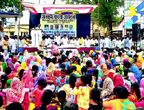
100,000 Farmer Suicides
"The Vidarbha Jan Andolan Samiti has put up a blog as part of its campaign for statehood for Vidarbha as also the continuing farmers' suicides. Amongst other things there is a list of names of 655 farmers who have committed suicide since June 2005. A group of farmers is planning a march to Delhi on 15 August.
Imagine such a large number of people committing suicide in any other profession - say, in the BPO industry - and imagine our response. It would be frontpage news in all national papers. It would occupy far more air time than on TV than what the continuing agricultural crisis in Vidarbha and Telangana is currently getting. There would be dedicated "campaigns" and people across the country would be sending money to the Prime Minister's Relief Fund. Ordinary people would come out to their rescue, companies would announce relocation packages.
Between 1993 and 2003, a hundred thousand farmers in India have killed themselves, largely due to debt. Whether it is state control and lack of competition or the lessening of state support to agriculture that has caused the crisis is open for the ideological jury. What cannot be disputed is that it is a national shame and deserves far more attention from all of us.
There is a lot to talk about what's happening in Vidarbha, and a lot is controversial. Bt Cotton, cotton subsidies in the west, the reduction of minimum support price by the government, the government's suicide compensation as an incentive to commit suicide, the state control over agriculture [...] Whatever the reasons and debates be, the suicides must stop, and they must stop now. I urge those of you in the media to give the subject a lot more attention, and bloggers and writers to write about it. Also see The Other India" [posted by Shivam Vij on Sarai]
Posted by jo at 03:05 PM | Comments (0)
July 30, 2006
Radio Vehicles
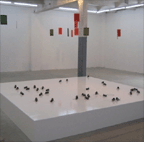
radio.territories urban intervention
Radio Vehicles with Darius James (USA/DE) and Peter Dennett, Art Yard (UK) :: Aliens Am Alex: radio.territories urban intervention at: TV Tower, Alexanderplatz, Berlin :: On Air 95,2 FM or online http://radioeinszueins.de :: July 30, 2006, 16:00 - 18:00.
Apocalypso: The Cosmic War Dance of Sun Ra's Army of Anthropodial Transistors :: When the composer and mystic, Sun Ra, returned to his native Saturn on May 30th, 1993, he left behind him a vast and varied body of recorded musical works. Up until now, much of this music was unreleased and unavailable to the public. But, through a series of séances conducted in the studios of Radio 1:1, with Dr. Snakeskin acting as medium, Mister Ra informed us that he will be returning to this planet in his astral form on Sunday, July 30th, 2006. He will not be alone. He is bringing his army of Anthropoidal Transistors. "We are going to invade Berlin!!!" he chuckled, "Our first target is the TV Tower in Alexanderplatz! My weapons?!! Two full hours of sonic attack—or acoustical magic -- taken from a secret library of unreleased recordings. We will dance a cosmic dance. A cosmic WAR dance. It's the Apocalypso!"
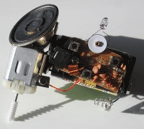
The working environment of the radio vehicles is the urban public space. Radio vehicles is an ephemeral urban intervention aiming to usurp urban space artistically. Twenty vehicles created from simplest and most affordable technical equipment will be let free into the wild. They move about while broadcasting the programme of radio 1:1 which will consist of unpublished Sun Ra material. The swarm moves awkwardly while emitting sound into the public space.
Proudly presented by the bootlab association in cooperation with radio 1:1 as part of the radio.territories series of urban interventions across Europe. Radio.Territories is supported by the European Union Culture 2000 Programme.
Posted by jo at 11:54 AM | Comments (0)
July 26, 2006
makearevolution.net

How is it possible to make a political change?
Concerned to cause a shift to a more collective mode of cultural production, fully embracing Foucault´s critique of the author's name in favour of collective authorship, Makearevolution* is a project that invites everyone to post revolutionary statements, and to share their major concerns about culture, global/local geo-politics, power, labor, environment, post-social issues, etc. The objective is to explore the relationships between contemporary art and current cultural and political trends. It will focus on revolution as a pervasive cultural phenomenon and explore connections between the art system and revolutionary ideology.
Makearevolution* will deal with themes related on different levels, be they social, political or aesthetic, and in this way address current democratic discussions. Key questions are how forms of revolution have historically been propagating or reacting against discourses of modernity, and how a high level of stylistic and "aesthetic" consciousness is central to revolutionary movements' quest for mass appeal.
Makearevolution* is an ongoing and mobile project that can be presented in different nonprofit art and non-art spaces. This structure is ready to put in practice revolutionary ideas and ideals near you. invitations from all over the world are accepted in order to build and develop revolutions near you. For more info, please contact makearevolution.net at info[at]makearevolution.net.
Posted by luis at 12:52 PM | Comments (0)
July 15, 2006
Mirjam Struppek
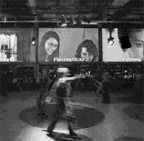
The Social Potential of Urban Screens
"...The emergence of the internet culture has brought new ways of participation and exchange to challenge hierarchical authorship. The 'new forms of creation mediated by networks more and more remote, fast and wireless' (Beiguelman, 2006) derived from this culture, influence new productions of public space. Artists are exploring the potential of the growing interconnections between online and offline worlds, and between social experiences in virtual and physical space. Wallace (2003) sees the internet connected to screens 'as a delivery mechanism to inhabit and or change actual urban spaces'. We can find various community experiments in the growing field of social computing: friend-of-a-friend communities; participatory experiments in content creation in the mailing list culture; and more recently, the wiki websites (where users can add and edit content) and blogging systems that serve an increased need for self-expression. By connecting large outdoor screens with digital experiments in online worlds, the culture of collaborative content production and networking can be brought to a wider audience for inspiration and engagement..." From The Social Potential of Urban Screens by Mirjam Struppek, Visual Communication, Volume 5, No. 2, Sage Publications June 2006, p 173-188.
Posted by jo at 02:25 PM | Comments (0)
July 14, 2006
Europe Lost and Found

Join The Lost Highway Expedition
A massive movement of individuals will pass through Ljubljana, Zagreb, Novi Sad, Belgrade, Skopje, Priština, Tirana, Podgorica and Sarajevo. The expedition will generate projects, art works, networks, architecture and politics based on knowledge found along the highway. Projects developed from the expedition will lead to events in Europe and the US. LHE is a project by the School of Missing Studies and Centrala Foundation including: Azra Akšamija, Katherine Carl, Ana Dzokić, Ivan Kucina, Marc Neelen, Kyong Park, Marjetica Potrč and Srdjan Jovanović Weiss, together with partners in the cities of The Lost Highway Expedition.
The Lost Highway Expedition is a tour to explore the unknown future of Europe. It was initiated by the School of Missing Studies [SMS] as the first event of Europe Lost and Found (ELF), a multi annual and three-phased project. ELF is an interdisciplinary and multi-nationally based research project to articulate and imagine the current evolution of new and transforming borders and territories of Europe.
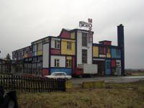
The subject is the continent of immigration, and its depopulation and aging, and the need for redefinition of states, sovereignties and citizenships. Challenged is the established belief and practice of nation-state, including non-representative and technocratic construction of European Union yet to vision more open and alternative definitions for populous in movements. The rejection of constitutional referendum and the riots in France signal the contradiction between homogeneous and multiple identities, the fluidity of capital and containment of labor, the liberation of individuals and their restrictions under sovereignty. Clearly, Europe cannot subsist by itself, and is already being redefined by "the others" in its quest for a self-identity. In such contexts, ELF suggests the future of Europe is best seen in the Western Balkan.
Posted by jo at 06:53 PM | Comments (0)
July 13, 2006
GLOWLAB 09: july :: august 2006

Networks, Mobility, Interventions
The projects in Glowlab 09 examine urban architecture by investigating the social spaces enabled by public networks, mobile communication devices and direct intervention. In viewing the work, one might re-imagine the city as space which is defined through the nature of the interactions that take place within it.

Public Broadcast Cart by Ricardo Miranda Zuñiga: Transforms a shopping cart into a mobile radio station, transmitting via miniFM and the Internet. The Public Broadcast Cart is designed to enable any pedestrian to become an active producer of a radio broadcast by reversing the usual role of the public from audience to producer.

Hundekopf by Brian House and Sue Huang (Knifeandfork): A location-based narrative project utilizing SMS text-messaging to explore the experience of riding the Berlin Ringbahn.

Relay: Toronto by Germaine Koh: An architectural intervention that turns a building into a sort of urban lighthouse, relaying text messages received on a mobile phone by flashing the building lights in Morse code.

Lee Walton's Western Shift by Allard van Hoorn: An open-environment collaboration between researchers, architects, designers, artist, curators and all kind of cultural producers. Its aim is to stimulate fresh ways of looking at urban living and discover alternative solutions.

SpeedWave by Otino Corsano: A photographic based performance piece inspired by the established location of a regularly monitored Toronto speed trap. A camera on a tripod replaces the laser gun to document waves of local traffic.

Talking Cities [magazine review] by Krista Jenkins: A review of the recently published Talking Cities magazine, the print accompaniment to the exhibition of the same name, taking place at Zeche Zollverein in Essen, Germany.
Glowlab is an artist-run production and publishing lab engaging urban public space as the medium for contemporary art and technology projects. We track emerging approaches to psychogeography, the exploration of the physical and psychological landscape of cities. Our annual Conflux festival, exhibitions, events and our bi-monthly web-based magazine support a network of artists, researchers and technologists around the world.
Posted by jo at 02:11 PM | Comments (0)
July 12, 2006
Guerrilla Net Ballet Performance: Ballettikka Internettikka:
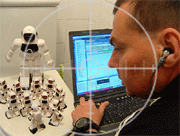
VolksNetBallet
Guerrilla Net Ballet Performance: Ballettikka Internettikka: VolksNetBallet by Igor Stromajer & Brane Zorman :: People's Internet Ballet furtively performed at -- and secretly broadcasted (as six one-minute live streaming videos) from -- the Basement Toilet in Volksbühne at Rosa-Luxemburg Square in Berlin, Germany; # Latitude: 52.31.36.84 N, Longitude: 13.24.43.02 E, Terrain Elevation: 41 m on Sunday, July 9th 2006 at 9 PM GMT+1 (Berlin/Paris local time). "Stromajer and Zorman manipulated a semi-automatic flying cow and eleven robots dancing an internet ballet, MC Brane conducted an MP3 orchestra!"
VolksNetBallet was broadcast in the form of six one-minute streaming videos, almost live, with only two minutes delay. It means that the visitors could see and hear in six steps what had just happened only two minutes earlier during the VolksNetBallet in Volksbühne Basement Toilet. All six videos were edited live in-camera, using only STOP and REC functions, then immediately converted to Real Media files using Real Producer, and finally, transferred to the server for viewing.
Ballettikka Internettikka is an ongoing artistic study of the internet guerrilla performance. After invading The Bolsh.oi Theatre in Moscow (March 2002), La S.cala in Milan (November 2004) and The National Theatre in Belgrade (October 2005), Stromajer and Zorman performed a new guerrilla net ballet, this time in the men's toilet in the basement of Volksbühne Berlin. The artists utilized low-tech mobile and wireless equipment for the invasion and live broadcast: a public unprotected wireless internet connection point (wLAN), available for free at the Rosa-Luxemburg Square in Berlin (ID: Helmut22; signal strength in the basement of Volksbühne: 2/5), free RealProducer (version 11.0) and Live LE software for streaming video and audio live manipulation. Ballettikka Internettikka: VolksNetBallet took place on the very same evening and at the very same time as another huge people's festivity -- the final match of the World Soccer Cup 2006, which also took place in Germany.
Dancing a wireless people's internet ballet in Volksbühne Berlin represented a big conceptual and strategic challenge to the Intima Virtual Base and all the collaborators, therefore, the preparations were taken seriously, safety measures were calculated, and the previous experiences from the Bolsh.oi Theatre in Moscow, La S.cala in Milan and The National Theatre in Belgrade were very welcome.
Note: Volksbühne Berlin did not voluntarily co-operate in the project, but was selected based on the conceptual strategy of the project. The management of the Volksbühne Berlin was not a co-producer of this project and did not co-operate in the process of its realization.
Posted by jo at 06:13 PM | Comments (0)
June 28, 2006
Sheet

Spamming: from aesthetics to politics
Re: the VALtgUM
just for guys Bret
Any med for your girl to be happy!
These email subjects are everything but unfamiliar. Everyday our email boxes are packed with offers of mood elevators or sex drive enhancers, insane lottery prizes, great business offers and opportunities, just to name a few. The word coming to our mind is spamming, defined by wikipedia as the sending of unsolicited bulk email - that is, email that was not asked for (unsolicited) and received by multiple recipients (bulk). It has been restricted to unsolicited commercial e-mail, not considering non-commercial solicitations such as political or religious pitches, even if unsolicited, as spam. But the fact is spam refers to form rather than content. Commercial or not, it is spam and it's hell!
What drives people to spam? Easy money is the first answer that comes to mind, but besides that, what other motivations lie behind non-commercial spamming? Art, of course. Spam art, one of the endless subdivisions of the ever elusive discipline once coined as net art, is probably the less identifiable as such. Disguised as warnings, cries for help, subversive money promises and the like, these projects flood the world’s inboxes, exploring bulk emailing as a primary source of creativity, in what can be thought of as a spamming aesthetics.
Recently, Sheet, a project by Portuguese artist Susana Mendes Silva has been circulating rather insistently through the new media art world. Being such an interested observer, Silva has been developing for some time now a body of work that revolves around the Internet user and how can he or she be an aware, perhaps critical, user of the medium. Either through emailing, chatting, or internet phoning, she asks questions that force us to think about what does “being online” actually imply.
In Sheet, an email attachment sent by a fictional character (Ada Evollace from Hidden Agenda contemporary art editions), everything is ambiguous. If the project draws strength from the spam art paradigm, it is so only in a utilitarian way. Sheet preys on spam in order to achieve its own goals, a secret agenda (the name of the editions company is everything but a coincidence) dating back to 2001 and to the Publico (Centerfold) project (a two-page newspaper insert that mimics a gigantic information plaque one can regularly find next to a work of art, containing information about it, but in this case the plaque contained information about itself), and easily connected to the questioning of art not only as an object, but as a product, a commodified art, that is nothing more than a deluxe merchandise accessible only to a few enlightened connoisseurs. Sheet thus is spam in which it was sent through an unsolicited bulk email. It uses that spam aesthetics mentioned above to arrive to a spam politics, through which it aims to undermine, once again, the institutionalized art world and its logics. But once again ambiguity reins.
The project, a pdf file acting as an authenticity certificate of itself, assumes the role of an original work of art, but where is that original? Where lies the difference between the first document the artist created and all the ones she sent to the endless email accounts? None, and it is not possible to think of them as multiples either. They are the same, they are ubiquous. Yet Silva claims that each file is a unique (authentic) and signed (the file has a scanned signature of the artist) work of an unlimited edition. The nature of the work also adds to the ambiguity: it is a computer file, and more specifically, a pdf document, but is it meant to be printed? Or to exist solely as an open window on your computer screen? When you print it, what happens to it? Does it become a copy of the file you have on your machine or is it the original? But what was the original in the first place? Confusion arises and Silva actually wants it to happen. It is what drives this project, the thin line where it stands.
From aesthetics to politics, spamming is used to shed light into the ideologies running around unnoticed. “In case of public exhibition of the work the owner should contact the artist”. This is the last information the certificate bears. Even more ambiguity, irony even. How can she be taken seriously when she wants to be informed of the fate of a spam mail? She is criticizing the art world, through spamming an authenticity certificate, but at the same time she is claiming intellectual property over something that she sent (carelessly) to the world, her art work, acknowledging its right to be featured in a public art show. The questions once again arise. What is the difference between the “public” in spamming and the “public” in an art show? What property can she claim when she willingly gave away all control she had over the project? Is it still hers? If people resent it to others did they modified it and destroyed its essence? What if someone managed to alter the file? Is this modification the same kind as the previous one? What right does the artist have to ask to be informed about Sheet’s whereabouts? And is a spammed file subject to being shown in an art exhibition or does it loose its specific features, what made it “art”, when not being spammed?
All these questions are what drives the project. Silva is completely aware of that. She wants us to dwell on the intangible nature of Sheet. To think about its inconsistencies and realise they are the inconsistencies of information (and art) at the dawn of a new century. The paradigm is slowly shifting and not only is she aware of that, she wants us to be aware of it as well.
Posted by luis at 10:54 AM | Comments (0)
June 21, 2006
Sketcher

Grafitting the web
Sketcher is a firefox extension that allows you to draw graphic comments over web pages. You can link 'sketches' to other 'sketches', webpages or files, organize sketches by topic and add in-line comments. A tool for web-research. Or for grafitting the web.
For a Quick Start visit the Getting Started Chapter on the Help menu
'Sketcher' was a Gonçalo Tavares idea, awarded by Atmosferas 'criação digital' competition.
Credits
Made by: Atmosferas, Digital Arts Center
A project by Gonçalo Tavares
Producer: Sofia Oliveira (Atmosferas)
Developers: Pedro Afonso, Hugo Barbosa
Posted by luis at 10:02 AM | Comments (0)
June 12, 2006
Goal 2006
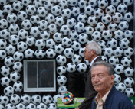
A Global Goalllllll
American artist Jon Winet often uses new media to comment on contemporary media culture. He's previously immersed himself in the realms of soap operas and political campaigns, in collaboration with Margaret Crane, and in his newest endeavor he takes on the mega media spectacle that is the World Cup. Goal 2006 leverages the international attention directed at this sporting event to raise awareness of deeper issues related to globalization. The project takes many forms, including a multilingual website, an SMS/MMS project, and an exhibition to be held June 26-July 5, at Stuttgart, Germany's Rocker 33|Dialekt. The website revolves around 'a virtual football card in 64 versions, featuring updates and RSS media feeds for the participating FIFA countries, original video, audio and photography, and field reports worldwide.' The site successfully mimics the rich, celebratory design style of any other sports page, but each player's card is accompanied by reports of environmental and social challenges specific to that locale, as a result of globalization. The SMS/MMS project allows for phone-based daily downloads and rich text messages with similar information. The sign-up page for this service refers to it as 'media research,' thus implicating Winet's audience in his broader study of the products and processes of media consumption. - Marisa Olson, Rhizome News.
Posted by jo at 03:52 PM | Comments (0)
May 18, 2006
Eyebeam and Wooster Collective
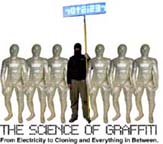
A Night of Technology Based Graffiti
Eyebeam and the Wooster Collective present a night of technology based graffiti projects. Mark Jenkins, the Graffiti Research Lab, and students from the Parsons Geek Graffiti course show a range of experimental work in new materials and techniques for urban communication. Monday, May 22nd, 5:30 – 8pm; Eyebeam, 540 W. 21st Street, New York, NY. [blogged by Joel on reblog]
Posted by jo at 12:02 PM | Comments (0)
April 29, 2006
Online Memorial and a Protest
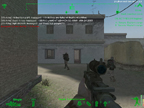
dead-in-iraq
Artist Joseph DeLappe presents documentation of a work-in-progress of online gaming intervention - dead-in-iraq. The project involves connecting to America's Army, the online first person shooter game/recruiting/PR tool of the US Army; DeLappe logs into the game using the screen name "dead-in-iraq" and, rather than have his character participate in the proscribed mission to seek and destroy opponents, DeLappe’s soldier functions as a passive participant. While his soldier is standing in place, DeLappe proceeds to type, using the game’s text messaging system, the name and date of death of all the soldiers who have died in Iraq, one line at a time. The text information appears on all team member’s screens interspersed with other messages from players and a running accounting of the progress of the game. “dead-in-iraq” is eventually killed by opposing players. A new game commences and the process continues. To date, over 300 names have been typed live into the gamespace. The project will continue until the end of the war. This work is intended as an online memorial and a protest.
Previous works in online intervention/gaming performance (Quake/Friends, Howl: Elite Force Voyager, ET tu Sir Alfred) may be viewed on DeLappe's website or by viewing his podcast now available on itunes.
Added on May 5, 2006
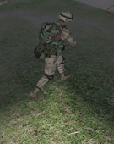
Deadly Games
All too often, public memorials honoring the victims of atrocities fall prey to bureaucratic processes in place to appease the living masses. Joseph DeLappe's newest project represents the work of one individual to honor the thousands of individuals who have now died in the Iraq war. This micro-memorial takes the form of an intervention in 'America's Army,' the online first-person-shooter video game used by the US Army to recruit new soldiers. DeLappe logs into the game with the user name 'dead-in-iraq' and proceeds to use the game's text messaging system to type the names, ages, and dates of death of recently deceased US soldiers in Iraq. Then he does nothing. He simply waits to be shot by other players, dies, and begins the process again, after being 'reincarnated.' Dead In Iraq is a thoughtful co-opting of the tools of digital culture to engage with the political issues raised in an era of high tech war. It is also one of a handful of recent online performances, staged in the diegesis of multiplayer games. The field of 'game art,' itself--of which this live performance is a unique extension--often meets criticism for its perceived lack of seriousness or its indulgence of nostalgia. But DeLappe's evocation of memory, in this game, is no laughing matter. He began the project in March of this year and has already input the names of 250 people killed in action since then. He plans to continue this action until the war ends. Until then, you can view screenshots of his participation in the game, and other users' responses to his messages, on the artist's website. - Marisa Olson, Rhizome News.
Dead in Iraq: It's No Game in Wired.
Posted by jo at 12:47 PM | Comments (0)
April 23, 2006
PORTA2030
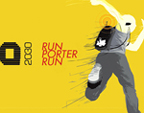
YOU ARE PORTA-PORTER!
April 24 - May 1, 2006 BROADWAY MARKET, London: PORTA2030 is a performative urgency-relay network exercises set within Broadway Market public wifi net-zone. Towards building a portable, sustainable and responsive social network by year 2030, PORTA2030 engages community members as porta-porters for an urgency scenario enactment.
PORTA2030 deploys porta-pack, a mobile network unit that builds on a wifi harddrive (WL-HDD2.5) for multi-faceted transmission. Installed with a 1GB flashcard and programmed in open source codes, the porta-pack functions as a portable data sensing-storage-tranmission unit. A webcam streams images live while an LCD mini-terminal with 4 click action push buttons serve as basic communicative device. The urgency signals triggered by the sensors set in public space further prompt porta-porters' collective action.
Broadway Market (E8, London), known as Market Porters' path for porting produce into the city, is currently under rapid development affected by Hackney Council's regeneration plan. For last two years, physical Porters' Path is implemented with wireless extension provided by the OFF Broadway gallery. PORTA2030 locates Broadway Market as its public performance site with setup of extra access nodes. PORTA2030 updates the porter's path with mobile network porting of communal audio/visual data.
Weeklong performance starts on April 24 with porta-pack dispatch workshop at SPACE media center. During the week, 10 porta-porters engage in networked ommunication. April 29, Broadway market, Porta2030 relay bingo play. May 1, May Day - public screening session with open-air projection: Porta-porters' week and Broadway market related documentaries. For further information please contact now[at]take2030.net
Posted by jo at 01:09 PM | Comments (0)
March 10, 2006
Reclaim the Spectrum
![]()
"Mas Alla De La TV" | "Beyond TV"
Reclaim the Spectrum: A project by José Luis de Vicente for zemos98 Festival [eighth edition], Seville, March 14-18. With anab jain | michelle teran | julian bleecker | usman haque | jill magid | erich berger | jonah brucker-cohen.
"The radio spectrum – the electromagnetic space through which radio and TV broadcasts, mobile phone and GPS signals and WiFi networks circulate - is the real estate of the information society. Its invisible infrastructure is the largest engineering project in the history of man; its gradual colonisation and conquest throughout the 20th century has radically transformed the structure of society, the shape of cities and the relationship between individuals.
In spite of this, there’s a lot we don’t know about the spectrum: who owns it, how it’s managed, who decides how it’s used. Although supposedly a scarce and valuable resource, discussion about the spectrum is not a political priority and its regulation is rarely subject to public scrutiny. While the "Lords of the Spectrum" (the military, broadcasting industries, telecommunications providers) have enjoyed exclusive rights to the most useful frequencies for decades, the comparatively insufficient public frequencies have produced some of the most socially beneficial innovations, such as wireless Internet networks. From many different areas, there is an increasing demand that we begin to understand and manage the frequency system as public space, because we are increasingly taking more and more social processes and dynamics out of the streets and into the airwaves.
Now that contrary standards such as third-generation mobile phone services and wireless are competing for the same users, it is becoming an urgent priority to reclaim the right to make decisions about the most socially fruitful uses of the spectrum. Are more TV stations and video messages on our mobiles really what we need? Do we want technologies that allow us to be participants, or just consumers?
Artists, designers and activists are being the first to make the leap to appropriate Hertzian space and rework it to subvert its ends. Sometimes, by making what occurs in the realm of the airwaves visible, and mapping it to show how in the spectrum the borders between public and private space blur. In other cases, by encouraging the use of wireless networks to create active location-based communities, as used to happen in public squares or parks. And in almost all cases, by showing how our current use of the spectrum depends more on political and commercial decisions than in the full reach of its technical potential.
Somewhere in between the utopian discourse of those who want a commons of the airwaves and those who subvert and hack communication protocols and devices in total rejection of the controlled use of this technology, those who reclaim the spectrum are anticipating a political and social debate that was missing in the 20th century and cannot be postponed in the 21st."--José Luis de Vicente [via]
Posted by jo at 10:42 AM | Comments (0)
February 14, 2006
Reality 10.55 Odense
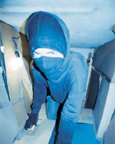
Overview of Contemporary Relational Art
Reality 10.55 Odense showing at Kunsthallen Brandts from February 18 through May 28, 2006 presents an overview of contemporary relational art, a highly critical and democratic art form that often interfaces closely with everyday life realities and is frequently co-produced in close collaboration with the audience. While relational practices have at times been criticised for their close approximation of reality as an unmediated and unedited image, the projects in Reality 10.55 Odense, offer exciting, new and distinctly visible alternatives to art making and to our experience of art and reality.
This exhibition addresses relational practice on several levels, through performative and situational interactions and enactments. Every "spectator" becomes a potential live action participant/co-creator by actual corporeal interaction, expanding, changing, and transforming the pieces in the exhibition according to their own personal preferences and choices. In a slight strategical inflection, situational interactions, interface with specific situations, realities, communities and social activities most often outside the exhibition space. These practices cast an attentive eye onto issues and images that shape our lives and define our perceptions and do not simply replicate, but offer new visions of reality.
Enactments are a very specific category of relational art making that span many forms, including interventions, actions, performances and performative interactions, and propose a rereading through a re representation of the order of things. Accepted histories, common or standard realities, situations, as well as collective and personal identities are given the possibility of a reinterpretation, a re alignment, a re exploration or a re invention.
The participants in the exhibition represent a wide international spectrum, from Australia to Macedonia, from Denmark to the USA. The artists are: AVPD (DK), Ondrej Brody (CZ) and Kristofer Paetau (FIN), Yane Calovski (MAC), Martin Creed (UK), Alicia Framis (SP), FOS (DK), Jeanne van Heeswijk (NLD) and Marten Winters (NLD), Tine Kortermand (DK), PARFYME (DK), Ward Shelley (USA), Andrew Sunley Smith (AUS), Martin Walde (AUT) and Yvonne Droge Wendel (NLD) and Saliou Traore (NLD).
The Tunnel by the American artist Ward Shelley is a good example of a performative interaction. During the entire time of the show, the artist and a crew of workers, named "termites" build a tunnel through the exhibition hall. During this time, the artist lives in the tunnel (replete with a portable toilet). The tunnel is constructed of wood and steel, forming an overhead passage across the space, climbing the building exterior and re-entering through a window. The passage through the tunnel is only large enough to crawl through, ocassionally widening to accomodate for round-abouts. Visitors can join in the building and climb into the tunnel, and might experience a range of emotive sensations, quiet meditation, curiosity, estrangement, fun.
The situational interaction by Yvonne Droge Wendel and Saliou Traore from the Netherlands, involves a large black round ball that suddenly appears in the city. To begin with, this form has no particular meaning. It is simply big, black and soft, and takes up space. Nonetheless, in time as it moves around the streets, alleys, in and around buildings, and as people begin to interact with it, the ball starts to tell a story all on its own. The people of Odense and the black ball become the protagonists-antagonists of an open ended plot. The story develops on the spur of the moment, depending on the curiosity and bewilderment of the co-story teller. In the process "Black Spot" tests the imagination and spontaneity of the citizens of the town.
For this exhibtion we have a guest curator, Maia Damianovic from Great Britain/Vienna, who together with curator Lene Burkard from Kunsthallen Brandts collaborated with the artists on the development of the exhibition and the projects.
Opening : February 17th. 2006
Exhibition: February 18th - May 28th. 2006
Brandts Torv 1 DK-5000 Odense, Denmark
Telephone: +45 65207000 Fax: +45 65207094
For more information, please contact Lene Burkard at tel. +45 6520 7017 or Helle Thylkjaer, PR and marketing at tel. +45 65207021 or mail: helle.thylkjaer[at]brandts.dk. Press images for download: www.brandts.dk
Posted by jo at 12:16 PM | Comments (0)
February 10, 2006
Globalisation/Colonisation

Constructing a practice in the space of Post Autonomy
1st – 30th March 06: Presented by the Bureau of research into Post Autonomy – David Goldenberg, Stefan Beck and the assistance of Giulia Bonali: A series of random, strategic, interventions around London in public and virtual spaces – With contributions from Basekamp, Stefan Beck, David Goldenberg, Interactingarts, Christian Nold, Wim Salki, Stateless Nation, Stevan Vukovic Anabela Zigova.
The project proposes to stage a thought experiment - that looks at the conclusion and by-passing of the tradition of a Euro-centric art practice so that we can then go onto construct an entirely new model – against the backdrop of Globalisation - under the umbrella term of Post Autonomy.
Our entry point’s into the construction of Post Autonomy is via addressing the processes and issues of “Globalisation” and “Colonisation” – in this case as present within London with its claim to be a Global City. In order to make visible the dynamics and mechanisms of Globalisation, Colonisation, and the role that art plays in this process, the contributors will come together through the exploration of a participatory methodology [which can be found on wiki page] to design a series of strategic interventions into both the visible and de-material fabric of London.
The project aims to confront complex and difficult issues which are neither easy to frame within the language and concepts currently at our disposal, nor for that matter, once they are brought to the surface easy to resolve. For instance –
“How much of the European tradition of art and Mind set is it possibleto jettison?”
“How is it possible to use the material generated by the interventions to map the dynamics of Globalisation and Colonisation throughout London along with arts involvement?”
“How do we then use this material to go onto construct a Post Autonomous Practice?”
In addition to the interventions there will also be an on-going series of on-line debates along with dinners and discussions at venues around London.
The programme of activities can be found from the end of February on: www.postautonomy.co.uk www.nodel.org www.interactingarts.org
For further information and documentation on any aspect of the project
please contact Giulia Bonali on giulia[at]postautonomy.co.uk
Information on the Bureau of research into Post Autonomy and the launch of the Post Autonomy website.
The beginning of 2006 sees the launch of the Bureau of research into Post Autonomy – dedicated to the research, archiving and promotion of all aspects of Post Autonomy.
This will be the principle vehicle for exploring new models and thinking into a contemporary cultural practice. The centre for all research, information, archiving, promotion and operating will be the new website. This year will also see a continuation of a series of projects whose purpose is to both open out and map the uncharted territory and domain of Post autonomy – Beginning with “Constructing a practice in the space of Post Autonomy” In March as part of Node London – information can be found on http;//www.nodel.org The project continues on from the “Space of Post Autonomy” which took place as part of the Open congress event at Tate Britain in October 05 Information on further projects will be posted at regular intervals throughout the year – while at the same time information – plus photographic documentation and texts on past projects - can be found on the Post Autonomy website.
Posted by jo at 03:55 PM | Comments (0)
February 08, 2006
First Monday, Special Issue #4:

Urban Screens
Urban Screens: Discovering the Potential of Outdoor Screens for Urban Society, Pieter Boeder, Geert Lovink, Sabine Niederer, and Mirjam Struppek, eds. Table of Contents: Introduction: Discovering the potential of outdoor screens for urban society by Pieter Boeder and Mirjam Struppek; Urban screens: The beginning of a universal visual culture by Paul Martin Lester; The politics of public space in the media city by Scott McQuire; The poetics of urban media surfaces by Lev Manovich; Interpreting urban screens; by Anthony Auerbach; Story space: A theoretical grounding for the new urban annotation by Rekha Murthy; The urban incubator: (De)constructive (re)presentation of heterotopian spatiality and virtual image(ries) by Wael Salah Fahmi; Urban screens: Towards the convergence of architecture and audiovisual media by Tore Slaatta; Towards an integrated architectural media space by Ava Fatah gen. Schieck; Art and social displays in the branding of the city: Token screens or opportunities for difference? by Julia Nevárez; Hijacking the urban screen: Trends in outdoor advertising and predictions for the use of video art and urban screens by Raina Kumra; For an aesthetics of transmission by Giselle Beiguelman; Intelligent skin: Real virtual by Vera Bühlmann; Programming video art for urban screens in public space by Kate Taylor; Augmenting the City with Urban Screens by Florian Resatsch, Daniel Michelis, Corina Weber, and Thomas Schildhauer.
Introduction
Welcome, gentle reader, to this First Monday Urban Screens special issue, the first publication of its kind. With the advent of digital media, the global communication environment has changed dramatically. In the context of the rapidly evolving commercial information sphere of our cities, especially since the 1990s, a number of novel digital display technologies have been introduced into the urban landscape. This transformation has intersected with other major transformations of media technology and culture over the last two decades: the formation of distributed global networks and the emergence of mobile media platforms such as mobile phones. Their cumulative and synergistic impact has been profound. Convergence of screen technologies with digital communication technologies such as GSM, RFID, Internet and database technologies has lead to the emergence of a new, interactive and increasingly pervasive medium: Urban Screens.
Urban Screens can be defined as interactive, dynamic digital information displays in urban environments. Their genesis is the consequence of two parallel technological developments: evolution and subsequent growth in magnitude of the traditional display screen, and its subsequent convergence with other digital media technologies. Forms and appearances range from large daylight compatible LED billboards, plasma or SED screens, information displays in public transportation systems and electronic city information terminals to dynamic, intelligent surfaces that may be fully integrated into architectural façade structures. Their introduction in the urban environment poses new, unparalleled challenges and opportunities, which we will explore
and document in this issue.
Currently, the primary purpose of this new infrastructure appears to be the management and control of consumer behaviour through advertising. Commercial companies are starting to realise that digital billboards are a powerful medium to communicate their goals and missions, in line with the new paradigms of the digital economy. Interconnected Urban Screens have tremendous potential to serve as a platform for information exchange. Such large networks are already being developed Russia, China, USA and South America, where Urban Screens are rapidly becoming a key element in commercial and government informational infrastructure. The implications for the public sphere are profound. Information density per square metre is increasing, yet at the same time individuals have less control than ever over the actual format and content of that information.
Public space has always been a place for human interaction, a unique arena for the exchange of rituals and communication. Its architecture, being a storytelling medium itself, plays an important role in providing a stage for this interaction. The ways in which public space is inhabited can be read as a participatory process of its audience. Its (vanishing) role as a space for social and symbolic discourse has often been discussed in urban sociology. Modernisation, the growing independence of place and time and individualisation seem to devastate traditional city life and its social rhythm. The Urban Screens project explores the opportunities for opening this steadily growing infrastructure of digital screens, currently dominated by market forces, for cultural content, along with its potential for revitalising of the public sphere.
Urban Screens 2005 was the first international conference that was solely dedicated to the emerging Urban Screens phenomenon. Presentations covered a broad spectrum of topics and issues, ranging from critical theory to project experiences by researchers and practitioners in the field of art, architecture, urban studies and digital culture. It addressed the growing infrastructure of large digital moving displays, which increasingly influence and structure the visual sphere of our public spaces. Urban Screens 2005 investigated how the currently dominating commercial use of these screens can be broadened and culturally curated: can these screens become a tool to contribute to a lively urban society, involving its audience interactively?
A new medium that is digital, interactive and pervasive
What we are seeing is the emergence of a new medium that is digital, global and local, interactive and pervasive at the same time. What happens if the convergence of new technologies such as Internet, database and mobile technologies suddenly enable interactive access to the visual streaming of these digital surfaces? Can it revitalise the public sphere by creating an information-dense urban environment or is it a major threat? How does the growing infrastructure of digital displays influence the perception of the visual sphere of our public spaces? Metaphorically speaking, can or do Urban Screens already function as a mirror, reflecting the public sphere?
The Urban Screens project aims to address these questions in a transdisciplinary debate and present new approaches to answering the most pushing urgent questions, exchange experiences and create and maintain a thematical network around the subject for initiating future collaborations. The Urban Screens 2005 conference in Amsterdam addressed the existing commercial predetermination and explored the nuance between art, interventions and entertainment to stimulate a lively culture. Other key issues were mediated interaction, content, participation of the local community, possible restrictions due to technical limits, and the incorporation of screens in the architecture of our urban landscape.
Urban Screens 2006: Demonstrating the potential of public screens for interaction
Building upon the results of Urban Screens 2005, the 2006 Urban Screens 2006 conference (Berlin, October 5-6) will elaborate on the discussion and develop the broad spectrum of possible formats and usage of this emerging new media infrastructure. Urban Screens 2006 will be a platform for demonstrating the potential of public screens for interaction in a trinity of infrastructure, content and cooperation models. Interconnected topics will be the politics of public space, multimedia content as a service for an array of portable devices, urban neighbourhood reactivation, interaction design of urban screens, standardisation and integration in the urban landscape. Using existing screens infrastructure as well as future 'Urban Screens furniture' in the urban space of Berlin, we will demonstrate the impact of Urban Screens, their contextualisation and situatedness. This unique accumulation of projects will serve as a playground and research field for practical observations on the interplay of screen technology, content, location and format.
Urban Screens 2007: Expanding the potential of content for community
screens
Urban Screens 2007 is currently under preparation in collaboration with BBC Public Space Broadcasting. While Urban Screens 2006 will have 'brick & mortar' accents, Urban Screens 2007 will have a distinct focus on the potential of journalistic content: issues surrounding the production and display of media content for Urban Screens, as well as adaptive reuse of 'old' content for new media will be explored in detail. Key issues and topics will include Public Space Broadcasting (PSB), the politics of public space, mediated interaction and participation, as well as experiments with new participatory formats. PSB can energise the hearts of cities by bringing together communities to share events and broadcasts, creating public news and information points that double as local meeting places. Largely due to the innovative work of the BBC, PSB is starting to prove its potential to provide an outlet for community and educational activities, public service information, visual arts, digital innovation and local content production, revitalising the public sphere.
We hope that you will share our excitement.
Posted by jo at 09:09 AM | Comments (0)
February 07, 2006
RC2|Relational Clothing + collecting fragments

Intervention by Johannesburg Artist Jose Ferreira
As covered by Carine Zaayman on Artthrob, the Very Real Time project launched its second phase at the Drill Hall (Point Blank Gallery, downtown Jozi) this past weekend, hosting, "Two panels of selected speakers… chaired by Gregg Smith and …an intervention by Johannesburg based artist, Jose Ferreira."
This work consists of a series of journeys and a garment. Appearing to be an ordinary overall, it unfolds and translates into various forms, provoking unusual relationships. It is at once a vessel for shelter, a protective unit, and gatherer of ephemera. …The focal point of the work is to extricate new readings of social interactions in this urban context that may have become accepted, habitual and even suspicious. The work is an exploration of urban survival, self-preservation, and a dreaming of possibilities. …My intention is to make a work that embraces the multiplicity of an urban Johannesburg experience. [blogged by nathaniel on nathanielstern.com]
RC2|Relational Clothing + collecting fragments
This work consists of a series of journeys and a garment. Appearing to be an ordinary overall, it unfolds and translates into various forms, provoking unusual relationships. It is at once a vessel for shelter, a protective unit, and gatherer of ephemera. A series of 'walks' through the downtown area of Johannesburg will act as a catalyst, and the user agent provocateur of new and exploratory relationships. The outfit is likely to highlight existing issues like patterns of social discord. The wearer will gather information in various forms, both physical and digital, 'embodying' an experience of the inner city. The focal point of the work is to extricate new readings of social interactions that may have become accepted and habitual. The work is an exploration of urban survival, self-preservation, and a dreaming of possibilities. The garment also has interesting references to its origins. During medieval times a one-piece garment was used by jesters and alchemists as a symbolic outfit which in their view, were aids to avoid disturbances in the flow of energy in the body.
This is a project that imagines technology as a parallel universe using desire rather than scientific quantification as a measure of fulfillment. Using these vectors of reference we are pondering questions like, is it possible to construct a prototype garment that would in itself become a living organism, an amalgamation of experience and live interconnected parts? Without being too preoccupied with the aesthetic associations of fashion the work articulates the relationship between the individual and a social body, and the eminent overlapping of the two. It seeks to articulate in particular a very simple ethical question, what is the nature of the distance between my body and the world?
The garment itself will look ordinary, with various 'functions' pervasively located within an exterior shell. The apparatuses on the garment are really a means to augment it with various loci of information - a way of capturing and interpreting data. The costume itself will function as an object with various different utilities, paraphernalia that is geared toward social provocation. The work also remains functional without any of the electronic components, even if the technology were to be shut down completely it would remain user friendly. Various components of the outfit will become more apparent or 'emerge' according to different situations. It will transform, unfold, adapt and reconfigure according to the situational constraints of various contexts, and become 'infected' by its surroundings. The work is essentially about potential, that existing between the individual and a larger social body, and the way one negotiates personal space within the broader collective of a society, community or group. Interaction with the immediate context will be the point of reference for the interventions, which will be in the vicinity of the Drill Hall. In that way it will function as a type of urban survival kit and social integration tool - an activator of real and imagined spaces.
There are examples where clothing has been used as a provocative agent like Lygia Clark's overtly political outfits criticising Brazilian authorities and censorship in the late sixties, to Laurie Anderson's performative apparel. In many cases, due to the bulky apparatuses of the times, the instruments were clearly visible within and without the garments. Today, with the advent of nano technology, much of this instrumentation has become stealthy, integrated in some form or another into the structure of the object. This work is about exploring possibilities in which those technologies can be used to interrogate notions of difference, and similarity, by looking at how people are constantly mapping out their existence in urban environments. The idea is to construct a garment that uses various devices embedded into its structure, to record, manipulate, and transmit information about that person and their surroundings. This information will not be entirely statistical but rather more ephemeral. It might for instance gather relational information about the proximity of other persons and buildings - perhaps an Auric Transmitter? Perhaps it will measure presence?
By looking into subtle variations in locality and behaviour it might be possible to map an individuals journey. How does it look/feel to experience someone else's journey as they walk through congested areas, isolated landscapes, in the proximity of others/buildings etc? What would a visual manifestation of this journey look like? How are the boundaries between people perpetuated, and how do they change in an urban environment where unconsidered situations are forced upon one another? How can the garment be used to create a space of seclusion allowing the subject immediate respite from their surroundings? Can it become a cipher associated with security, like a temporary safety net?
My intention is to make a work that embraces the multiplicity of an urban Johannesburg experience. In collating information that is ephemeral and open to multiple interpretations, I hope to engender a more imaginative, playful interpretation of that experience. The notion of venturing into possible contested spaces and coalescing the experience into other activities has an established history; activities like Capoeira for instance, manifest out of the frission stimulated by potential conflict - turning one activity, associated with aggression, into a more poetic form of expression.
RC2 is a work made possible through collaboration. This process has been facilitated by Strangelove, a fashion design duo that have worked on several projects. Tegan Bristow, an artist working in Digital media, has spent much of her time devising ways in which the digital components might function. And Dorothee Kreutzfeldt who has put immense energy into curating the event.
Posted by jo at 11:01 AM | Comments (0)
un_wiki
Democracy or Oligarchy
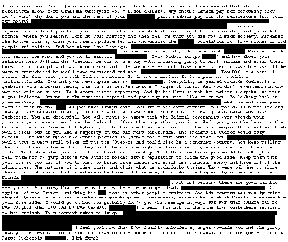
un_wiki, by Wayne Clements, gets quotes from Wikipedia the free encyclopedia’s Deletion Log: http://en.wikipedia.org/w/index.php?title=Special:Log&type=delete. The Deletion Log is a list of all the pages that have abused Wiki's democratic remit; it is the last stop on the way to destruction. It has small amounts of the offending texts. Clements uses a Perl script to get them and throw away the rest.
un_wiki explores the antagonism between formal democracy (anyone may edit a page) and actual oligarchy (sysadmins may delete or revert a page). [via Loreto Martin]
Posted by jo at 08:50 AM | Comments (0)
February 02, 2006
The Exchange Project
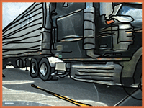
Performance of Technology Tracked Free Trade
The Exchange Project--by Nancy Nisbet--is an artistic inquiry that uses cultural resistance to unsettle questionable relationships between international politics, technological surveillance, and identity construction. Specifically this project addresses 1. The politics of trade agreements such as the North American Free Trade Agreement (NAFTA), 2. Myths of increased national security through technological surveillance of people and commodities and 3. Identity construction based on collections of economic and surveillance data. One outstanding feature of the Exchange project is a cross-border performance that combines Radio Frequency Identification (RFID) surveillance technology, a full-size transport truck, and all of Nisbet’s personal belongings.
In this sustained performance, Nisbet’s things will be inventoried, radio frequency tagged and freely traded with individuals encountered during the six month trip that circumnavigates Canada, the United States and Mexico. This project exchanges the studio for the roads, truck stops, border crossings and cities of North America. “Exchange” creates through the untidy weaving of politics, surveillance technology and identity construction. From the spaces between these coarse threads will emerge resistance, solidarity, vulnerability and moments of human connection.
BIOGRAPHY: Nancy Nisbet is a Vancouver-based artist. From a disturbing paintball gun performance enacting the chaotic fluctuation in the cost of crude oil during the lead up to the US-led War in Iraq/ War on Terror to the surgical implantation of 'identity' micropchips into her hands, much of her work considers the political, the technological and the personal. Of specific consideration in her mixed-media work are issues of power, economics, and surveillance and their cultural influences on entertainment/leisure, identity and community. Exchange 2006 is a large scale project currently underway.
Nisbet received her MFA in Photography from the California Institute of the Arts. She is currently Assistant Professor of Visual Art in the Department of Art History, Visual Arts & Theory at the University of British Columbia.
Launching May 1, 2006 at the Richmond Art Gallery. More information here [PDF]
Posted by jo at 05:00 PM | Comments (0)
January 03, 2006
PARK(ing)

Transform a Parking Spot into a PARK(ing) Space
PARK(ing) is an investigation into reprogramming a typical unit of private vehicular space by leasing a metered parking spot for public recreational activity. We identified a site in an area of downtown San Francisco that is underserved by public outdoor space and is in an ideal, sunny location between the hours of noon and 2 p.m. There we installed a small, temporary public park that provided nature, seating, and shade.
Our goal was to transform a parking spot into a PARK(ing) space, thereby temporarily expanding the public realm and improving the quality of urban human habitat, at least until the meter ran out. By our calculations, we provided an additional 24,000 square-foot-minutes of public open space that Wednesday afternoon. Build your own PARK(ing)! View our handy construction manual. [via Guerrilla Innovation]
Posted by jo at 07:13 PM | Comments (0)
December 07, 2005
Wired
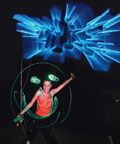
Graffiti Hackers
Graffiti Hackers: Text-message projectors. Paintball printers. Wall-crawling robots. The new crew of tech taggers makes a name for itself. By Sonia Zjawinski
"...FLASHLIGHT BRIGADE: Who: PIPS: lab art collective; Where: Amsterdam; How: Audience members are asked to draw using a variety of light sources: an aerosol can rigged with a 3-volt bulb for producing skinny lines, a battery pack attached to a handheld 12-volt lamp to make thicker strokes, or a 220-volt spotlight for larger-than-life beams. A digital camera set for a 30-second exposure captures the light trail. A brief flash ends the shot, revealing the artist and capturing the scribbled illustration. (Pablo Picasso did much the same thing for photographer Gjon Mili in 1949.) Stills and video of the installation, called Lumasolator, are displayed during the performance and uploaded onto the group's Web site. Word: "Graffiti belongs to the people, but not everybody is allowed to express themselves on the streets," says PIPS:lab cofounder Keez Duyves." Continue reading >>
Posted by jo at 12:48 PM | Comments (0)
December 05, 2005
ReTag
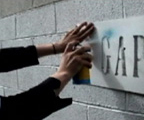
Retroactive Logo Distribution
The 'brand', i.e. the corporate identity symbolized by the logo, is the visual capital of the corporation and their precise and prudent strategy is to cautiously distribute it through our visual scanning space. ReTag is a project hosted on the Conglomco collective's server and it proposes a tactic for boycotting some brands through an indiscriminate multiplication of the logo's presence that would saturate our tolerance for repetitive advertisement. To contribute to this task some logos are available to download, and then they'd printed and transformed in stencils, and then spray them in the most familiar places, making a very bad impression, as if the same brands have crossed the line. Even if the project is at an embryonal level compared to a very different work as NikeGround, it uses the same strategy: pushing the as far as possible the so-called 'brand awareness', aiming at transforming it in a tedious and excessively untimely presence. [via ]
Posted by jo at 10:53 AM | Comments (0)
November 07, 2005
DiY SURVIVAL HANDBOOK

Do It Yourself Survival
Do it yourself survival is a collection of essays, tips and case studies collated from an online call for participation by C6. The eclectic mix presented within these pages shows the breadth and current diversity of art/activism practice today from around the world. Whether that is creating wireless networks, pissing on national monuments or building cardboard friends, it is certain that these submissions show that practitioners are taking their work to new spaces and audiences, redefining, through the engagement with the community, what we have considered to be ‘art’.
Have you ever wanted to stop annoying mobile phone conversations encroaching on your space? Or to learn how to turn discarded computers into a running network? Or to set up your own street television? Or even how to discover how to fund your art projects with unheard of strategies? Now you have the chance to learn how!
DiY SURVIVAL is a compilation of cutting edge strategies, methods and techniques of DIY art, delivering a wide range of practices, actions, events, enterprises and issues which all have to do with the art of DIY, with forms of media subversion and the intelligent sabotage of cultural markets.
DiY SURVIVAL HANDBOOK delivers a mix of Theory, Case Studies and "How To..." whose aim is to circulate radical knowledge, to disseminate practical know-hows and to promote collective awareness against the ego-trip of The Artist.
Among the topics: pissing on monument as form of urban intervention; how to create a wireless node; mobile art gallery; Strategies of audience engagement; techniques of mobile phones hijacking; the creation of subversion in the supermarket; brandalism and street art; Trashware; street Television; collaboration as art practice, plus essays on avant gardes, Media Pop Art, net art, the hyperconnected multitude, teaching cultural activism and much more.
DIY SURVIVAL, a snapshot of the DIY art slash activism field, an instant book which photographs individual and collective realities involved in redesigning the tactics of DIY art around the globe.
Contributors:
Anna Banana, bluloop, bravenewbrum, Gordon Brown, C6, Ruth Catlow, CCTV Nuts, Hernani Dimantas, Eric Doeringer, Ryan Griffis, The Institute for Infinitely Small Things, International Union of Free-Thinkers, HACKLAB_pg, Tsila Hassine, Amanda Janis, Loca, Luna Nera, Motherboard, Nonna Papera, Gabor Papp & Ricardo Contreras, Robert Praxmarer, Leonardo Ramos, slavina feat ctrl C+ ctrl V, Truck art, The vacuum cleaner, Marcus Verhagen, Ricardo Miranda Zuñiga
Printed on Demand by www.lightningsource.com in the Uk and USA. [via netbehaviour]
Posted by jo at 08:45 AM | Comments (0)
October 25, 2005
Morgan Schwartz
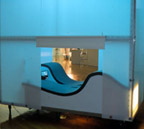
Chance Encounters, Deliberate Interventions
Pursuit of Happiness: Porta-Sky is an urban sanctuary and think tank for two. Periodic trips into the dark relaxation chambers of movie theaters became a routine survival technique for the subjects of modern society. In our post-modern world, where work and leisure have collapsed, the Internet has become a space of convergence. "Porta-Sky" is a physical corollary – a non-space, a hallway from here to there. Providing a personal view of a virtual sky, this video projection space offers alternate imagery to an anxiety-ridden sky. The unit features dual, synchronized DVD video projections, a deployable surveillance blimp and custom designed form-fitting reclining seats.

Situated in the Gallery@Green St (adjacent to the Green St. Subway station on the Orange Line in Boston, MA), Pressure was a site specific installation where computer controlled sensors manipulated the sights and sounds of daily commuting to address issues of accelerated culture and the evolving metaphors for speed and progress. Pressure seeked to explore the psychology and physicality of individuals in the contemporary urban landscape.
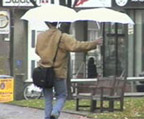
umbrellaSpace is an urban gesture. It is a design solution to a social problem. The intervention adjusts perceptions of boundaries and comfort held by observers on the street. This umbrellaSpace adopts the umbrella as a familiar, recognizable, urban form and recreates it. A permeable space of interaction is transformed from a private, individualized space. An individual in the urban sphere operates this new umbrellaSpace. He or she can choose to invite people on the street into this space. I’m interested in exploring the range of responses this intervention precipitates on the street: sociological, visual, performative. Schwartz is looking for people interested in operating the UmbrellaSpace as well as videographers and photographers interested in documenting the events.

Currently in development at the Berwick Research Institute and on exhibit at Glowlab: Open Lab, Whether/Weather consists of aerial beacons that are dispersed into the weather system. The beacons are helium powered with LED blinkers. Like seeds, these beacons drift with the wind and carry information/stories/memories that hopefully germinate wherever they land. Whether used by an individual or a large organization, the project explores the idea of memory and memorialization through ephemeral and participatory public art. The person who happens upon one of the beacons that has landed, will encounter a message and the option of logging into a website to find out more about where/why the beacon originated. They can contribute their own response at this point and even decide to re-launch the beacon. By logging when/where the beacons are launched and when/where they are found Schwartz is visualizating whether/weather patterns. He hopes that the project will function like a collective 'message in a bottle' and tap into romantic and poetic possibilities of communication and chance discovery.
Posted by jo at 10:02 AM | Comments (0)
October 10, 2005
Ballettikka Internettikka:
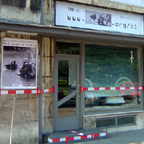
BEO Guerrillikka in Belgrade
Ballettikka Internettikka: BEO Guerrillikka [Bureau NetBallet] by Igor Stromajer & Brane Zorman (Belgrade, Serbia, 2005) (live internet broadcasting); Thursday, Oct 13th, 2005 at 9 PM GMT+1 (Berlin/Paris/Belgrade local time); Duration: 20 minutes (time tolerance: +/-4 minutes); Location X, Belgrade, Serbia; # Latitude: 44.79345 N, Longitude: 20.45340 E, Terrain Elevation: 110 m; Location will be made public on Oct 13th at 8:50 PM GMT+1 (10 minutes before the performance starts; due to security reasons).
Ballettikka Internettikka is an ongoing artistic study of the internet guerrilla performance. After invading the Bolsh.oi Theatre in Moscow (March 2002), and La S.cala in Milan (November 2004), Stromajer and Zorman will perform a new guerrilla net ballet, this time in another theatre house in Belgrade, Serbia.
Live internet broadcasting of the net ballet performance will start on October 13th 2005 at 9 PM GMT+1 and will last 20 minutes (+/- 4 minutes); the location will be made public on Oct 13th at 20:50 GMT+1 (10 minutes before the performance; due to security reasons).
They will enter the office (brain center) of the Artistic Director [location X], here the hardest artistic decisions to run the institution are taking place. The artists will use remote-controlled toy-robots with wireless web cameras.
Watch and listen live to internet guerrilla bureau ballet at http://www.intima.org/bi/beo
(Oct 13th 2005)
Artists will use low-tech mobile and wireless equipment for the invasion and live broadcasting (portable computers, mini digital camera, MP3 audio systems, mobile GPRS telephones etc). A laptop and MiniDV cam, together with Webcam32 (version 6.0) software will be used for broadcasting the video signal (running over Intima Virtual Base FTP server). Another laptop and MP3 player with online interface SHOUTcast (version 1.8.3/win32), will be used for live sound broadcasting (running over Beitthron FTP server). A local GSM mobile phone operator will be used for GPRS mobile internet connection.
Action Timetable / Belgrade, Oct 13th 2005 / GMT+1:
20:55 Equipment check on the parking place in front of [Location X]
20:57 Turning the computers on
20:59 Establishing wireless Internet connection (GSM 900/1800)
21:00 Start of live Internet broadcasting (-2) and final equipment check
21:01 Entering the building of [Location X]; climbing the stairs--3rd Floor (-1)
21:05 Entering the office of the Artistic Director [X] (3rd Floor / left): (0)
starting live bureau net ballet (10 min)
21:15 End of live bureau net ballet: exiting the office; descending the stairs (+1)
21:19 Exiting the building of [Location X]
21:20 Terminating wireless Internet connection at the parking place outside
[Location X] and turning off the computers (+2)
21:22 Taking the taxi to the O3ONE Gallery
Dancing a wireless bureau net-ballet in the office of the Artistic Director location X] represents a big conceptual and strategic challenge to the Intima Virtual Base, therefore the preparations have been taken serious, safety measures have been calculated, and the previous experience from the Bolsh.oi Theatre in Moscow and La S.cala in Milan has been very welcome.
Ballettikka Internettikka: BEO Guerrillikka is supported by Municipality of Belgrade, Ministry of Culture of the Republic of Slovenia, Ministry of Culture of the Republic of Serbia, O3ONE Gallery in Belgrade.
Bureau NetBallet Operators: Igor Stromajer & Brane Zorman
Bureau NetBallet Composer: MC Brane vs. BeitThroN vs. Thronus Sound System
Theoretical Adviser: Bojana Kunst
Curator: Ana Vujanovic
Executive Producer: Jelena Knezevic
Computer Programming: SM NORT
Co-produced by Intima Virtual Base (Slovenia) and TkH Center for the Theory and Practice of Performing arts (Belgrade)
[] [] []
Ballettikka Internettikka was presented in noumerous galleries and museums of contemporary art worldwide (from 2002 to 2005) including Le Centre national d'art et de Culture Georges Pompidou - Musee national d'art moderne in Paris, 15. Stuttgarter Filmwinter in Stuttgart, Centro em Movimento in Lisbon, FILE 03 - electronic language international festival in Sao Paulo, Titanik Gallery in Turku (Finland), P-10 Gallery in Singapore, IMPAKT festival in Utrecht (The Netherlands), Thailand 3rd New Media Arts Festival in Bangkok, Cork Vision Centre - Cork Cultural Capital of Europe 2005 (Ireland) and CEC ArtsLink in New York.
[] [] []
About the authors:
Igor Stromajer
http://www.intima.org
is an mobile intimate communicator. He researches tactical emotional states and traumatic low-tech strategies. He has shown his work at more than a hundred exhibitions in forty-two countries and received a number of awards. His works are included in the permanent collections of the Centre Georges Pompidou, Paris; the Museo Nacional Centro de Arte Reina Sofía, Madrid; Moderna galerija Ljubljana, Slovenia; Computerfinearts Gallery, New York and others.
Brane Zorman
http://www.ljudmila.org/beitthron
is a composer and sound manipulator. Between 1982 and 1986 he was frontman for the Slovene punk group O!KULT. He is a pioneer of Slovene techno scene. Since 1987 he has been composing music for both Slovene and international theatre, dance and multimedia performances and projects. and has made guest appearances throughout Europe. Recently he works with Irena Pivka on a series of audio-visual installations ZONE.
Intima Virtual Base - Institute for Contemporary Arts
Belgrade: +381 64 4200614
Slovenia: +386 41 703291
igloo [at] intima.org
Posted by jo at 11:15 AM | Comments (0)
October 05, 2005
Mobile Phone Abusers Anonymous
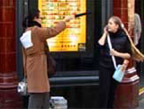
Town Crier
Mobile Phone Abusers Anonymous, a project by Hwa Young Jung, takes a critical look at mobile technology and how it influences social behaviour. She re-engineered a series of mobile phoness to challenge the idea of "being in touch".
One of MPAA performances is Town Crier. The Crier, equipped with micro-phone camera, transmits overheard mobile phone converstaions/visuals to the radio in the room. She picks conversations in public places to question the idea of inhabiting two spaces at once, and the effect on others who share our physical space. [blogged by Regine on we-make-money-not]
Posted by jo at 10:20 AM | Comments (0)
September 30, 2005
OpenStreetMap
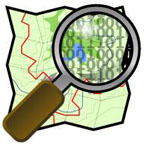
Cartographic Resistance
OpenStreetMap (OSM) is a project aimed squarely at providing free geographic data such as street maps to anyone who wants them. This is because most maps you might think of as free actually have legal or technical restrictions on their use, holding back people from all walks of life who would like to use a map for one reason or another.
OpenStreetMap is (or is almost) a free editable map of the whole world. It is still being written. OpenStreetMap allows you to view, edit and use geographical data in a collaborative way from anywhere on Earth. It comes in three major flavours: 1. Viewer--allows you to browse a map like any other; 2. Applet Editor--allows you to enter new data in your browser. Streets, points and areas can be entered and given metadata like names and whether cars or bikes can travel on them. You can upload GPS traces you've made and also edit the types of data you associate with the geographical data. You have to log in for this, so that the server can keep track of things; and 3. Home editor--this is for more advanced users who want more flexibility and prefer a dedicated application for editing data. [via]
Posted by jo at 09:23 AM | Comments (0)
September 28, 2005
MayDay NetParade
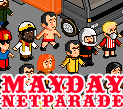
Political Videogames Against the Dictatorship of Entertainment
The MayDay NetParade--by Molleindustria--is a virtual demo that runs thru a heavily guarded and branded city put under siege by insurgent legions of brain+chain+temp workers and assorted anarchists, commies, queers and greens. The marching avatars are digital simulacra of today's exploited masses of neoliberalism: précaires, precari@s, precari, cognitarie, contingent knowledge and service workers. We are a mixed bunch, a heterogeneous multitude of precarious jobs and lives. Yet we have not spawn out of fordist assembly chains, but out of dystopian retail chains and office spaces. Why don't you give your pictorial contibution to this multicolored parade, and reclaim that visibility that mainstream media, unions, parties are denying us? Make yourself heard! Voice your anger and/or irony! You will be able to be part of a piece of collective net art. But do it fast, cos after May 1st, the NetParade will remain visible online, but it will no longer be possible to join. By clicking on JOIN, you'll be able to create your avatar, singular and (un)crazy as you want it to be. You'll have to answer a few multiple choice questions first, but these will be totally anonymous, private and dissociated from your avatar.

About Molleindustria
We can no longer consider videogaming as a marginal element of our everyday lives. In recent years, the turnover of the videogame industry has exceeded that of cinema, and there are a growing number of adult and female players. There are more frequent overlaps with other media: there are videogames for advertisements (advergames), for educational purposes and for electoral propaganda.
How did videogames become such a central element of the mediascape? During the second half of the nineties, major entertainment corporations extended their activities in this sector and extinguished or absorbed small producers. Now videogames are an integral part of the global cultural industry, and they are in a strategic position in the ongoing processes of media convergence. These developments inhibit the political and artistic emancipation of this medium: every code line is written for the profit of a big corporation.
One solution: Gamevolution! We believe that the explosive slogan that spread quickly after the Anti-WTO demostrations in Seattle, "Don't hate the media, become the media," applies to this medium. We can free videogames from the "dictatorship of entertainment", using them instead to describe pressing social needs, and to express our feelings or ideas just as we do in other forms of art. But if we want to express an alternative to dominant forms of gameplay we must rethink game genres, styles and languages. The ideology of a game resides in its rules, in its invisible mechanics, and not only in its narrative parts. That's why a global renewal of this medium will be anything but easy.
Molleindustria is an italian team of artists, designers and programmers that aims at starting a serious discussion about social and political implications of videogames. This will involve media activists, net-artists, habitual players and critics and detractors of videogames. We chose to start with online gaming in order to sidestep mainstream distribution channels and to overcome our lack of means. Using simple but sharp games we hope to give a starting point for a new generation of critical game developers and, above all, to experiment with practices that can be easily emulated and virally diffused.

Also, see //////////fur////: fighting massive-single-user-isolation, //////////fur//// develops art entertainment interfaces for multidimensional multiuser involvement: software-programs in mechatronic artefacts that create dynamic action-spaces for two or more participants. [via]
//////////fur////'s guiding idea is the alternative interface which goes beyond providing solely a visual navigation, manual control and massive single-user isolation.
Posted by jo at 08:47 AM | Comments (0)
September 18, 2005
Glowlab News
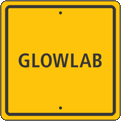
GLOWLAB.04 :: FORGOTTEN and more
GLOWLAB.04 :: FORGOTTEN--Our latest issue is now online, and features some great new projects by Glowlab and guest artists, including:
:: kanarinka--12 Inches of Weather; Weather experiments on the body :: Sharilyn Neidhardt --Into the Groove; Interview with musician and audio archivist Steve Espinola :: Emily Conrad--Lost Phone: 18,900 Google Entries; Lost phone in the back of New York City taxi. Last Friday, around 1am. It must happen all the time :: Sal Randolph--whereyouare; Join in documenting the endangered, lost, or ephemeral beauties of your neighborhood. whereyouare is a participatory experiment, mixing collaborative multimedia, folksonomy tags, and rss feeds to build a portrait of places that matter to us :: Holly Tavel--Xanadu Revisited; Two years on, Xanadu gives up the ghost.
With special guests: Leah Dilworth :: Lost and Found at the City Reliquary; Tour the City Reliquary, Brooklyn's store-front museum dedicated to civic pride and all around good neighborliness; Tianna Kennedy :: On Forgotten, Neglected, and Discarded Objects and Subsequent Utopian Projects Or, the Meandering Story of EV, which recounts the amusing first sally of the ingenious crew as they dragged a thing that had been forgotten from the Bronx to the Lavender Lake; Michele Gambetta :: The Rider Project 2005; The RIDER Project has been created by artists who rent a Ryder Company truck, retrofit it with walls, gallery lights, a generator for electricity, and create a mobile gallery to display art throughout N.Y.C.; Petr Kazil :: Urban Spooklights; Who wouldn't get excited by the appearance of a mysterious light in the distance - in a place where no light is expected?
Glowlab: Open Lab, curated by Christina Ray: A nine-week-long psychogeography festival and exhibition; October 14 through December 11.
Please join us this fall as we head up to Boston for our show at Art Interactive, a non-profit arts space dedicated to contemporary, experimental and participatory artwork.
In Fall 2005, Art Interactive is conducting a nine-week-long experiment. We have invited artists affiliated with Glowlab, a network of psychogeographers, to use the Central Square neighborhood as the site of their research and fill the exhibition space with the results of their investigations. PSYCHOGEOGRAPHY, a term coined by the Situationist International in the 1950s and appropriated by contemporary artists, is used to describe projects that produce affect in relation to the geographic environment. Rather than making maps in the traditional geographic sense, these artists utilize maps and geography to conduct located experiments with (among other things) people, trash, bikes, clothes, the sky and the gallery space itself. Often making use of mobile technologies and existing in the hybrid spaces of the Internet and the physical world, their projects produce new understandings of location and identity as shifting, fluid, singular and irreducible.
Central Square, Cambridge, MA, will never be the same again. Join us for nine weeks of public walks, talks, tours, workshops, concerts, group bike rides, and other ways of exploring the Central Square neighborhood. Each weekend of the festival, different Glowlab artists will be present to lead participatory public events inside and outside the Art Interactive space. Visit the online schedule at http://www.artinteractive.org/calendar for more details about upcoming events or email info[at]artinteractive.org.
Opening Reception: Friday, October 14th, 2005, 6 - 9pm
Gallery Hours & Location: Art Interactive is open Saturdays and Sundays from 12 - 6pm or by appointment. The gallery is located at 130 Bishop Allen Drive, at the corner of Prospect Street in Cambridge, MA. For more information, please contact info@artinteractive.org, call 617-498-0100 or fax 617-498-0019. Press release with downloadable press kit:
http://www.artinteractive.org/shows/glowlab/glowlab_press.html
Posted by jo at 10:21 AM | Comments (0)
September 13, 2005
Where-Next
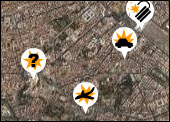
Betting on Terror
"The best day to launch this project was undoubtedly September 11th. The fake institutional tears flowed for the lukewarm memory commemorated a human disaster with a careful selection of morbid images, made to sow the same mediatic terror celebrated in the 'special sections' in the printed and tv media after the main terroristick attacks of the last years. A nodal point of this insane process is the prediction of the next attack, based on many rumours and experts' analisys.
The project Where-next is turning this mechanism over its advocates. It's a game born from the strategic partnership between the Guerrigliamarketing.it and Molleindustria groups. It consists of betting on the next attack, guessing time, place and typology, using the Google Maps API. The game combines two extreme aspects of the contemporary reality: the global legitimation of bets as a tecnique to guess and change our personal future, and the uncertainty caused by terrorist attacks, unbearably amplified by mass media). The authors have constructed this disturbing hybrid, ready to deceive the most incompetent journalists.
On the other side, the game will force everybody else to reflect on how a formalization of the massacre play, ruled by the media on every tragic occasion, trough an online game is triggering complex reactions on the users. In this way the official sources are delegitimized on telling us how the future reality will be made, and then we can repossess the reality imaginery thanks to a sarcastic and playful form. The end result is that the induced terror is played down to an exhilarating game, and the latent panic (as a western contemporary mandatory component) is definitively broken down in pieces." From neural.it.
Posted by jo at 11:22 AM | Comments (0)
September 12, 2005
Deconstructing Google Bombs:

A Breach of Symbolic Power or Just a Goofy Prank?
"ABSTRACT: In this study I compare two Google bombs using Melluci’s (1996) social movement framework. Viewing the Google bombing practice as a social movement provides an informative lens from which to analyze the nature and goals as well as the results of this form of online collective action. The empirical basis for this research relies on analysis of the content and context of Google bomb hyperlinking using an approach informed by Beaulieu’s (2005) notion of sociable hyperlinks. From this study I conclude that the Google bombing practice is an online protest technique not unlike the "media mind bomb" developed by the late Bob Hunter of Greenpeace (2004) fame. In the case of Hunter’s mind bombs, sounds and images were used to form alternate constructions of reality in the news media. Similarly, Google bombs are constructed by manipulating the relative ranking of an Internet search term and thereby creating alternate constructions of reality through collective action online." From Deconstructing Google Bombs: A Breach of Symbolic Power or Just a Goofy Prank? by Clifford Tatum, First Monday, October 2005. [via]
Posted by jo at 04:48 PM | Comments (0)
September 06, 2005
Simbabwe

Political Games, Walking A Fine Line
At what point does satire become cynicism? The line between them can be extremely fine, one very dependent upon perspective. But it's an important distinction to make, because one point of satire is to reveal the deceptions at work in public performances (whether they be for entertainment or politics); done correctly, satire makes it much harder to accept these continued deceptions. The revelations of satire make us laugh and hurt at the same time. Cynicism, conversely, often takes the deceptions as a given, and admits their existence while denying that we have any choice in the matter. The revelations of cynicism at best make us seek to escape, at worst make us look for ways to get into the game.
Simbabwe, a computer game put together by The Daily Grind (MacOS X only), walks that fine line between grim satire and cynicism; those of you who get a chance to play it can tell us in the comments on which side you feel it falls. After running through a full game, I'm tending towards grim satire, but am willing to entertain counter-arguments.
Simbabwe is, on the surface, a Monopoly-style game of parcel acquisition, chance events and player backstabbing. Players take on the label of one of the various historical strongmen and dictators that have ruled Zimbabwe (formerly Rhodesia), moving around the board seizing and plundering resource industries, major cities, media outlets, and so forth. Random events range from being put on a human rights watch list, rigging elections, sending opponents to jail, and the like, each combining all-too-familiar events with game effects. Each player seeks to increase both political capital and the destruction of assets, while keeping cronies happy through occasional payoffs.
# Features: Challenging AI
# Sophisticated inflation model: watch prices go up and savings erode every time you print money.
# International reputation model: your actions determine whether you get aid, a travel ban or a slam dunk in the slammer on setting foot outside Zimbabwe.
# Splenetic graphics
# Vibrant sound effects
# Over 60 dynamically triggered events, including adopting Marxism in 1988, the Land Reallocation Act 1992 and Operation Drive Out Rubbish
# Detailed in-game help
# Plumes of smoke
ot actually appear in the game.)
Given that brief description, it would be easy to declare that this game is little more than cynicism with colorful graphics. After all, there are no lessons here, no embedded links to real human rights groups. It's a reasonable argument, but I do see some value in this kind of approach. There's the "history comes alive (in a perverse way)" aspect: a reasonably aware individual playing this game can't help but wonder how much of it is based on real events. There's also the "okay, enough" aspect: seeing that the game elements have a twisted basis in reality can sensitize a player, making him or her more likely to recognize similar events in reality and (ultimately) more likely to support efforts to stop them.
There's also an inspirational aspect here, too. After playing Simbabwe, it's easy to see how a similar game model could be applied to other political figures around the world. In places with reasonable protections of free speech, creating and playing a similar game could easily become a way of undercutting the perceived legitimacy of powerful figures. In a way, it could even turn the cynicism argument on its head: these politicians (or business leaders, for that matter) may think they're accumulating power, but we can see that it's just a child's game of bullying and rivalry.
Imagine, for example, a version of this game where the players are various fossil fuel and energy industry figures -- a mix of ExxonMobil, Enron, Unocal, and the like, trying to acquire properties such as politicians (with The White House taking the Boardwalk slot), media outlets, public utilities, mining/drilling rights, and so forth. Chance events could include kickbacks in the new Energy Bill, having to fund a Greenswash Campaign, or "Breakthrough in Solar Power: Pay $20 Million to Buy It and Hide It," and with every turn around the board raising the cost of energy resources (or reducing the number of working oil fields). There's no Go To Jail, because they never do seem to get sent to jail, but there would be Called In Front Of Senate Hearings, which could serve the same purpose.
Cynical? Maybe. But it would likely do a far better job of delegitimizing those groups than a thousand protesters chanting "hey hey! ho ho!" [Posted by Jamais Cascio in WorldChanging Weekend]
Posted by jo at 01:01 PM | Comments (0)
Capturing the Moving Minds

The Connection Between the War Against Terrorism, Economics and Media-Art
Researchers, activists and media-artists meet on the Trans-Siberian train from Moscow to Beijing September 11th - 20th 2005. The conference Capturing the Moving Minds gathers a pack of people--artists, economists, researchers, philosophers, activists--who are interested in the new logic of the economy, the new form of war against terrorism and in the new cooperative modes of creation and resistance, together in a space moving in time. Spatially moving bodies and bodies moving in time (through the different time zones) creates an event, a meeting that not really 'is' but 'is going on'.
Is this project about economics, is it political activity or a work of art? This "boundlessness" or "indeterminacy", which always characterizes the creation of new, is where the energy of the project is coming: The enterprise expresses and exposes itself the "knowledge economy" in which it exists. It is something the orthodox conceptions about work, action, economy and art are unable to grasp. In this organizational experiment everybody is "alone together" like a pack of wolves around a fire having neighbours to the left and to the right but nobody behind their backs exposed to the desert.
There are 50 participants on the train involving well known media-artists, frontline contemporary thinkers and political activists. The project has been invited to participate in the International ARS2006 biennial at Kiasma Museum of Contemporary Art in Helsinki and to arrange an exhibition at the Villa Croce Museo d"arte contemporanea di Genova during summer 2006.
Press Conference and Opening Seminar Wed 7.9., 15:00-19:00, Hemeentie 33 A, 2nd Floor, Helsinki
15:00-15:20 Intro to the project, its themes and methods (Tuula Karjalainen, Jussi Vhmki, KlausHarju)
15:20-15:40 Launching of the mobile documentation (Minna Tarkka, Adam Hyde et al.)
15:40-16:00 Trans-sib as a work of art (Akseli Virtanen, Anna Daneri, Genova)
16:00-17:00 Questions, interviews, refreshments
17:00-19:00 "Aesthetics of Resistance" seminar with Bracha L. Ettinger (Tel Aviv), Pierre Guillet de Monthoux (Stockholm), Jordan Crandall (Los Angeles), Steffen Boehm (London).
Mobicasting brings the event directly for all: The Trans-siberian conference is documented and broadcasted through an audiovisual mobicasting platform to the internet. The documentarists, photographers, artists and researchers produce discussions, ideas, interviews, texts and films along the route. The documentation will be projected in Kiasma during the journey and it will also be available on several international www-channels. The webpages http://www.kiasma.fi/transsiberia will be opened on September 7th. See also http://trans-siberianradio.org
Further info on the conference and the participants: http://www.ephemeraweb.org/conference
Further info on the mobicasting platform: m-cult, Netta Norro +358 40-561-8004
Further info on the opening seminar: Akseli Virtanen +358 400-302010 akseli.virtanen[at]hkkk.fi
The event is organised by Ephemera, Tutkijaliitto, Kiasma, Frame, m-cult, Helsinki School of Economics and the Chydenius Institute.
Posted by jo at 12:06 PM | Comments (0)
September 02, 2005
FALLING LIFE
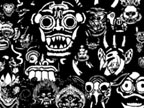
Crashing Ars
Falling Life is an ongoing project that was introduced for the first time in Berlin in August 2005. This urban screening project doesn’t need a curator or a gallery; it doesn’t need a fixed place or access to electric power. The artists are equipped with a car, a laptop, a compact light powerful projector and a small power generator. With this very mobile equipment the artists are able to have an instant presence in the urban landscape. They use facades of buildings that can be immediately changed into a projection screens. What makes the project exciting is the variety of possible buildings as a projection surface: the more uneven and in relief they are the more magic they look. Without any preparation and without any permits the artists are operating in a kind of projection guerrilla style.
Michael Bielicky and Kamila B. Richter are using a minimalist language of white constantly appearing and disappearing pictograms. The moving icons represent the collective reality of our interconnected globalized world. With the help of an algorithm the combination, amount, size and speed of the objects is permanently changing and so the image is never the same. The artists don’t reduce only the form of the displayed objects but also the color absence results in a pure white light. It is fascinating that the whole movie with a 25 different sequences can have a size of 250KB!!!
The next public appearance of Michael Bielicky’s and Kamila B. Richter’s light projections will be in September at the Ars Electronica festival in Linz. The (not invited) artists will apply the theme of this year festival - “Hybrid – living in paradox” on the Ars Electronica itself: Ars Electronica is living in paradox. The artists use the same hybrid strategies Ars Electronica aims to discuss as they create their own hybrid Ars Electronica layout by copying and recombining some of the language and pictorial units used for this year Ars Electronica’s promotion material. Michael Bielicky and Kamila B.Richter: x[at]avu.cz. Also see Locomotion.
Posted by jo at 10:52 AM | Comments (0)
August 31, 2005
American Scientists + Godcasting
[via Eyeteeth] + Godcasting.
Posted by jo at 11:06 AM | Comments (0)
Pink Noise
Urban Noise Pollution Displayed on Street Advertising Boards
Pink Noise by arts collective HeHe.org will be installed in Witte de Withstraat, Rotterdam on Sept. 10th, during the live event Hands On Hands Off organised by V2. Bruit rose (Pink noise in English): The interaction of this work is based on visualising the ambient sounds in the environment aswel as the passerby. The light emmitting panels, usually used to divulge numerically formatted information, are instead détourné from this didatic function and serve as an animated visual, disengaged from all the gloss that usually occupies this urban advertising space. [via URBAN SCREENS 05]
Posted by jo at 10:47 AM | Comments (0)
Readers for "Mobtagging DisCourse" and "Triggered by RFID" at Mediamatic
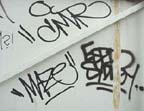
Theory, Projects, Criticism, Resources
Reader for Mobtagging DisCourse: Mobtagging is the practice of a large group of users who freely apply and exchange tags (metadata) to a set of unstructured online information. The aim is to describe content more adequately, personally or pinpoint interesting information faster than a search engine or online directories. Mob – or Social tagging can provide more precise search results for specialized interests and as such is a form of Commons Based Peer Production (CBPP).

Reader for Triggered by RFID: Radio frequency identification is a technology that is now situated in the elevator of technical development. A growing number of logistical companies see the advantages and possibilities of RFID for managing large bodies of objects. But what uses can this technology be applied to that are not in the logistical realm? How can it serve and/or change society and human interaction? How does it change the concept of information and information networks as we know them today? This reader compiles a number of resources on the technical and philosophical aspects of RFID.
Posted by jo at 07:17 AM | Comments (0)
August 23, 2005
Trans Siberian Radio

Mobile Lab for On-Air Experimentation
Trans-Siberian Radio is a low-power FM station that will operate on the train from Moscow to Beijing via Novosibirsk, during the conference Capturing the Moving Mind: Management and Movement in the Age of Temporary War, September 11–20.
The station will be a mobile lab for on-air experimentation, featuring music and ideas created collaboratively by passengers on the train and accessible to everyone along the Trans-Siberian route. As curator Natilee Harren writes, the ever-moving symbol of the train fits the conference's theme: "The spirit of the conference is to cross fixed boundaries and to create an environment that is open to the 'contaminating influences' of the communities through which the train will pass. In fact, the point of having the conference on a train is to escape any restrictions relating to a particular time or place." Visit the project's site when the train is rolling to contribute with audio works or hear—and manipulate—audio clips from the ride. [blogged by Regine on we-make-money-not]
Related: "Last year, artists Jennifer Allora and Guillermo Calzadilla used micro-radio transmitters to create a re-volt. That is, by helping community members build nearly 500 micro-radio transmitters, they initiated a process by which power was redirected from the corporations who most profit from the publicly owned airwaves to individuals who can express a diversity of commercial-free viewpoints. Their project Radio Re-volt , created during a residency at the Walker Art Center, culminated in October with a narrowcast the length of University Avenue in Minneapolis. More than 50 micro-radio stations aired from homes and businesses along the route for the benefit of their neighbors or anyone driving the avenue with their radio on." ...More on Radio Re-volt at WiredNews. Click here to read an interview I did with Allora and Calzadilla last spring. [posted by Paul Schmelzer on Eyeteeth: A journal of incisive ideas]
Posted by jo at 10:35 AM | Comments (0)
August 21, 2005
The Ministry of Reshelving
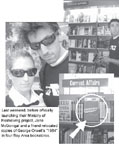
Secretly Reshelving 1,984 Copies of 1984
Last week, Danah Boyd blogged about the Reshelving Project. In today's Boston Globe, the project was reviewed in The Ministry of Reshelving by Joshua Glenn.
"EARLIER THIS SUMMER, Jane McGonigal and three dinner companions were chatting about doublespeak, censorship, and surveillance when someone idly commented that George Orwell's dystopian novel ''1984" should be reclassified as Non-Fiction, or even filed under Current Events. ''Five seconds later, I said, 'Wait--we could actually do that,"' recounts McGonigal. So last Monday she took the lead in launching the Ministry of Reshelving project, an ambitious, opt-in performance piece whose goal it is to secretly reshelve 1,984 copies of Orwell's book in bookstores in all 50 states.
Though such an undertaking sounds daunting, it's child's play for McGonigal, a doctoral candidate in performance studies at UC-Berkeley who earns a living working as a designer and ''puppetmaster" for 42 Entertainment, an Emeryville, Calif.-based outfit that creates elaborate ''alternate reality games"--played by thousands via chatroom, cell phone, e-mail, even billboards and want ads--in order to drum up excitement for various new products.
But McGonigal's true passion, she said via e-mail from San Francisco, is ''making games that give people a platform for changing social norms and public policy." As of this writing, she reports, some 55 ''ministers"--from California, New York, Idaho, Kentucky, Wisconsin, North Carolina, and a half dozen other states--have relocated over 100 copies of ''1984." Evidence of these hijinks is being posted around the clock to the photo-sharing website Flickr (flickr.com/groups/reshelving).
Is Boston behind the curve? By no means! On Thursday morning, McGonigal said, a Bostonian ''minister" informed her that a copy of ''1984" had just been moved from the Fiction section of the Borders in Downtown Crossing to the Political Science section, where it was reshelved next to a book titled ''Inside the Mind of Bush."
How to Serve the Ministry of Reshelving
1. Select a local bookstore to carry out your reshelving activities.
2. Download and print "This book has been relocated by the Ministry of Reshelving" bookmarks and "All copies of 1984 have been relocated" notecards to take with you to the bookstore. Or make your own. We recommend bringing a notecard and 5-10 bookmarks to each store.
3. Go to the bookstore and locate its copies of George Orwell's 1984. Unless the Ministry of Reshelving has already visited this bookstore, it is probably currently incorrectly classified as "Fiction" or "Literature."
4. Discreetly move all copies of 1984 to a more suitable section, such as "Current Events", "Politics", "History", "True Crime", or "New Non-Fiction."
5. Insert a Ministry of Reshelving bookmark into each copy of any book you have moved. Leave a notecard in the empty space the books once occupied.
6. If you spot other incorrectly classified books, feel free to relocate them.
7. Please report all reshelving efforts to the Ministry. Email your store name, location, # of 1984 copies reshelved, and any other reshelving activities conducted, to reshelving @ avantgame.com. Photos of your mission can be uploaded to Flickr, tagged as "reshelving", and submitted to the Ministry of Reshelving group.
Posted by jo at 12:09 PM | Comments (0)
August 18, 2005
Center for Tactical Magic:
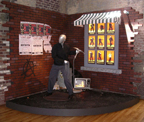
Tactical Ice Cream Unit
Grand Arts is pleased to present the latest project from the Bay Area-based Center for Tactical Magic, the Tactical Ice Cream Unit. Combining a number of successful activist strategies (Food-Not-Bombs, Copwatch, Indymedia, infoshops, etc.) into one mega-mobile, the TICU is the Voltron-like alter ego of the cops’ mobile command center. Incorporating an alternative strategy of utopian potlatch, the Tactical Ice Cream Unit is envisioned primarily as a mobile distribution center for free ice cream and information produced by local community groups.
Although the TICU appears to be a mild-mannered vending vehicle, it harbors a host of high-tech surveillance devices, including a 12-camera video surveillance system, GPS with satellite internet, and a media center capable of disseminating live audio/video. More than creating an undercover Mission: Impossible aesthetic, the TICU’s full surveillance suite provides grassroots access to mobile communications technologies. Whether used to produce independent community news or to monitor corporate dumping or police activity, the TICU will investigate the limits of “neutral technologies”.
At various times the TICU will invite visitors to explore the interior, view documentation of the street operations, or collaborate on “missions”. In addition to it’s regular cruising of local neighborhoods and streets, community groups may suggest uses for the Tactical Ice Cream Unit such as beach clean-up, block parties or supporting a strike. The Unit is prepared to augment any event and should the TICU wander into the vicinity of a rally, protest or civil uprising, the Unit is equipped to serve as a mobile oasis, where the activists can quench their thirst, reload their cameras, document unfolding events, and protect themselves from various airborne dispersants.
In short, the TICU seeks to protect, provide, energize, invigorate and educate its audience. Whether lurking in a corporate park or chillin’ in a neighborhood park, the Tactical Ice Cream Unit promises to attract people from all walks of life, thus serving as a mobile nexus for community activities while providing frosty treats and food-for-thought.
The Center for Tactical Magic is an organization dedicated to the extensive research, development, and deployment of the pragmatic system known as Tactical Magic. A fusion force summoned from the ways of the artist, the magician, the ninja, and the private investigator, Tactical Magic is an amalgam of disparate arts invoked for the purpose of actively addressing Power on individual, communal, and transnational fronts.
The Tactical Ice Cream Unit would like to extend an invitation to you to join an elite corps of embedded journalists during our ground operations in Kansas City. A few, select journalists will be permitted to ride along with the TICU crew as we begin our civic tour of duty. Participating members of the TICU Embedded Journalist Corps (EJC) will gain a behind-the-scenes and in-the-streets look at the Tactical Ice Cream Unit. This revolutionary, new project designed by the Center for Tactical Magic is preparing to take to the streets by August 20. Contact us if you feel you are up to the challenge!
For further information, contact:
April Calahan-McDonald
Grand Arts Assistant Director
(816) 421-6887
gallery@grandarts.com
Posted by jo at 06:03 PM | Comments (0)
August 13, 2005
KISSS
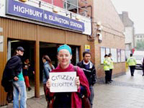
The Kinship International Strategy on Surveillance and Suppression
Are you seeing what we're thinking? The Kinship International Strategy on Surveillance and Suppression | KISSS is a series of performance events and interventions addressing surveillance and suppression.
KISSS is happening at an important moment. In the current political and social climate, surveillance has become an accepted and unquestionable part of everyday public life. Suppression of behaviour, information and desire occurs both privately and publicly. What is the relationship between surveillance and suppression? Consequence or reason for? How do issues of surveillance and suppression affect the work we make as artists and the way in which we work? How can we as artists, living in different countries, engaging in multi-platform possibilities and utlising varied perspectives, respond to these issues in a cohesive and powerful way?
A KISSS Policy Briefing will be held on August 19, 2005 at Elastic residence from 1500 to 1800.
This is an opportunity to meet the team, see work in progress and find out more about KISSS and how you can contribute and be involved. If you are interested in proposing a performance or contributing work, please come prepared to discuss it with a member of the team.
For further information on some of the strategies identified for KISSS visit:
http://www.elastic.org.uk/KISSS/strategies
KISSS Policy Briefing will take place at: Elastic residence, 22 Parfett St, Whitechapel / Aldgate East t: 0207 247 1375 e: kisss[at]elastic.org.uk
KISSS is supported by the University of Wales, Resonance 104.4FM and Concial Gallery, Australia.
Posted by jo at 10:15 AM | Comments (0)
August 09, 2005
In Memory of Franz Feigl
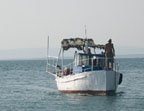
The Myth of Bolshevik
Network activists and friends of the medien.KUNSTLABOR want to travel by boat from Amsterdam to the Black Sea. Final destination of the journey is the island St. Anastasia, formerly known as Bolshevik (1945 - 1990). The boat is named after Franz Feigl, an Austrian artist and network activist who lived in Amsterdam and died in 2001 at a young age.
The boat will record on its journey all open wireless lan access points. This activity, if conducted by car, is called war-driving. The peaceful goals of the Motorship Franz Feigl aim at highlighting the possibility of opening up networks and creating a free infrastructure (see Funkfeuer, Freifunk,
Consume).
The boat will also communicate via packet radio and pictures will regularly be sent by GPRS to http://stroem.ung.at. MS Franz Feigl has already travelled from Amsterdam via Linz to Vienna. In Linz at the wharf of the Times Up collective repair work on the boat was done. It has travelled safely from Linz to Vienna under captainship of Franz Xaver.
Tomorrow, Wednesday August 9, the MS Franz Feigl is due to leave for Bratislava, where it will arrive om Thursday or Friday. On Monday, August 15, it will arrive in Budapest.
The project is carried out in collaboration with 05-trov and mobil.KUNSTLABOR.at
SMS Kontakt: 00436764902223
Chat: irc.kunstlabor.at#kunstlabor
E-mail:boot[at]kunstlabor.at
[via netbehaviour]
Posted by jo at 12:35 PM | Comments (0)
August 03, 2005
Hitching Stealth with Trevor Paglen
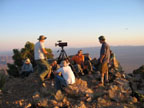
Experimental Geographer
"...Experimental lecturer and all around academic outlaw Trevor Paglen is a new breed of researcher for the University of California at Berkeley. He has been more aptly called by his peers an underground geographer, armed with a telescope, a GPS device, some light field military listening equipment, a car trunk full of cameras and maps, and one hideously nondescript corporate infiltration suit. Swapping between his other outfits as an intervention artist, and investigative journalist, a prison-abolition activist, punkrocker and total sound head, not to mention a third degree master in the art of panoptic trespass, he takes a wildly experimental approach to studying the strategic and practical boundaries of contested public/private space.
Altogether, he's concocted his own strain of what he prefers to call 'experimental geography' that he uses to trace the immense networks of undisclosed borders, shadow lairs and underground finanscapes edified by corporate, state and national defense collusion..." From Hitching Stealth with Trevor Paglen; Text by Bryan Finoki/Photos by Trevor Paglen, Bryan Finoki, & Bill Luoma, Archinect. (2005) [via]
Posted by jo at 10:12 AM | Comments (0)
July 25, 2005
SMS Satyagraha
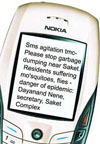
Systematic Non-Violent Resistance
For the uninitiated - Satyagraha is a philosophy of non-violent resistance against injustice, popularized by Mahatma Gandhi. The recently launched Mumbai Mirror tells a tale of how the Thane Municipal Corporation is being bombarded by text messages from 627 families of Saket Complex, a society of buildings, complaining and urging action against the stench created by open garbage. So much so, that the Municipal Corporation has had to change some of their officials' cell phone numbers! (read on for more details SMS Satyagraha!)
So intense was the onslaught that began on the morning of July 19 that the TMC changed some of its officials' cell numbers.Not to be outdone, the protestors took just two days to get hold of the new numbers and unleashed a fresh flurry of messages. While Day 1 saw over 300 SMSes beeping on hapless TMC officials' mobile phones, they are still receiving a 100 odd messages every day.
A brainwave of event manager and Saket Complex resident, Dayanand Nene, the protest is gradually showing results with TMC health department covering the garbage with sand to beat the stench. The residents, clearly unimpressed, say the SMS assault will continue. "In my profession, SMS is the ultimate way to reach out to the people. I realised that if we send SMSes to civic officials, they would have no option but to look into our problem," Nene said. Before they turned their cell phones into weapons, the residents of Saket Complex had tried everything from petitioning TMC officials to dharnas to get rid of the garbage dump. "For the past 25 days the TMC has been dumping garbage here. [Posted by Dina Mehta on worldchanging)
Posted by jo at 09:27 AM | Comments (0)
July 18, 2005
AUD-802

Mode of Movement or Moved Object?
AUD-802 project is drawn around the issue of mobility, mainly materialized today by the automobile. It is built in the form of a series of stops. At each of these stops we question the city, its background and landscape.
AUD-802 is composed of three parts: AUD-802 [étape Anvers], an inflatable structure (representing at scale 1/1 a car, the license plate of which has become the project title); AUD-802 [étape Bruxelles], installations realised for each stop; and AUD-802 [déviation Blois], a website that is also the fixing point of this touring project.
"The exhibition proposed at la Maison de la Villette is presented as being the Launch of the Project AUD-802. It initiates the beginning of a route, starting in the green of the Parc de la Villette, which will be constituted by stages during which the overview of the car object (realized by an inflatable structure) will permit the constitution of a memory stored on the web site.
This exhibition consists of the Web site, which moreover allows the guests to adjust the sound atmosphere of the place, of the car object suspended in space and of video images where it becomes alternately toy, bait, monument or landscape. It also appears as a skin which is inflated, deflated, stored and put away. Contrary to the reality to which this object sends us back, it is no longer the mode of movement but the moved object." Joël Audebert and Nathalie Brevet_Hughes Rochette.
Posted by jo at 08:42 AM | Comments (0)
July 11, 2005
Transparency to Exodus:
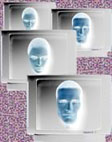
On Political Process in the Mediated Democracies
"...The most obvious contribution of the visual arts to the anticapitalist movements is the merger of community-oriented video with the distribution system offered by Internet, giving rise to innumerable non-normalized media projects that combine documentary information and expressive politics, in the lineage of Tucuman Arde. These projects carry out a specular combat with broadcast TV – that is, with the spectacle society – and in that way, they at least partially fulfill the political aspirations of the early videomakers. Another, more subtle thread is the proliferation of mail art, first through ‘zine culture and desktop publishing, then through the net, culminating in the mid-nineties in the widespread circulation of subversive texts and media pranks under multiple names like Monty Cantsin or Luther Blissett. Multiple names bring the refusal of copyright and intellectual property to the very center of ego-dominated subjectivity, in an attempt to dissolve the proprietary function of the signature which has always served as the barrier between contemplative, individualistic art and collective, interactive forms of expression. Yet another artistic contribution to the movements is performance culture, with its emphasis on the embodiment of the political, played out in its inseparability from the sexual, ritual, generational, ethnic, and psychodramatic dimensions of human experience...." From Transparency to Exodus: On Political Process in the Mediated Democracies by Brian Holmes, NOEMA.
Posted by jo at 10:08 AM | Comments (0)
June 27, 2005
The Fantasy Life of Boys:

A Magical Tactical Practical
The Center for Tactical Magic is a San Francisco-based collective operating in the realm of performance (art) and action. Highly trained in the principles of magic, ninja-ism, art, investigation, and critical theory, the Center's actions represent a novel combination of serious political thought and social gathering. Presenting a model of art-making as collaborative, relational, and political, CTM has pseudo-military cousins in groups like Basekamp (Philadelphia) and Atelier van Lieshout (Rotterdam, The Netherlands).
MAGIC: Like artists, magicians and ninjas synthesize technical ability with tricky showmanship, competition, and illusion. The artist-as-magician illuminates the aspect of art presentation that works on the tiered levels of the public, the curator, and the fellow practitioner. CTM is able to entertain local children while foregrounding political statements and acts, rather than merely clowning. This works on the level of the public- and the artist-viewer, while entertaining and educating both.
BOYS: CTM encompasses a levity of approach which reflects its roots in fantasy careers like magician, ninja, private investigator, and philosopher. Many artists have taken on professional personae in order to document subcultures and social truths. The hybrid practice of CTM uses a schoolboy's list of professions as a tactical launching pad to pursue meaningful interaction and effective action.
NO MORE PRISONS: In the case of CTM, the various training in the ways of stealth reconnaissance, mind-and-body bending, and customer service, has yielded a powers-for-good scenario. The commitment to models of political action and literacy set this group apart from your average roving gang of fighter- trickster-private dicks. The CTM continues to take its message and methods to the streets, and to regional art centers and universities around the US.
Always up to something, I asked The Center to take a moment to offer a list of recommended readings to Rhizome Digest readers in lieu of a formal interview, and they provided the following five readings and five real-world exercises in their brand of Tactical Magic.
-Sara Greenberger
*************************************************************
READ-BETWEEN-THE-LINES READINGS: (in no particular order of preference)
1) Magick in Theory and Practice - Aleister Crowley (especially Crowley's preface/intro) and/or Magick Without Tears
2) Essence of Ninjutsu - Dr. Masaaki Hatsumi
3) Magic & Showmanship - Henning Nelms
4) Guerrilla Warfare & Special Forces Operations (FM 31-21) - Dept. of the
Army
5) The Temporary Autonomous Zone, Ontological Anarchy, Poetic Terrorism -
Hakim Bey
EXERCISES IN MAGICAL THINKING, ANALYZING POWER, AND ACTIVATING HIDDEN FORCES:
1) Plant three seeds of a vegetable plant of your choosing. Label each container respectively: positive, negative & control. Provide each plant with equal amounts of water, soil, and sun. Dedicate at least 6 minutes of each day (3 minutes per plant - positive & negative only) to focused positive & negative thoughts. Record your results and enjoy the fruits (vegetables) of your labor.
*This is an exercise in developing your telepathic abilities, exploring modes of unregulated communication, collaborating with non-humans, and bringing your thoughts and desires to fruition.
2) Write your own survey to elicit responses from other members of the general public. You may decide to pose questions, ask opinions, or provoke thought. Then, conduct the survey for at least 3 hours in a public space of your choosing, or until the "authorities" inform you that you are trespassing on public property.
*This is an exercise in activating public space, determining the limits of public space, and generating a non-commercial exchange of ideas among strangers. Most people are happy to express their opinions when asked, especially when they are informed that there participation does not involve a sales pitch, future mailings, religious conversion, or product development.
3) Get a rope (at least 30ft) and a friend (or a friendly stranger). Take turns tying each other up and escaping.
*This is an exercise that explores restriction, control, and self-liberation. You'll be amazed to find how easily one can liberate oneself!
4) Get a group of friends together at night and find a public space to beautify as you see fit. Consider your site beforehand and plan your action thoroughly (but don't bring along any evidence of your conspiring). Your materials should not be cumbersome, or they should be well-disguised. While some friends are in the act of beautifying, others should be posted on the lookout for "authorities" since they might not have the same sense of aesthetic appreciation as you and your friends. (Hey! If they don't like it, they can make their own art!) If you decide to document your actions, it's best to do it at a later time, and be sure that none of your friends faces are visible.
*This is an exercise in collaborative acts of meditation, willful engagement, and material transformation. You can do this in the daytime too, but nocturnal operations tend to be more mirthful and help induce perceptual shifts (both spatially and experientially).
5) Create a disguise for yourself that allows you to navigate everyday life without drawing much attention. This should be different from your normal attire. Spend the day in disguise performing leisurely or mildly adventuresome activities. Possibilities include:
a) Choose someone at random and follow them from a distance for at least fifteen minutes. Then follow someone else. When you grow tired of following people, find someone who looks lost and try leading them to their destination.
b) Visit a factory or place of industry and ask for a tour. Ask lots of provocative questions, then ask for a job. Tell them you can't do much, but you're interested in something at the executive level.
c) Go to at least three different places of worship. Check out the interior design. Explore a little. If someone is in attendance, strike up a conversation about the "afterlife" or "special religious foods."
d) Go to a bank with your video camera and ask the security guard or branch manager if you can record there. When s/he says "no" then ask how many security cameras they have installed. If they ask "why?" tell them you're "just doing research" or "conducting a survey of banks" or "interested in security."
*This is an exercise in shape shifting, personal transformation, and casting illusions as well as observing how "authorities" respond to subtle challenges beyond the status quo. The disguise will help empower you to act "out of character;" besides, if you can't change yourself how do you expect to change the reality around you?
-Center for Tactical Magic [via Rhizome]
Posted by jo at 04:12 AM | Comments (0)
June 22, 2005
Adopt A Chinese Blog

Cooperation, Politics and Activism
This idea is so brilliant it gives me chills.
Blogging is popular in China, enough so that the government is paying more attention now to what people say on them. Numerous blogs have been shut down, either from government pressure or just by Chinese host providers fearful of its users possibly breaking the law. In addition, an April 2005 law mandates that all non-profit website owners must register their sites with their real personal information. The recent revelation that Microsoft was censoring various terms in the blogging service they offer in China only added to the fear that free speech on the Chinese web would be harder and harder to find. Some Chinese bloggers managed to put their websites on offshore servers, but the language and cost issues are prohibitive for many.
Adopt A Chinese Blog is an end-run around official censorship. How? By making the hosting of Chinese blogs a distributed, collaborative process:
This is how it works. A blog (or any website, really) using an independent hosting service hosts a blocked blog. (This simply means creating a subdirectory where the adopted blog can be published and store its files.) The host blog should not have a significant readership in the country where the adopted blog is blocked, because the host blog is running a (small) risk of being blocked in that country. [...]
By distributing the blocked blogs across a variety of hosts, the task of blocking a large number of blogs becomes increasingly difficult. If any adopted blog is blocked, it can say its thank yous and farewells to its host and then move onto a new host.
If the multitude of Chinese blogs facing official censorship instead became hosted on a multitude of independent servers around the world, the Chinese government would end up having to block a significant portion of the net to shut them out -- and that portion would grow and grow as the blogs found new adoptive hosts. The traffic and maintenance demands on the adoptive site would likely be minimal, and the adoptee gets a host server free from government censorship.
I'd like to see an equivalent program for Iranian bloggers, or for bloggers/writers in any other country facing official restrictions on what they can say online.
People wishing to talk about this project in more detail can visit the Adopt Chinese Blog Forum. [blogged by Jamais Cascio on worldchanging]
Posted by jo at 12:11 PM | Comments (0)
June 21, 2005
Rixome
![madrix_final_b[1].jpg](http://www.turbulence.org/blog/images/madrix_final_b[1].jpg)
Become a Walker
rixome is a network and a tool that turns mobile screens into windows that show the virtual and public dimensions of our point of view. A walker (a rixome user) can see on his/her mobile phone/PDA/laptop screen the virtual interventions that have been added to the location where s/he now stands. For example, a spoken message can be left on a given location for other "walkers" to hear through headphones whenever they pass by. The message can also be written, or it can be a 3D animation or image, a photography, a drawing, a video.
Remote rixome users can also check vía Internet the traces left by others but s/he won't be able to add an intervention similar to those published in situ. Developed by gelo for his at Master of Art and New Technologlies at the Universidad Europea de Madrid. [blogge by Regine on near near future]
Posted by jo at 08:54 AM | Comments (0)
June 08, 2005
At a Distance:
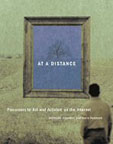
Precursors to Art and Activism on the Internet, 2005
At a Distance: Precursors to Art and Activism on the Internet, 2005 — Edited by Annmarie Chandler and Norie Neumark.—Cambridge: MIT Press, 2005.—486 p.—Includes an index.—Include a chronology of network art.—ISBN 0262033283. Reviewed by V.B. for The Daniel Langlois Foundation.
In their anthology, Annmarie Chandler and Norie Neumark assemble essays by authors who examine the networked collaborations of the 1960s and 1970s (Fluxus, mail art, cable video) as well as those of the 1980s (telematic art). Chandler and Neumark classify these practices under the heading of "distance art" to underscore the fact that they were not dependent on technological communication modes. They did, however, share a vision to utilize the space (physical, geographic, cultural, etc.) between the information transmitter and receiver in a performative fashion. And with an emphasis on programs rather than form, they introduced network art, experiments in augmented space, and the net.art of the decades that followed.
Norie Neumark's essay — which also serves as introduction — presents an overall view of the appropriation of communication tools by artists during the 20th century. The author goes on to suggest that the notion of distance could signify any combination of physical discrepancy, the time span between two events, and the division of object and subject in scientific observation. Neumark pursues her commentary by citing that the postal system was the first communication mode to close geographic distances. Broadly speaking, this system survives today, says the author, through the more sophisticated modes of technological exchange that have since emerged (telematics, Internet).
The book's first section, "Critical Perspectives on Distance Art/Activist Practices," is a collection of contributions that seek to trace the theoretic premises of these practices as they developed concurrent to the global implementation of communication modes from the 1960s onwards. The contributors assess, among other aspects, how these practices have historically been categorized according to technological progress, while the cultural contexts of their emergence and the way that participants and spectators identify with them have been largely neglected. To this end, in "Interactive, Algorithmic, Networked: Aesthetics of New Media," Johanna Drucker states that the precursors of network art reflected the technical aspects of their projects within a mainly conceptual and metaphorical perspective. By placing the accent on process rather than material repercussions or technological advances, these experimental practices allowed many artists to shed the formalist yoke of the previous decade. In "Immaterial Material: Physicality, Corporality, and Dematerialization in Telecommunication Artworks," Tilman Baumgärtel discusses the impact of exhibitions such as "Les Immatériaux," which was presented at the Centre George Pompidou (Paris, France) in 1985. According to Baumgärtel, through this multidimensional event that united theorists and artists, curator Jean-François Lyotard succeeded in defining the paradigm of an open and performative artwork. In his essay, Baumgärtel also highlights the innovative practices of the 1960s, such as the N.E. Thing Company, an entity both real and fictional created by Canadian artists Ian and Ingrid Baxter. The author states that this collective reflected the artist's public identity by parodying the protocols surrounding the exchange of economic information between a company and the outside world.
Like Baumgärtel, Reinard Braun in "From Representation to Networks: Interplays of Visualities, Apparatuses, Discourses, Territories and Bodies" reiterates the notion of dematerialization used to qualify conceptual art practices. He adds, however, that the telematic art projects of the 1970s went beyond this concept by taking into account the impact that locations transmitting and receiving information had on the significance of artistic proposals. With "The Mail Art Exhibition: Personal Worlds to Cultural Strategies," John Held Jr. addresses the problem of exhibiting mail art works. A number of representatives of the movement (including Ray Johnson) felt that these works should not become mere relics displayed in a gallery or museum. The author nevertheless makes an attempt to assemble a chronology of such exhibitions by describing the strategies used by the curators to present the works outside the network as still lively traces. In "Fluxus Praxis: An Exploration of Connections, Creativity and Connectivity," Owen F. Smith describes the sites of communication created by the Fluxus events, where communicational transparency took a back seat to humour, parody and play.
The second section presents case studies of important "distance" art projects. The studies are written either by the artists themselves or by participants who were witness to these practices. Annmarie Chandler interviews Kit Galloway and Sherrie Rabinowitz, artists who experimented with videoconferencing and satellites as early as 1970. They discuss the genesis of projects such as Satellite Art (1977), Hole in Space (1980) and Electronic Café (1984), ambitious planetary telecommunication undertakings presented to an audience that reached far beyond the perimeters of the art world. In "An Unsuspected Future in Broadcasting: Negativland," Don Joyce discusses the importance of the Negativland audio art collective of the 1980s, whose primary creative medium was the radio. One of the features of their radio show saw Negativland members inviting the public to call in and even join the broadcast (radio jamming). In "Mini FM: Performing Microscopic Distance," Annmarie Chandler and Norie Neumark interview Tetsuo Kogawa, a precursor of radio art in Japan. Kogawa describes the emergence in the 1980s of a community of young Japanese artists who used mini FM radios to communicate among one another, despite broadcasting regulations that normally filtered out this type of transmission. In "From the Gulf War to the Battle of Seattle: Building an International Alternative Media Network," Jesse Dew reports on the "Gulf Crisis TV" project, produced by Deep Dish TV Network and Paper Tiger Television (New York, U.S.A.) between 1990 and 1991. A series of cable programs documenting protests by Americans opposed to the Gulf War, the project constitutes for the author a counter testimony to the images being broadcast at the time by the mass media.
With "The Form: 1970-1979 and Other Extemporaneous Anomalous Assemblings," Melody Summer Carnahan summarizes her mail art work that began at the end of the 1970s and was derived from an alternative use of administrative procedures.
In "Networked Psychoanalysis: A Dialogue with Anna Freud Banana," Craig Saper interviews the artist known as Anna Banana, whose work drew on the paradigm of network psychoanalysis (using mail art), where participants could alternately play the role of analyst and analyzed. In "From Mail Art to Telepresence: Communication at a Distance in the Works of Paulo Bruscky and Eduardo Kac," Simone Osthoff offers a detailed analysis of the work of these Brazilian artists in the 1980s, when they primarily exhibited in South America. Osthoff studies Bruscky's fax and network art experiments and the early holography and telematic performance efforts by Kac.
"Distance Makes the Art Grow Further: Distributed Authorship and Telematic Textuality in La Plissure du Texte" by Roy Ascott recounts the collective writing experiment of 1983, which used the ARTEXT electronic textual network to capture the imagination of participants in cities around the world. In "From BBS to Wireless: A Story of Art in Chips," Andrew Garton discusses his involvement in various network projects, interweaving an autobiographical account into a history of communication technologies that he would use successively throughout his career. With "REALTIME-Radio Art, Telematic Art, and Telerobotics: Two Examples," Heidi Grundmann comments on a series of radio programs that she has curated and produced for Kunstradio in Austria since the 1970s. She also discusses the origins of the CHIP-RADIO (1992) and REALTIME (1993) projects, telerobotic musical performances that saw musicians play using motion sensors to remotely activate their instruments.
The third section focuses on the impact of the network on the art in the decades examined earlier in the publication. Contributions to the section study the emergence of artistic communities created through communication technologies. In "Estri-Dentistas: Taking the Teeth Out of Futurism," Maria Fernandez applies the notion of network as defined by theorist Armand Mattelart to examine the literary projects of the Mexican group Estridentistas, who produced works in their own country between 1920 and 1930. Among the group's influences were the Italian futurists. The author explains that the technological tools of the era were not directly accessible to the members of Estridentistas. However, they experimented with writing techniques inspired by their observations of communication and transport modes (telegraph and railway), which at the time constituted networks that bridged the physical distance between two points.
With "Computer Network Music Band: A History of the League of Automatic Music Composers and The Hub," Chris Brown and John Bischoff write about their use of telematics in musical improvisation and composition. The "League of Automatic Composers," which they created at Mills College, Oakland (California, U.S.A.) in the 1970s, was a precursor to today's widespread networking of computers by musicians and composers. In "Assembling Magazines and Alternative Artists' Networks," Stephen Perkins analyzes the phenomenon of magazines created by artists in the U.S. and South America in the early 1970s. Perkins emphasizes that by availing themselves of underground distribution methods, the artists succeeded in circulating subversive content outside of the mainstream media and in doing so escaped the grip of the authorities (particularly in countries under the stranglehold of a dictatorial regime).
In "The Wealth and Poverty of Networks," Ken Friedman, following the example of John Held Jr.'s text, returns to Fluxus and its derivatives, this time to analyze the concept of intermedia described by Dick Higgins in the 1960s. The author adds that the creators of these networks focused on relational aspects at the expense of the networks' sustainability. As a result, very little is left today with which to chronicle their historical path.
"From Internationalism to Transnations: Networked Art and Activism," by Sean Cubitt, underscores the extent to which the highly diverse political and social contexts of the collaborative projects impact their significance. Within a broader perspective, Cubitt maintains that the globalization of capital has the paradoxical effect of producing marginal networks that reinforce cultural particularities (demonstrated, says the author, by the artistic practices emerging from these networks).
Finally, the anthology includes a conclusion by Annmarie Chandler and Norie Neumark as well as a chronology of the role played by the network in art between 1921 and 2001, which encompasses all of the projects studied by the book's contributing authors.
Posted by jo at 07:00 AM | Comments (0)
June 06, 2005
Trans:it. Moving Culture through Europe
NowHere Europe
NowHere Europe is the event for the final presentation of the project Trans:it. Moving Culture Through Europe: Opening: Friday June 10, 6 pm, Laboratorio Scientifico della Soprintendenza Speciale per il Polo, Museale Veneziano, Cannaregio 3553.
Curated by Bartolomeo Pietromarchi, NowHere Europe recognizes creative practices in arts, architecture and urban practices that are re-defining the concept of public space. Initiated from direct field study, the project has produced a publication entitled The (Un)Common Place. Art, Public Space and Urban Aesthetics in Europe--published by Actar-Barcellona in English and Italian--which documents more than fifty artistic and urban projects and interventions realized or in the\process of realization in Europe; a cycle of three documentary films Invisible Communities, Ruins for the Future, Fluid Cities realized along three itineraries in eleven European cities and including interviews with artists, curators, architects, critics and intellectuals, depicting the context in which the interventions were realized and offering an introductory panorama of the themes dealt with in the book; and an exhibition that gathered, in the form of an archive, materials documenting a selection of the artist's projects.
From Norway to Turkey, from Spain to Bulgaria, from Cyprus to Romania, a "common feeling" has emerged, along with a shared context where artists, institutions and civil societies try out new relationships within which to seek new forms of co-habitation, comprehension and vision of the urban space. A common feeling that underlines a European specificity which, to quote Etienne Balibar, "has the capacity to speak/listen, teach/learn, understand/make understood (in short, to translate), a capacity that can be extended from a strictly linguistic one to a broader cultural level."
The "European specificity" which emerges from the artists' projects seems to be articulated in themes that deal with the dichotomy between public and private space in geographically and culturally distant contexts where the boundaries between social, individual, intimate and shared tend to blur. Artistic practices arise that call into question the traditional institutions of the art system, oscillating between political activism, manifestoes of intentions and direct action in the territory. What emerges from this specificity of approach is a redefinition of the meaning of community through a rediscovery of the urban experience as a learning practice that produces new visions and representations and an exploration of the collective symbols and memories. In terms of both artistic practice and theoretical reflections, NowHere Europe focuses on a new definition of the European cultural identity characterised by openness and by the constant redefinition of the Self in the r elation with the Other.
For the occasion it has been produced the site specific project of Cesare Pietroiusti, 10,000 unique art works distributed for free that will be presented during the opening.
Curator: Bartolomeo Pietromarchi
Mario Airò; Can Altay; Patrick André; An Architektur; Atelier van Lieshout; Baktruppen; Shigeru Ban; Massimo Bartolini; Matei Bejenaru; Irina Botea; Luchezar Boyadjiev; Eva Brunner-Szabo; Campement Urbain; Mircea Cantor; Monserrat Cortadellas Bacaria; Matali Crasset; C?lin Dan; Esra Ersen; Gelatin; Ion Grigorescu; Gülsün Karamustafa; Kimsooja; Iosif Király; Athanasia Kyriakakos; A.P. Komen & Murphy; Aydan Murtezaoglu; Lucy Orta; Osservatorio Nomade; Maria Papadimitriou; Cesare Pietroiusti; Oda Projesi; Bülent Sangar; School of Missing Studies; Škart; Sean Snyder; Simon Starling; Socrates Stratis; Anne-Violaine Taconet; Krassimir Terziev; Barthélémy Toguo; Gert Tschögl; Urban Void; Jeanne van Heeswijk; Erik van Lieshout; Mona Vatamanu & Florin Tudor; Zafos Xagoraris; Edwin Zwakman
Trans:it. Moving Culture through Europe
a project by
Fondazione Adriano Olivetti - http://www.fondazioneadrianolivetti.it/
in collaboration with
European Cultural Foundation - http://www.eurocult.org/
Fondation de France - http://www.fdf.org/
Fondation Evens - http://www.evensfoundation.be/
The J.F. Costopoulos Foundation
and
Soprintendenza Speciale per il Polo Museale Veneziano
ALSO VISIT:
http://www.transiteurope.org
http://fondazioneadrianolivetti.it
RELATED LINKS:
http://www.labiennale.org
FOR FURTHER INFORMATION PLEASE CONTACT:
Francesca Limana
Press & Public Relations
Fondazione Adriano Olivetti
Via G.Zanardelli, 34
00186 Roma
tel. +39 06 6877054
tel. +39 06 6896193?
Posted by jo at 04:31 PM | Comments (0)
June 03, 2005
Technologies of Cooperation: A Map To a Toolkit
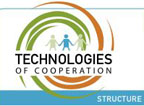
Tools to Alleviate Suffering...Liberate...Create
"What we are witnessing today is the acceleration of a trend that has been building for thousands of years. When technologies like alphabets and Internets amplify the right cognitive or social capabilities, old trends take new twists and people build things that never could be built before. Over time, the number of people engaged in producing new things has grown from an elite group to a significant portion of the population; at the same time, the tools available to these growing populations have grown more powerful.
Today's technologies of cooperation are practical tools for organizing people and solving problems that we face right now. But they are also harbingers of new forms of social and economic organization -- forms that may help resolve some of the complex social dilemmas that confront the world. So each example of a cooperative technology is also a model for thinking about future social forms as well as future tools; each example embodies principles that can help us think more strategically." From Technologies of Cooperation: A Map To a Toolkit by Howard Rheingold, theFeature, Jun 02, 2005.
Posted by jo at 01:50 PM | Comments (0)
May 31, 2005
One Free Minute

Anonymous Free Speech
You are invited to participate in the inaugural performance of One Free Minute, a mobile sculpture designed to allow for instances of anonymous free speech. Callers to One Free Minute's cell phone are connected to an amplifier and have their speech projected in public space for exactly one minute. One Free Minute also houses a digital archive of calls made to its answering machine, which are played back randomly between live calls.
There are two ways to participate in One Free Minute: (1) Call the archive number and leave a message for future performances: 614-441-9533. (2) Call live during the first performance Friday June 3rd, 5-7PM EST. Your calls during this time will be projected in the public green space of the Ohio State University Oval. 614-288-7248
The principal intent behind One Free Minute is to investigate how public discourse, and the human communication that makes it possible, has been changed by technology. Cellular phone technology has increasingly brought private space into the public realm, metering human interaction in billed-by-the-minute increments. One Free Minute inverts the private nature of cellular technology, using it to break the soundscape of public space with unpredictable acts of improvised, anonymous free speech.
A secondary intent of One Free Minute is to create a tool to facilitate anonymous free speech in public places. Governments everywhere are increasingly vigilant of who is saying what and where: One Free Minute puts a bit of a blur on the 'who' and 'where', meaning that participants can speak without fear of recrimination. For information on how to borrow One Free Minute (free) for demonstrations or similar events, please email info[at]onefreeminute.net
Posted by jo at 06:36 PM | Comments (0)
May 25, 2005
SWARM the Minutemen
![]()
Virtual Sit-In
"Electronic Disturbance Theater (EDT) in solidarity with Swarm The MinuteMen action will hold a 3 Day Virtual Sit-In on the MinuteMen Project from May 27th to May 29th (2005). We call on you to join us and let the MinuteMen Project know that hard borders are alien in an age of global interdependence and to the ideals of liberty as a “golden door” that is open to all. An ideal that so many have died trying to reach.
The MinuteMen are a non-governmental group of people vowing to patrol the US/Mexico border with guns in order to stop migrant people from crossing the border. They represent an intensification of the trend of violence towards migrant people and people of color that has increased since 9/11/2001. While they claim that they are not violent, their very use and display of deadly weapons is a violent act in itself.
Posted by jo at 11:12 AM | Comments (0)
May 13, 2005
The Future of the Reciprocal Readymade:
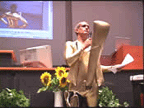
An Essay on Use-Value and Art-Related Practice
"The Future of the Reciprocal Readymade: An Essay on Use-Value and Art-Related Practice" by Stephen Wright [via 16 beaver group]
In a late text, Marcel Duchamp set out to distinguish several different types of readymades. Of particular interest here is the genre which he punningly described as "reciprocal readymades." Anxious, he claimed, "to emphasize the fundamental antinomy between art and the readymade," Duchamp defined this radically new, yet subsequently neglected genre through an example: "Use a Rembrandt as an ironing-board."(1) More than a mere quip to be taken at face value, or a facetious mockery of use-value, Duchamp’s example points to the symbolic potential of recycling art – and more broadly, artistic tools and competence – into the general symbolic economy of everyday life. For in that respect, the reciprocal readymade is the obverse of the standard readymade, which recycles the real – in the form of manufactured objects – into the symbolic economy of art.
Historically speaking, the readymade is inseparably bound up with objecthood: it refers to a readymade, manufactured object .Yet, it would be reductive to confine the readymade to its objective dimension alone, if only because it provides such a strong general image of the reciprocal logic between art and the real.
In the same way that framing an object in an art context neutralizes it as an object (distinguishing it, as it were, from the mere real thing), can the de-framing of an artwork neutralize it, in reciprocal fashion, as art? This is an important question, and one to which Duchamp was expressly alluding, because it would enable art to produce a use-value. Since Immanuel Kant’s influential championing of “purposeless purpose” and “disinterested satisfaction” as defining features of our engagement with art, it has been broadly held that art cannot produce use-values. Kant argued in effect that art, unlike design, could not be evaluated and appreciated on the basis of its objective purpose – be it external, regarding the utility of the object, or internal, regarding the perfection of the object. In so doing, Kant sought to preserve art from the realm of the “merely useful”; and in the contemporary world where utilitarian rationality and the sort of cost-benefit analysis to which it leads reign supreme, where art is regularly co-opted by such profit-driven, subjectivity-production industries as advertising, to even mention use-value tends to smack of the philistine. Of course one might say that in such a context there is something circular about defending art on the basis of its uselessness alone (or even its “radical uselessness,” as Adorno put it), for it would seem to suggest there is something worthwhile and thus useful about something ostensibly lacking use-value…
In any event, I have found that many contemporary artistic practices in the public sphere cannot be adequately understood unless their primary ambition to produce a use-value is taken into account. In trying to grasp what is at stake and at play in many of the art-informed practices which are, today, self-consciously concerned with generating use-value by injecting artistic skills into the real, it is useful to anchor their approach in art-historical terms; I want to argue that one way of understanding these works is as attempts to reactivate the unacknowledged genre of artistic activity conceived by Duchamp. For though he never got beyond the speculative phase – never actually putting his thoughts on the reciprocal readymade into practice – Duchamp clearly saw it as a way of “de-signing” art, of removing the signature by using an artwork to produce a use-value. For it is quite difficult to imagine how an artist-signed artwork (a “Rembrandt”), put to use as an ironing board, could then be re-signed as an “artistic” ironing board. Indeed, Duchamp’s point was that it would revert to non-art status – the price to be paid for acquiring use-value, though it would assuredly be a most uncommon ironing board.
That’s just art!
By that reckoning then, Kant was quite right: use-value and art, at least as it is now conventionally understood, are mutually exclusive terms. But is it perhaps possible to envisage dealing with use-value in substantively different terms? In terms literally reversing the dominant mode of twentieth-century artistic production? By thinking of art in terms of its specific means (its tools) rather than its specific ends (artworks)? In contexts often far removed from art-specific spaces and time, the past few years have witnessed the emergence of a broad range of such practices, which, in spite of certain affinities and indeed, in some cases, of undeniable family ties, can only be described as art-related rather than art-specific activities – often laying no particular claim to art status. The particular form of these activities suggests that they may be motivated by the desire to escape what is surely one of the most enfeebling accusations with which art is often, implicitly or explicitly, targeted: that it’s not for real; or to put it bluntly, that it’s just art. For much of modernity, this could be dismissed as quite an unfair charge, and in any case situating art tautologically as what it is would not have been seen as disqualifying its role or impact in the public sphere. Much twentieth-century aesthetic philosophy was devoted to placing art in invisible parentheses, in an effort to separate art objects from the “mere real things,” as analytical aesthetics cleverly puts it. Comparing a readymade to the “mere real thing” is certainly an elegant way of underscoring art’s ontological privileges; but there is something insolent and obviously fraudulent about describing non-art as “merely” real, particularly as art has often shown itself all too ready to fall back on its status as the “mere” partner of the real. Invariably, when some artwork or other is threatened with censorship, the artworld’s reaction is to assert the work’s art status, upholding the privileged status it enjoys in the symbolic order. Ironically however, in so doing, it is implicitly acknowledged that it is merely art, not the dangerous, and thus potentially censorship-deserving, real thing. In other words, cordoning art off from the real has, in many cases, afforded art a place in the public eye, but it has done so at the considerable cost of stripping art of its capacity to find a way to have any real use-value and undermining its claim to do much damage to the dominant order of signs.
Art without artists, without artworks, and without an artworld
What happens when art crops up in the everyday, not to aestheticize it, but to inform it? When art appears not in terms of its specific ends (artwork) but in terms of its specific means (competence)? Well, for one thing, it has an exceedingly low coefficient of artistic visibility: something is seen, but not as art – for without the validating framework of the artworld, art cannot be recognized as such, which is one reason why it is from time to time useful to reterritorialize it in an art-specific space through documentation. The four collectives whose work I shall consider in a moment – The Yes Men, bureau d’études, AAA Corp, and the Grupo de Arte Callejero – all confront a common operative paradox: though informed by art-related skills, their work suffers from – or, one could say, enjoys – impaired visibility as art. Yet this impaired visibility may well be inversely proportional to the work’s political efficiency: since it is not partitioned off as “art” – that is, as “just art” – it remains free to deploy all its symbolic force in lending enhanced visibility and legibility to social processes of all kinds. It is a form of stealth art, infiltrating spheres of world-making beyond the scope of work operating unambiguously under the banner of art. The art-related practitioners I mention here, and many others like them, have all sought to circumvent the reputation-based economy of the artworld, founded on individual names, and have chosen to engage in collaborative action; they use their skills to generate perception and produce reality-estranging configurations outside the artworld. As the wide range of tools developed by these collectives show, this has nothing to do with shunning or banning image production; art has no reason to renounce representation, a tool it has done much to forge and to hone over its long history. The question is the use to which such tools are put, in what context, and by whom: tools whose use-value is revealed as they are taken up and put to work. Specifically, then, how can art-related skills and perceptions be channelled in such a way that they empower rather than impress people? In other words, what do reciprocal-readymade practices, which see art as a latent activity rather than as an object or a process, physically look like?
The Yes Men: donning the fictional garb
The device which The Yes Men have most effectively gleaned from the toolbox of art history is verisimilitude, which they deploy in a framework of what might be described as deferred-disclosure tactics. The group is perhaps best known for designing fake-functional websites that parody, imperceptibly and incisively, those of socially pernicious political and business organizations, including the G.W. Bush campaigns in 2000 and 2004, and perhaps most notoriously, the World Trade Organization (WTO). So un-artlike – that is, so unidentifiable as art – was The Yes Men’s parallel WTO website design that it actually led to the group being invited, on several occasions, to represent the WTO at prestigious gatherings of various sectors of the business community, invitations which The Yes Men were only too pleased to accept. Asked to represent the WTO at a textile-manufacturers congress in Finland, one of The Yes Men took the podium and proceeded to deliver a keynote address on the virtues of free-trade and the evils of protectionism, which appeared to most audience members so WTO-like that they barely cringed when the speaker went on to argue that the abolition of slavery was an unreasonable interference in a market-driven economy. This impeccably designed performance was only revealed for what it was – a radical and thought-provoking spoof on the absurdity of laissez-faire discourse – when the impostor stripped off his three-piece, pin-striped suit and, clad only in a skin-tight bodysuit, proceeded to deploy a four-foot long phallus-like object attached to his midriff. Deadpan as ever, he described this Priapic excrescence – to the dismay of the security guards and the guffaws of the audience suddenly shaken from its ideological torpor – as a managerial tool for keeping close tabs on labour activity on the factory floors of the world. Such antics are made possible only by the deployment of art-related, fiction-design skills to infiltrate spheres well outside the world of art.
Perhaps a still more caustic fiction-based instance of “subversion of corporate subversion,” as The Yes Men put it, was the genuinely fake press release they designed and sent out by email to thousands of people, ostensibly from Dow Chemical Corporation, on the eighteenth anniversary of the accident in Bhopal, India, which begins as follows:
December 3, 2002
FOR IMMEDIATE RELEASE
Contact: mailto:press@dow-chemical.com
DOW ADDRESSES BHOPAL OUTRAGE, EXPLAINS POSITION
Company responds to activist concerns with concrete action points
In response to growing public outrage over its handling of the Bhopal disaster's legacy, Dow Chemical (http://www.dow-chemical.com) has issued a statement explaining why it is unable to more actively address the problem.
"We are being portrayed as a heartless giant which doesn't care about the 20,000 lives lost due to Bhopal over the years," said Dow President and CEO Michael D. Parker. "But this just isn't true. Many individuals within Dow feel tremendous sorrow about the Bhopal disaster, and many individuals within Dow would like the corporation to admit its responsibility, so that the public can then decide on the best course of action, as is appropriate in any democracy.
"Unfortunately, we have responsibilities to our shareholders and our industry colleagues that make action on Bhopal impossible. And being clear about this has been a very big step."
In many cases unaware that what they were reading was art, public reaction was one of outrage. Dow’s reaction was to use its corporate influence to immediately shut down the ThingNet – the New York-based Internet provider The Yes Men had been using (along with tens of thousands of other subscribers) – which offers stinging testimony as to how the corporation assessed the action’s veritable use-value, and gives some insight into the limits of corporate respect for the Internet as a public domain. In light of this action (further information on which can be found at www.theyesmen.org/dow/), I emailed The Yes Men the following question:
If threatened legally for having defamed, slandered or libellously depicted the WTO, the GATT, the Republican presidential candidate, DOW Chemical or whomever, would you argue that, ontologically speaking, your work is in the realm of fiction, rather than in the realm of the real, and therefore no more subject to prosecution than a character in a novel can be judged in a court outside of that novel’s fictional framework? In other words, do you consider yourselves to be intervening in the real or in fictional representation?
To which I received the following, unambiguous reply:
In the real. Using fiction very truthfully, is how we see it. Providing transparency through truth masquerading as fiction. Actually not even masquerading, for that implies dressing-up, and there's no dressing-up – it's by donning the fictional garb that the nakedness is achieved. (2)
All too often, art’s engagement with the real is construed in terms exemplified by the fruitless efforts of Don Quixote to set the world aright: the cockeyed knight’s self-detrimental though sublime misapprehension of reality has led many to the melancholic conclusion that art is well advised to remain in its own sphere, rather than combating an order of reality entirely foreign to it. The Yes Men, however, seem to take fiction by the horns, reversing the logic of Quixotic antics, thereby suggesting that today the conventional relationship between fiction and reality has itself been reversed. Rather than fighting a reality anachronistically misconstrued in terms of fiction, The Yes Men “don the fictional garb” to smuggle a public reality check right to the foreground of the stage-managed theatrics devised to conceal big business interests, exposing the naked truth beneath the mantle of legitimacy which media consultants – the real fictioneers of today – spend their days carefully spinning.
bureau d’études: autonomizing cartography
The truth-value of fiction, particularly when wielded with humour, can be powerful indeed. But in the end, the point is to incite people to look at the real – and to do something about it. Mapping information, power and influence networks, producing flowcharts that link the often invisible, overlapping interests of technological, bureaucratic and economic power – in short, the component parts of biocracy in the era of the post-national state – has been the project of the art collective, bureau d’études over the past eight or so years. The Paris-based group has produced a dozen or so cognitive maps in an attempt to foster autonomous knowledge – autonomous, that is, from the monopoly held by the information-production regime of contemporary capitalist society. While many of the maps are denunciatory, revealing the collusion between pharmaceutical, biotech, telecommunications, media and resource-extraction interests, others contribute to solidarity by drawing attention to networks of alternative knowledge and power (social centres, alternative media coops, squats, etc.). Typically, the group produces hand-out maps (60 x 84 cm), which are distributed in contexts where such autonomizing cartographic information may be empowering – in demonstrations or social forums, for instance. What is significant is that nothing whatsoever indicates that the maps have anything to do with art: of course, if one thinks about the extraordinary intricacy – and no less remarkable legibility – of the maps’ design, one might well conclude that they are informed by art-related, graphic-design skills. Yet, situated outside the legitimating frame of the artworld, from which they have freed themselves financially and ideologically, they lay no claim to artistic status, and as such are diametrically opposed to Kant’s “purposeless purpose” of aesthetic delectation: their objective purpose is clearly the production of autonomous knowledge. For it would be a mistake to reduce bureau d’études’ work to graphic design alone: the maps are not an end in themselves, but an art-informed contribution to a far broader resistance to the transnational production line. Unfolding the map, one is confronted with an almost dizzying accumulation of information; bewilderment however quickly yields to fascination and – thanks to the index of proper names on the back of the map – to the desire to investigate these unnoticed ties of power more carefully. The maps designed by bureau d’études have often been compared to the wonderfully detailed maps, hand-drawn by the late New York-based artist Mark Lombardi. The information presented is indeed comparable – but after all, the information is all publicly available and verifiable, and appears seditious only because the links are seldom explicitly drawn. The difference lies in the very different artistic status of the two projects, and the entirely different gaze to which that status leads: whereas Lombardi produced unique artworks whose coefficient of artistic visibility was consequently maximal, bureau d’études batch-print and distribute their maps by the thousands, inviting an entirely different perception.
AAA Corp: the use-value of the artworld
What bureau d’études does in figurative terms – pulling apart the intricate semiotic machinery of post-Fordist capitalism and reassembling it in unconventional ways – the group AAA Corp, also based in France, does in entirely literal, hands-on fashion. With technical means and an esprit de bricolage comparable to what one might find in an automotive repair shop in the outskirts of Africa, the group’s members recuperated the carcass of a Mercedes 508 diesel truck, which they entirely redesigned and re-outfitted into a mobile and (more or less) roadworthy silkscreen studio, which they drive from event to event, making the silkscreen equipment available to those who wish to use it to print stickers, etc. Behind this low-tech, autonomous media truck, known as AAA Corp Serigraphik (2001), they tow a mobile pirate FM radio station (AAA Corp Transmission, 1999), comprised of a sound and broadcasting studio which is also open to all those desirous to disseminate alternative information. A second trailer has been revamped as a fully functional refinery for extracting oil from such oleaginous plants as rape seed. The oil produced serves a double purpose: as an edible oil for salad dressing and French fries, and as a fuel oil used for running the group’s expanding fleet of vehicles. In this instance, AAA Corp’s slightly blurred, yet nonetheless undeniable, visibility on the radar screens of the artworld is a crucial tactical component in the group’s work: just as the legitimacy of using a pirate radio broadcasting unit is dependent on the group’s quasi-art status (“It’s just art!”), so too their provocative use of self-pressed (and thus of course road tax-free) fuel oil to run their trucks escapes prosecution because of the exceptional status of art-related activities as opposed to their merely real counterparts. In this respect, AAA Corp is playing a double game; however, the contradiction is a productive one, for it enables them to engage in a reciprocal questioning both of the use-value of art and of the artworld (which in this light appears to be founded less upon a commitment to freedom than on the extension of privilege). The group’s point is not to suggest that the world should abandon fossil fuels, nor even to merely condemn the wars waged to ensure their extraction, in favour of rape seed fuels – which would necessitate growing vast tracts of pesticide-concentrated monoculture. The point is to offer a tangible and infectious example of do-it-yourself autonomy.
Grupo de Arte Callejero: Making absence felt
Its name notwithstanding, the Grupo de Arte Callejero (GAC, “Street Art Group”) is, of the four groups mentioned, undoubtedly the one with the lowest coefficient of artistic visibility, though its contribution to enhancing the visibility of popular movements in Argentina has been highly significant. Founded in 1997 in Buenos Aires, it is currently made up of eight members, some of whom have formal artistic training, while others are bio-chemists or graphic designers. The group works in situations of public participation, rather than art-referenced contexts, using its graphic-design and art-related competencies to challenge the public consumption and foster the public production of signs. Over the past few years, the GAC has worked with the steering committee of the H.I.J.O.S. movement (“Hijos” is the Spanish word for sons and daughters, and was founded by the children of some of the 30,000 people those who were “disappeared” by the military dictatorship), in organizing public actions with the objective of drawing attention to the ongoing presence in Buenos Aires’ residential neighbourhoods of those who, in one capacity or another, took part in the criminal activities of the military government. These actions, highly specific to the Argentine context, and developed by H.I.J.O.S. in 1995, are known as escraches. An escrache is a sort of collective performance, where the production of memory and knowledge is inseparable from the production of form. The point is not so much to demand that the perpetrators of the genocide and political repression – which were of course not carried out by a handful of officers and their henchmen but required an extensive network of profiteers from all walks of life – be brought to trial, nor certainly to lynch them in a further miscarriage of justice, but to shed light on the role they played and their ongoing impunity, in order to constitute a sort of social memory and a popular understanding at the neighbourhood level of how the dictatorship actually functioned, so as to prevent its re-emergence. To this end, the GAC has developed a full array of tools – street signs indicating the location of clandestine detention centres, city maps showing the addresses of the perpetrators of repression – that the group deploys itself and makes available to others.
To a greater extent than the other examples I have mentioned, the GAC has chosen to inject art-specific competence into social processes as a tangible form of energy, while at the same time maintaining art as such in a state of objective absence. What they do is not art, yet without art it would not be possible to do it. This paradox underscores an ethical imperative: how could art adequately reconcile form and content to represent the absence of the 30,000 people assassinated by Argentina’s military regime some two decades ago, for it is not their presence which is absent, but their absence which is so devastatingly present. In such circumstances, and others too, art must have the grace to respect that absence with its own.
Notes
An earlier version of the above text was first published in the leaflet accompanying the exhibition “The Future of the Reciprocal Readymade,” shown at Apexart, New York, March 17 – April 17, 2004.
1. Marcel Duchamp, “Apropos of ‘Readymades’”, was initially given as a lecture at the Museum of Modern Art, New York, October 19, 1961; first published in Art and Artists, 1, 4 (July 1966), it is included in Michel Sanouillet and Elmer Peterson (eds.), The Writings of Marcel Duchamp (New York: Da Capo, 1989), p. 32. The text is easily accessible online, at http://iaaa.nl/cursusAA&AI/duchamp.html. In a spirited television interview with Guy Viau on Radio Canada, first aired on July 17, 1960, Duchamp gave an even more explicit description of his notion of reciprocal readymades. A transcription of this little known conversation is now available in French on the website of the online journal Tout-fait (vol. 2, isue 4, january 2002):
www.toutfait.com/issues/volume2/issue_4/interviews/md_guy/md_guy_f.html.
2. The Yes Men, email correspondence with the author, April 27, 2003.
Posted by jo at 05:36 PM | Comments (0)
May 02, 2005
Imprimatur
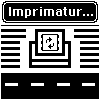
Out of the Ink Jet and Into the Streets
Imprimatur, by Andy Deck, is a free, easy-to-use tool for producing posters. Users create or contribute to poster layouts via their web browser, print them, and place them strategically in the city. They then photograph the posters in situ and upload them to the website.
Creativity becomes a shared process, as unpredictable as the people who are passing through. The artist, rather than providing images, provides a system intended to activate the viewer's thought and expressiveness. Against the backdrop of a mass media culture that promotes conformity and passivity, Imprimatur encourages 'viewers' to choose themes and produce their own messages. It propels on-line expression out of the ink jet and into the streets.
"Imprimatur" is a 2005 commission of New Radio and Performing Arts, Inc. (aka Ether-Ore) for its Turbulence web site. It was made possible with funding from the Andy Warhol Foundation for the Visual Arts.
BIOGRAPHY
Andy Deck is an American media artist specializing in Internet art. His work addresses the politics and aesthetics of collaboration, interactivity, software, and independent media. Deck's aesthetic program seeks a cultural break from the modernization of passive consumerism. Using the site Artcontext.net, he combines code, text, and image, demonstrating new patterns of participation and control that distinguish online presence and representation from previous artistic practices.
Deck is a co-founder of the environmentalist arts organization "Transnational Temps" which was awarded a prize in the VIDA 4.0 Art and Artificial Life Competition (Spain). His site, Artcontext, was a finalist for the 2003 Webby Award in NetArt. A retrospective of his online work was presented at Furtherfield (U.K.) in 2004; and, as part of the Athens-based arts collective, "Personal Cinema," he developed "The Making of Balkan Wars: The Game," a precursor to the game which won a 2005 award at the Electronic Media Art Festival. Deck teaches in the MFA Computer Art department at the School of Visual Arts, New York City.
Posted by jo at 09:27 AM | Comments (0)
The International Database of Corporate Commands
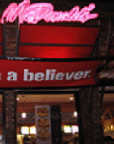
Just Obey Your Ads
"The chipper, poignant and irksome imperatives launched from all corners of daily routine by competing companies permeate our commutes, grocery lists, and vernaculars. Current mantras like 'Laugh More. Cry More. Experience More.' (Blockbuster), 'Try Being More Of A Woman!' (Coty Perfume) and 'Get the Most Incredible Memory Ever.' (Dell) make big demands or promises to their targets! The Institute for Infinitely Small Things, based in and out of Boston, endeavors to compile authoritative research on this topic, comprising a project called The International Database of Corporate Commands.
In the opinion that these commands function within society and public consciousness on a nano level that is virtual and powerful, the white-lab-coated Institute invites researchers from all over the world to upload documentation of corporate commands to their online database. By gathering them all in one place and enacting certain slogans in real spaces--a recent flash-mob-meets-teach-in 'microperformance' at a Cingular store produced 10 minutes of literal 'Roll(ing)over'--the institute hopes to produce a better understanding of the ramifications of constant commercial programming." - Kevin McGarry, Net Art News, Rhizome.
Posted by jo at 07:38 AM | Comments (0)
April 27, 2005
Art-Domains
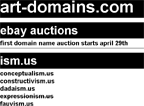
Connecting The Public Domain to the Artworld
Art-Domains, by Peter Luining, is a project that brings internet domain trade to an art context, thus penetrating the space of the white cube with one of the most lucrative virtual money making businesses, that of selling domainnames. For this particular project Peter Luining did over one year of research and became a domain broker himself. He bought and sold domain names to get the knowledge of how this trade works and also to get the best art related names available. Over the last year Luining aquired domain names like clementgreenberg.com, artcriticism.org, marcelduchamp.info, whitecube.us, etc. The Art-Domains stand Luining will present at Art Frankfurt will connect virtual to real space and the public domain of trade to the artworld. At the moment Luining owns about 200 art related domain names that will be offered for the first time for sale at Art Frankfurt. Starting April 29th, art names will be offered for auction at eBay.
For his presentation of Art-Domains Luining uses Mel Bochner's "Working Drawings And Other Visible Things On Paper Not Necessarily Meant To Be Viewed As Art." (1966) as a basis. Bochner's presentation used photocopies and contained ephemeri of "non- art" sources, which were put in identical ring binders and displayed on standard white plinths. Whereas Bochner used new materials to display the creative process over it's results, Luining uses Bochner's classical presentation method (use of standard office techniques i.e. laser prints of webpages) to connect virtual selling strategies with the institutional artworld in a low tech manner.
Posted by jo at 03:03 PM | Comments (0)
April 22, 2005
Footsteps of Hans Christian Andersen
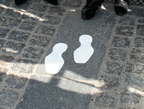
Footstep Hack
"A virtual discovery of Copenhagen in the footsteps of the famous author Hans Christian Andersen has been hacked, possibly by 'gay-activists'. Footsteps of Hans Christian Andersen - A Sound-Walk through the author's Copenhagen is a part of the Danish celebration of the 2005 HC Andersen bicentenary. The project invites people to follow in his footsteps and listen to audio narratives via their mobile phones at selected locations.
The route is marked with 2000 footsteps painted on the sidewalks - however, by adding a few extra footsteps it was diverted to the doorstep of local gay-clubs. The small hack might be a statement, rather than a prank. The HC Andersen anniversary has been criticized by the gay community for ignoring the author's homosexuality. E.g., a papercut by HC Andersen portraying two men holding hands inside a heart was used as a motif in a Christmas decoration by the fashionable department store Magasin du Nord - but instead of two men holding hands, the original artwork was 'corrected' to a woman and a man." See article (Danish) [blogged on guerrilla-innovation]
Posted by jo at 01:17 PM | Comments (0)
April 14, 2005
Kings X Phone In

Musical Intervention
"During the day of Friday 5th August 1994 the telephone booth area behind the destination board at kings X British Rail station will be borrowed and used for a temporary cybercafe. It would be good to concentrate activity around 18:00 GMT, but play as you will." [see Heath Bunting's King's X Phone In]
"The calls "created a musical intervention that disrupted the daily routine of an urban transportation hub, as commuters circulating through the station chatted with strangers from around the world … public space was reconfigured aurally and socially."" From Heath Bunting's Kings Cross Phone-In and Lyotardian Disruptions by Jeff Lee
Posted by jo at 08:23 PM | Comments (0)
April 04, 2005
MADRID ABIERTO
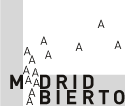
Call for Interventions
MADRID ABIERTO is a project framed within so-called Public Art i.e. interventions and performances derived from an artistic concept and developed preferably in a public and open context. Interacting with social and political processes, these works are aimed at the active or passive protagonists of such processes, i.e. all those people who, directly or indirectly, regularly or occasionally, live together in a specific physical, communicative, social and symbolic space, in this case, the City of Madrid. After the last two editions great success, the new project competition of artistic installations for Madrid Abierto 2006 is now underway.
PROJECT COMPETITION
1. The aim of this call is to select a minimum of ten projects for temporary or short-term artistic projects to take part in Madrid Abierto along with other guest projects.
2. The projects will take place coinciding with ARCO in February 2006 in Madrid, along the axis of Madrid's Paseo de la Castellana and Paseo del Prado boulevards'.
3. You may enter individual or group projects (for group projects you must name a representative). This call is open to artists of any nationality.
4. Each project must include:
* Curriculum Vitae of no more than 2000 characters and a photocopy of the DNI (Spanish National I.D. card) or an equivalent document of the author or authors' of the project.
* Description of the project of no more than 4000 characters.
* A maximum of six outlines and images of the project in jpg format with a resolution of 72 ppp.
* Description of the assembly system and technical requirements.
* Approximate and itemized budget, including details of the concepts which may be able to be self-financed.
* Maximum funding for each selected project is 12.000 euros, including all production, transport and assembly costs, the author or authors' fees and all applicable taxes.
5. Projects should be sent by e-mail to: abierto@madriabierto.com, before the 31st of May, 2005 (or by standard post to: Fundacion Altadis-Madrid Abierto, calle Barquillo, no. 7, 28004 Madrid, Spain).
6. The institutes promoting Madrid Abierto shall assign a commission to select the project, presided by the programme director. The commission will select a minimum of ten projects, evaluating the quality and viability of the proposals, as well as the total reversibility of the projects. As we are dealing with projects that will occupy public areas, it will be essential to obtain the corresponding authorisation from the municipal authorities for their installation.
If the selected projects make any use of third party images, the artists must provide the express authorisation of the owners of these images for their use in the project.
7. Madrid Abierto reserves the right of publication and reproduction of the selected projects for all case relating to the promotion of the programme, and shall incorporate all generated documentation into its documentary resources and public archives. The projects and works selected shall be the property of the authors and the promoting institutions shall have a preferential right to their possible purchase.
8. Participation in this competition entails full acceptance of the above rules and conditions.
For further information: http://www.madridabierto.com abierto @ madridabierto.com
MADRID ABIERTO is a project within what is generically known as Public Art. In the words of its organizer, Ramon Parramon, its objective is to “stimulate creative work in determined places that relate that which is typical of the place and the time in which the creativity takes place. It is to stimulate and generate work processes which take place over time, to boost immersion in the place itself and to interact in a section of public space that has a bearing on the social environment. Madrid Abierto is a programme based on this premise of influencing the public sphere and uses different public areas of the city of Madrid as its stage, proposing new formats and using existing channels or infrastructures which get the general public involved, both in the process and in the search for other people”.
Posted by jo at 09:25 AM | Comments (0)
TAXI MADRID
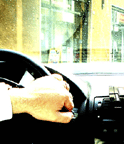
Another Taxi Installation
TAXI MADRID is a mobile public art intervention by artists Anne Lorenz & Rebekka Reich addressing issues of perception and the logic of memory. Equipped with installations, 12 taxis will operate in Madrid throughout the duration of Madrid Abierto, transporting their passengers into someone else's mind and memories of Madrid, those of an ex-patriot.
By interviewing former inhabitants of Madrid, who now live spread all over the world, artists Anne Lorenz and Rebekka Reich seek to find intriguing personal memories related to the city. From this material they devised sound-collages to become part of more complex installations, consisting of objects and other memorabilia, fitted into the taxis.
Regular taxi-users are caught off guard in the confined space of a car, abducted for a short amount of time from their everyday business. The artists seek to surprise and entertain the passenger by confronting him or her with an insight into the memory of a stranger, provoking a memory lapse. Due to the geographical distance of the interviewees an overlay of two pictures occurs: The out of date view of the ex-patriot merges with the current situation on site, and the meeting of the two lives on in the memory of the passenger.
To experience TAXI MADRID call Teletaxi: 91 371 21 31 / 902 501 130 and ask for a taxi from MADRID ABIERTO. Conditions are the same as usual.
Posted by jo at 09:15 AM | Comments (0)
March 28, 2005
teletaxi
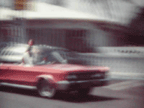
Car #235
Year Zero One is pleased to present teletaxi, a site-specific media art exhibition in a taxicab. The taxi is outfitted with an interactive touch screen that displays video, animation, audio, and information triggered by an onboard GPS (Global Positioning System) receiver which allows the displayed artwork to change depending on where the taxi is in the city. With the combination of the media/gps technology, the mobile environment and the passenger/audience inside the cab. The eleven artists in teletaxi are offered a unique set of possibilities for showing their work - both technically and thematically.
teletaxi will expose interactive media art to a normally passive audience, by presenting works that explore notions of intimacy, mapping, subterranean space, simulated cities, information architecture, data-visualisation, public interventions, surveillance and psychogeography.
Presented by Year Zero One, in Montreal, from March 21 to June, 2005. As part of the DIS/LOCATION: projet d'articulation urbaine programming of DARE-DARE Centre de diffusion d'art multidisciplinaire de Montréal.
Michael Alstad; Mario Côté; Milutin Gubash; David Jhave Johnston; Patric Lacasse; Virginie Laganière; Valérie Lamontagne; Éric Raymond; Doug Scholes
Camille Turner; Myriam Yates.
Opening Friday April first, from 5PM to 9PM, at Square Viger.
Join us at Dare Dare (Square Viger) for a 'fare free' ride in the teletaxi to navigate some of the neighbourhoods and Montreal sites explored by Year Zero One artists and guests.
To reach Taxi Co-op of Montréal, call at (514) 725.9885 and ask for car #235; For more information, contact Dare Dare at (514) 878.1088
[Related]
Posted by jo at 12:54 PM | Comments (0)
March 23, 2005
Crosswalk
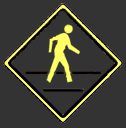
Urban Action
Crosswalk --a Providence Initiative for Psychogeographic Studies (PIPS) publication--is dedicated to further investigations in psychogeography, experimental public art, critical architectural theory, and all practices inbetween. Crosswalk v1.1: Psy-Geo Provflux 2004 was published to coincide with the first annual Psy-Geo Provflux, a two day event investigating how the urban landscape in Providence (Rhode Island, USA) affects its social and artistic community. A call has just been issued for Psy-Geo Provflux 2005.
Crosswalk v1.2::Space Ships includes "Collective Practices," "Interventionist Diaries," "Contemporary Nomadism," "Free Culture," and "Public vs Private."
Posted by jo at 09:57 AM | Comments (0)
March 16, 2005
How to Disappear

Don't Disappear!
Hidden in pornography vending machines on the street, the whole game of buying the How to Disappear kit personifies the dilemma of gaining attention when wanting to hide. It is a practical do it yourself kit containing all the tips and gadgets you need to fight surveillance. Packaged in anonymous video cassette cases you will find a selection of 'disappearance-articles' along with usage instructions, a catalogue with more gadgets and tips, and of course, a lot more information on the subject.
We hope, that by making this extreme kit, we can provoke the visitor, NOT to disappear, but to take part in the debate and demand the respect for their own private life we feel is an essential part of a democratic society. [via Guerilla Innovation]
Posted by jo at 10:47 AM | Comments (0)
March 04, 2005
ArtinCities
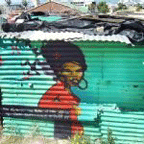
Mapping Cities Through Street Art
"Cities are like a huge art gallery with a permanently changing exhibition. Art is submitted everywhere and constantly. The art is not made by the direction of an institution or company, but are short personal notes, big fascinating projects or intriguing protests. With graffiti, posters, stickers, stencils, etc. the individual artists use the city as an art gallery.
ArtinCities collects the art by each city and wants to find out what is going on in the city. What moves the artists to use the city as a exhibition space? What are the reasons that the artist uses an illegal way to express him/herself? Are there trends (local, regional, international)? Which artists you can find in which city? How does the art spread around?"
Posted by jo at 08:05 AM | Comments (0)
March 03, 2005
Floatables
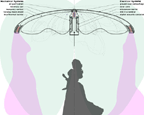
Spaces of Absence
Haque Design and Research asks the question "in an urban environment that is so data-saturated can a distinction between public and private space really claim to exist"? It is the contention of (Floatables) that private spaces are increasingly scarce. All spaces are public, except spaces of absence. If privacy once existed in the home, now such a space no longer needs to be tied to a particular location."
"...The aim of the floatable jellyfish-like vessels that drift around cities is to create temporary, ephemeral zones of privacy: an absence of phone calls, emails, sounds, smells and thermal patterns left behind by others. Through various electrical systems they are also able to prevent access of GPS devices, television broadcasts, wireless networks and other microwave emissions. Finally, by creating a "blurry barrier" and a ground-plane camouflage pattern, they provide shielding from the unembarrassed gaze of security cameras and surveillance satellites." [via]
Posted by jo at 01:34 PM | Comments (0)
February 25, 2005
A r/c tivism in Physical and Virtual Spaces
![]()
Free Communication
"Reclaiming the streets, producing an emancipatory public sphere - how does that work in a society that many call the information society, in which it seems that the spectacle has taken the place of political debate, in which urban space is progressively trimmed to neoliberal/economic imperatives. What has thrust itself onto the stage of a globalized public sphere since the protests against the World Trade Organization meeting in Seattle[1], politically ambiguous[2] yet unmistakable in the potpourri of forms of expressions, represents a practice of dealing with these kinds of questions.
What happens behind the scenes of the colorful video images of protest, which, in fact, largely still adhere to thoroughly traditional patterns in terms of form, mode of production and discourse? What is going on in the virtual and physical workshop spaces of the globally networked movements?[3] How does the virtual space of the Internet relate to geographically definable, "real" locations? Can they still be clearly distinguished, how do they merge? How is the understanding of space and communication changing within the relatively small, relatively privileged[4] group of those active in alternative media with the rapid appropriation of information technology?" From A r/c tivism in Physical and Virtual Spaces by Marion Hamm.
Posted by jo at 05:25 PM | Comments (0)
Version>05>Invincible Desire

CALL FOR PROPOSALS AND WORK
Version is an international festival about art, media, technology and politics. Our fourth annual convergence, Version>05> Invincible Desire, will examine the activities of local configurations and external networks that use visual art, innovative social practices, artist initiatives, creative uses of new technologies, organizing strategies and public interventions in order to engage in cultural reclamation. Through a diverse program featuring an experimental art expo, artistic disturbances, networked urban events, screenings, interactive applications, performances, workshops, art rendez-vous, parties, and action, Version>05 will investigate the urgency for interventions in everyday life, the organization of our shared interests, and the distribution of our ideas.
We will convene in Chicago for a ten day open laboratory to explore a diversity of tactics and strategies to activate our communities and amplify our ideas. The city of Chicago will be used as a map to examine microactions. Blueprints will be unveiled to strengthen emerging alliances and counter institutions. Alternative spaces will be open for staging actions. Public spaces and corporate places will be terrains of intervention.
We seek to explore methods to enjoin the public in a dialogue about pressing issues and ideas of our age. We want to share your actions as well as projects and activities that can help us to transform personal and shared environments. It is our hope that the issue will offer ways to engage in meme warfare, practice social engagement and produce instruments of transformation during these dark ages.
Posted by jo at 01:41 PM | Comments (0)
February 22, 2005
UTILITY WORKS

Reflecting the Virtual Back Into the Physical
UTILITY WORKS seeks to acknowledge the importance of the mundane physical spaces where we play out our lives and provide new ways for the population to inscribe themselves into these informal public spaces. In an effort to draw new connections across our cities, UTILITY WORKS perverts existing municipal street furniture which will become points of mediation between disparate physical urban environments and the people that inhabit them. With these new urban experiences UTILITY WORKS seeks to provoke a renewed awareness of self and environment through a reexamination of familiar civic objects that we interact with every day. Just as a mirror reflects our bodies back to us, this project becomes a way of reflecting the virtual back into the physical urbanscape. Existing parking meters, post boxes, and garbage bins - the furniture of the mundane - will be activated to shape and articulate the informal public spaces of the city. Parking Meter | Post Box | Garbage Bin [via]
Posted by jo at 10:59 AM | Comments (0)
February 07, 2005
THE INTERNATIONAL DATABASE OF CORPORATE COMMANDS
![]()
An Imperative Call
The Institute for Infinitely Small Things announced its new research initiative today, THE INTERNATIONAL DATABASE OF CORPORATE COMMANDS (IDCC). This research database is open to submissions of corporate commands from researchers around the world. A Corporate Command is an instruction work, a call to action in the form of an imperative: "Just Do It"; "Turn on the Future"; "Live without Limits"; "Tap into great taste"; "Think different"; "Ride the light"; "Live Like You Mean It."
It is the hypothesis of the Institute for Infinitely Small Things that these commands, largely and consciously ignored by a public over-saturated with advertisements, function at the scale of the infinitely small. Tiny events that do not disturb ones consciousness or disrupt ones identity as "free" agents, these commands seep under the surface of the individual and lay claim to the territory of the Deleuzian Virtual. Desire, memory, and future potentiality become territories for conquest and tactics for social and political control.
By compiling, tabulating, concretizing and enacting these commands in the International Database of Corporate Commands (IDCC), the Institute for Infinitely Small Things seeks to better understand the mechanisms behind this deployment of power and its larger cultural ramifications.
EVENTS & EXPEDITIONS: The Institute for Infinitely Small Things will be using the IDCC to lead a series of public expeditions during the 2005 Boston Cyberarts Festival in April-May. The Institute's temporary laboratory will be situated at Space 200 at 200 State Street in Fanueil Hall. Please check the website for exact times and locations of expeditions.
PARTNERSHIPS: The Institute welcomes requests for Research Partnerships from institutions and individuals engaging with similar questions. The IDCC is licensed under a Creative Commons Attribution-NonCommercial-ShareAlike 2.0 license. We are interested in publishing, syndicating or linking to any research that is relevant to our mission.
ABOUT THE INSTITUTE FOR INFINITELY SMALL THINGS
The Institute for Infinitely Small Things is a research organization dedicated to the creation, collection and documentation of all of the infinitely small things in the world, past, present and future. The Institute's research projects are concerned with creating a critical cartography through which to explore notions of political power, social controls, collective agency and human freedom.
Contact: The Institute for Infinitely Small Things
info @ infinitelysmallthings.net
617-501-2441
Posted by jo at 09:46 AM | Comments (0)
February 04, 2005
E N T E R C H A N G E

The Power of Performing and Nature
"...Contemporary views about performance and performativity emphasise ephemerality, contingency, improvisation, adaptation - whether in the ‘doing’ of an everyday action or in the creation of an aesthetic event. It is a relational process through-and-through.
Those qualities can be seen to inhere in the processes of nature, the continual change of environments and in the actions of the beings and entities which are more-than-human. Rather than ‘nature’ as a background to human performance, or merely a subject for representation, the processes of human performance can be seen as continuous with those of nature – sometimes resonant together, sometimes not..." Read full essay >>
Posted by jo at 09:20 AM | Comments (0)
January 03, 2005
Portable Cellular Phone Booth
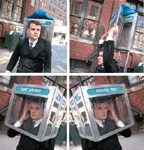
Sacrificed Interaction
"The Portable Cellular Phone Booth provides a visual image of social sacrifices and opportunities to interact with one another lost due to our own self -involvement. The sculpture is a retractable phone booth that is carried on your back and can slide up and over your head to completely isolate you from society, kind of like the way a cell phone does. The action is fast and slick just like the flip action of a cell phone.
Historically the iconic phone booth represented a place where one could go to be alone for a private conversation, transform into superman or travel through time. Today, it's obsolete in most cities. With the Portable Cellular Phone Booth, one can transform from a member of society to one that is closed off.
By delivering my sculpture to an unsuspecting public, anyone who notices the piece receives a myriad of messages from self deprecating humor to the neglecting of friendship in real time for the hope of something better." --Nick Rodrigues, from an interview on Sensory Impact. [via textually.org]
Posted by jo at 11:30 AM | Comments (0)
LUCY ORTA

The Staging of a Social Bond
LUCY ORTA born in Great Britain 1966, studio based in Paris. Lucy Orta's Refuge Wear, was first noticed in the early 90's. These objects resembled temporary mobile architectures which transformed into poetic items of clothing, sleeping bags, first aid units, for nomadic populations. Her Collective Wear sculptures in the form of tent domes with protruding appendages, exhibited in the Modern Art museum in Paris in 1994 were placed into urban contexts for a series of interventions in housing estates, subway stations... and later developed into a human chain, Nexus Architecture which has since become the emblem of her work and has been presented in site specific performances such as the Venice Biennale in 1995, Johannesburg Biennale 1997, Museum of Contemporary Art Sydney 1998, Bolivia, Berlin, New York, Mexico City.
She encourgages in an active participation from very diverse members of the community by organising workshop "Actions" and her projects both in the museum space and within the community question the role of art as a agent for participation and dialogue. Particulary pertinent are the public works Life Nexus Village Fête co-comissioned by the University of Central England for the exhibition "In the Midst of Things" in Bournville 1999 and the Art Gallery of Western Australia 2000. Recent public works such as "Hortireycycling Enterprise" exhibited at the Secession in 1999 and 70x7 The Meal introduce the theme of the meal as a ritual for public exchange and at the Kunstraum Innsbruck in January 2000, she proposed a 70 metre table service with a series of lunches for infinite number of guests to dine together for a moment of convivialty.
"The staging of a social bond is the common denominator linking Lucy Orta's different projects and perfectly reflects her transverse approach to poetic expression. Her Refuge Wear and Nexus Architecture interventions are effective tools in the struggle against exclusion and combine architecture, body art, street theatre, fashion, social therapy, formal poetry and ideological activism. The titles of her principal projects, which function both as social scenarios and art works, speak for themselves : Nexus Architecture, Refuge Wear, Modular Architecture, Commune Communicate, Citizen Platform... She has, since 1992, brilliantly addressed issues of relational aesthetics, her principal field of intervention being the personal space of the individual fighting for survival in adverse conditions." Pierre Restany [thanks pasta and vinegar]
Posted by jo at 10:52 AM | Comments (0)
December 07, 2004
October Surprise

Creative Interventions and Underground Politics
Los Angeles is made up of a collection of diverse neighborhoods, each delineated by various physical and social geographies, and tenuously connected by a complex of shared economies, cultures, and desires. East of the LA River, stretching up along Figueroa Avenue and the Arroyo Seco, Highland Park is girded by Mount Washington, Montecito Heights, Glassel Park and Eagle Rock. Highland Park is but one town among many that could be called home. This section of Northeast Los Angeles will be home to the series of events documented in these pages, and include the efforts of artists, activists, and citizens concerned with the local manifestation of culture, politics, history and ecology.
...Nearly every space in our life demands dealing creatively with poor urban planning, bad schools, privatized histories… Yet we are encouraged to become global drifters instead - just more consumers wearing Hard Rock Café T-shirts from Bangkok, Paris or Disneyland. To explore some of these possibilities, October Surprise has created a space for site-specific installations and interventions that recognize THIS place as our home, revealing and celebrating the past, present and possible futures of Northeast LA. .."This is OUR city, let’s live in it!"
Posted by jo at 11:59 AM | Comments (0)
October 15, 2004
Mapping
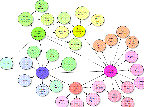
Alternative Categories
"In preparation for Wednesday's Urban Gaming lecture, we thought we'd make a map. We've mapped psychogeography, nomadic communication and technologically infused public space as enablers of the urban gaming explosion. Gaming is the perfect structure for experimenting with these new tools, places and communities. The dynamics between online and offline players, person and space, space and technology, person and technology are being stress tested and observed in the form of games in media labs, art collectives and companies throughout the world. And it's evolving to be a mechanism for social activism as well- so there you go!" From community-centric.
Posted by jo at 01:12 PM | Comments (1)
October 05, 2004
The Temporary Travel Office

non-rational connections
The Temporary Travel Office produces a variety of services relating to tourism and technology aimed at exploring the non-rational connections existing between public and private spaces.
How is corporate biotechnology shaping the spaces we live in? The Travel Office's tour of the Chicago Technology Park is a guided audio experience that places the city's current investment in the "new economy" within the historical, and ongoing, practices of social engineering through urban planning. A story of spatial eugenics emerges out of the juxtaposition of texts and statements from disparate sources that include Official state and city press releases, corporate documents and activist archives. Neither the Travel Office nor this tour represent the Chicago Technology Park, the Illinois Medical District Commission, or any affiliated government or private entities. [left: A Travel Office representative conducting a walking tour of the CTP] [sampled audio of Chicago Transit system from www.chicago-L.org]
Posted by jo at 02:59 PM | Comments (1)
August 03, 2004
Painting the Street
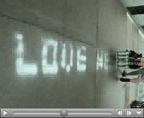
Bikes Against Bush
From "Bike Writer Pedals for Protests" by Leander Kahney, Wired News, August 2, 2004
New Yorker Joshua Kinberg is a bike messenger of a different stripe. Instead of ferrying legal papers between lawyers, he uses a homemade, wireless, bicycle-mounted dot-matrix printer to spray protest messages in the street...[Bikes Against Bush is] "painting on the street, but on the Net, too," said Kinberg, a post-graduate student at Parsons School of Design.
Continue reading at Wired.com
Posted by jo at 10:37 AM | Comments (1)
August 02, 2004
iSee Wireless

iSee Wireless
We are in the midst of two wireless revolutions, one defined by large corporations that buy spectrum, the other defined by ad hoc networks and open standards. We are focused on contributing to this second, more democratic revolution.
Julian Bleecker (Art Cache Machine, WiJacker, Proximity Wireless projects utilizing WiFi Toolkit software.) explores practical and playful uses of WiFi through a series of projects created with the WiFi Toolkit, a set of software APIs Bleecker developed as Engineer in Residence at Eyebeam. Art Cache Machine, the WiJacker and Proximity are three WiFi-enabled applications developed to investigate the possibilities of "partially connected" WiFi social networks using access points deliberately off the public internet. Art Cache Machine is a mobile WiFi node that provides an access point for specific digital art that can only exist within the locale of the Machine's WiFi node. WiJacker assumes the role of a WiFi node by hijacking the activity of users. Proximity is an ad-hoc communication service that enables connections between devices without user intervention.
iSee is a web-based application charting the locations of closed-circuit television (CCTV) surveillance cameras in urban environments. With iSee, users can find routes that avoid these cameras -
Who should use iSee
The past several years has seen a dramatic increase in CCTV surveillance of public space. Video cameras peer at us from the sides of buildings, from ATM machines, from traffic lights, capturing our every move for observation by police officers and private security guards that often act with very little public or legislative oversight. While the effectiveness of these devices in reducing crime is dubious at best (see below), recent cases of misuse by public and private authorities serve to question the appropriateness of video monitoring in public space. Here is a short list of people who might legitimately want to avoid having their picture taken by unseen observers:
Minorities
One of the big problems with video surveillance is the tendency of police officers and security guards to single out particular people to monitor. It is hardly surprising that the mentality leading to racial profiling in traffic stops has found similar expression in police officers focusing their cameras on people of color. Indeed, a recent study of video surveillance in the UK, the leading user of CCTV surveillance systems, says that "black people were between one-and-a-half and two-and-a-half times more likely to be surveilled than one would expect from their presence in the population." It is worth pointing out that, in this study, 40% of people that the police targeted were picked out "for no obvious reason," other than their ethnicity or apparent membership in various subcultural groups. In other words, they were singled out not for what they were doing, but simply based on how they looked.
Women
It appears that police monitors just can’t seem to keep it in their pants when it comes to video surveillance. In a Hull University study, 1 out of 10 women were targeted for “voyeuristic” reasons by male camera operators, and a Brooklyn police sergeant blew the whistle on several of her colleagues in 1998 for “taking pictures of civilian women in the area ... from breast shots to the backside."
Youth
Young men, particularly young black men, are routinely singled out by police operators for increased scrutiny. This is particularly true if they appear to belong to subcultural groups that authority figures find suspicious or threatening. Do you wear baggy pants or shave your head? Smile – you’re on candid camera!
"Outsiders"
The Hull University study also found a tendency of CCTV operators to focus on people whose appearance or activities marked them as being "out of place." This includes people loitering outside of shops, or homeless people panhandling. Not surprisingly, this group includes individuals observed to be expressing their opposition to the CCTV cameras.
Activists
Experience has shown that CCTV systems may be used to spy on activist groups engaged in legal forms of dissent or discussion. Indeed, the City College of New York was embarrassed several years ago by student activists who found, much to their dismay, that the administration had installed surveillance cameras in their meeting areas. This trend shows no signs of abating: one of the more popular demonstrations of CCTV capabilities that law enforcement officials and manufacturers like to cite is the ability to read the text of fliers that activists post on public lampposts.
Everyone else
Let’s face it – we all do things that are perfectly legal, but that we still may not want to share with the rest of the world. Kissing your lover on the street, interviewing for a new job without your current employer’s knowledge, visiting a psychiatrist – these are everyday activities that constitute our personal, private lives. While there is nothing wrong with any of them, there are perfectly good reasons why we may choose to keep them secret from coworkers, neighbors, or anyone else.
But what’s the harm?
Clearly, video surveillance of public space represents an invasion of personal privacy. But so what? Having one's picture taken from time to time seems a small price to pay for the security benefits such surveillance offers. It's not like anyone ever sees the tapes, and let's be honest
Unfortunately, this is not entirely accurate. The fact is, there is very little oversight of video surveillance systems, and the question of who owns the tapes
The fact is, many of the cameras monitoring public space are privately owned. Banks, office buildings, and department stores all routinely engage in continuous video monitoring of their facilities and of any adjacent public space. The recordings they make are privately owned, and may be stored, broadcast, or sold to other companies without permission, disclosure, or payment to the people involved.
Similarly, video footage that is captured by public police departments may be considered part of the "public record," and as such are available for the asking to individuals, companies, and government agencies. At present, there is precious little to prevent television programs like "Cops" and "America's Funniest Home Movies" from broadcasting surveillance video without ever securing permission from their subjects.
Sound far-fetched? Already in the UK
Similarly, there has been a proliferation of "spy cam" websites featuring clandestine footage of women in toilets, dressing rooms, and a variety of other locations. A lack of legislative oversight allows these sites to operate legally, but even if new laws are passed, the nature of the Internet makes prosecutions highly unlikely.
As video surveillance systems evolve and become more sophisticated, the opportunities for abuse are compounded. Sophisticated video systems can identify the faces of individuals (matching video images to databases of known faces
All of this says nothing about the societal impact of our increasing reliance on surveillance, and our growing willingness to put ourselves under the microscope of law enforcement and commercial interests. Once a cold-war caricature of Soviet-style communist regimes, the notion of the "surveillance society" is increasingly employed to describe modern urban life in such bastions of personal liberty and freedom as the United States, United Kingdom, and Canada.
While the nature of such a society has been long theorized by philosophers, critics, and sociologists, the psychological and social effects of living under constant surveillance are not yet well understood. However, the impacts that CCTV systems have on crime are beginning to be known.
Video Surveillance and Crime
Touted as a high-tech solution to social problems of crime and disorder by manufacturers selling expensive video surveillance systems to local governments and police departments, CCTV has gained much popularity in recent years. These manufactures claim that CCTV
CCTV is often promoted with thinly veiled references to the threat of terrorism: hence their widespread use in the UK, which has long lived with bomb threats and other violent actions. Already, in light of the September 11 attacks, video surveillance manufacturers have begun to court the American public
Attempting to capitalize on an international tragedy to sell product in this manner may seem tastelessly opportunistic at best. Given the track record of CCTV systems to date, this strategy seems downright cynical. According to studies of the effectiveness of video surveillance in use throughout the UK, there is no conclusive evidence that the presence of CCTV has any impact on local crime rates. While there have been examples of reduced criminality in areas where CCTV has been installed, these reductions may also be explained by other factors, including general decreases in crime throughout the UK. Indeed, in several areas where CCTV was installed, crime rates actually increased.
Given the widespread use of these systems, it is surprising how infrequently they lead to arrests. According to one report, a 22-month long surveillance of New York's Times Square led to only 10 arrests (those cameras have since been removed). Furthermore, the type of crime against which CCTV is most effective seems positively mundane when compared to its advocate's claims of stopping terrorism and kidnappings. A study of CCTV use in the UK found that the majority of arrests in which video surveillance played a significant role were to stop fistfights. Again, this was a relatively infrequent occurrence, and hardly seems to justify the price tag and loss of privacy these systems inherently engender.
More disturbing, however, was the finding that incidents of police brutality and harassment captured by CCTV surveillance were routinely ignored. The tapes of these events also had a tendency to be "lost" by operators.
The effect of video surveillance on criminal psychology is also not well understood. One Los Angeles study found that cameras in a retail store were perceived by criminals as a challenge, and in fact offered became an inducement towards shoplifting.
At best, CCTV seems to not reduce crime, but merely to divert it to other areas. According to one Boston police official, "criminals get used to the cameras and tend to move out of sight."
A final thought...
Given heightened awareness of public safety and increased demand for greater security in the face of growing threats of terrorist violence, projects that undermine systems for social control may seem to some viewers to be in poor taste. It is the Institute for Applied Autonomy's position that such times call out all the more strongly for precisely these kinds of projects. As spytech dealers stumble over themselves in their haste to auction off our civil liberties - wrapped in the stars and stripes, tied up tight with memorial ribbons - to right-wing politicos who drool and salivate in anticipation of railroading their own Orwellian wet-dreams of social control through our legislative bodies, there is a vital need for independent voices that cry out against such cynical exploitation of legitimate human fear and suffering for political power and monetary gain. The Institute for Applied Autonomy is such a voice. iSee is our statement.
- Brought to you by the Institute for Applied Autonomy "now more than ever"
Posted by michelle at 12:55 PM | Comments (0)
Dancing in the Streets: Revolution with a Smile
John Perry Barlow invites you to revolt with him: "I want to organize a cadre of 20 to 50 of us. I want to dress us in suits and other plain pedestrian attire and salt us among the sidewalk multitudes in Republican-rich zones. At a predetermined moment, one of us will produce a boom-box and crank it up with something danceable. Suddenly, about a third of the people on the sidewalk, miscellaneously distributed in the general throng, will start dancing like crazy and continue to do so for for about a minute. Then we will stop, melt back into the pedestrian flow, and go to another location to erupt there.
Perhaps if we enlist enough troops, we can have several platoons simultaneously exploding into dance around Manhattan, so there will be absolutely no way to tell where we might strike next."
Continue reading at BarlowFriendz
Posted by jo at 12:34 PM | Comments (1)
August 01, 2004
O.U.T. There
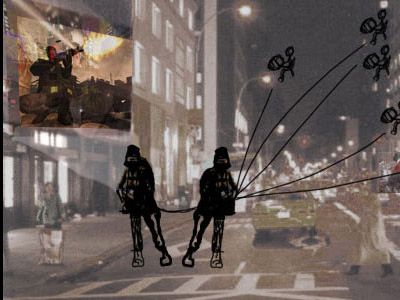
Two women in gear are on the ground. One with a laptop and the other with a projector pointing onto building walls in 3 key locations in the city. They are connected through a mobile wireless bicycle to an online team of five game players located around the world. They intervene on servers in a popular online military simulation game with performance actions carried out by the whole team. The live projections in the city can also be viewed through a web cam on the OUT website.
OUT takes its name from MOUT a military term for Military Operations in Urban Terrain. Many military simulation computer games implement MOUT. For example, the US Army developed game Full Spectrum Warrior trains gamers in MOUT combat. OUT is a criticism of the increasing militarization of civilian life which has been implemented in the US and elsewhere since 911. The Patriot Act, surveillance of public libraries, and the increased powers of government to hold citizens in military custody without trial are instances of these increased powers of government instigated by the Bush administration. In an endless spiral war of terror a government is at war with its own citizens, with soldiers in the midst of the fabric of ordinary life, as has been the case for a while in terror alert cities like Tel Aviv and Jerusalem.
OUT is an artistic intervention in the public space of online games and cities. OUT is also happening at a moment when the street has become again a viable mode of expression. From Seattle to Cancun activists are using wireless technologies and the web to organize actions and and congregate. Dada-like agenda-less mobs have appeared in New York and spread to other cities, In contrast, police at these events are increasingly high tech and cyborgean. They wear the latest riot gear shields and padding and use high tech wireless communication systems. They move in sophisticated crowd control formations. OUT, on the other hand, is a high tech art intervention, art activists with high tech gear and strategy. OUT of the closet of MOUT.
Republicans OUT of New York. The United States OUT of Iraq and the Middle East. Escalating worldwide Militarism and Violence, from whatever source, (right wing oil hungry U.S. capitalists or wealthy Islamic fundamentalists), OUT of Civilian Life. The U.S. Army and Pentagon computer game developers OUT of the minds of prebuscent gamers.
Posted by michelle at 03:45 PM | Comments (0)
July 31, 2004
From Hactivism to Tactical Media
Hacktivism (electronic resistence within the network) has fed into tactical media: urban, mobile performance events.
Being 'wired' has become mobile, ubiquitous, sentient, pervasive, OMNICIENT monitored, computing. As we desire our movies and games to be more realistic - hyper-realistic - we now inhabit our computer-mediated, if not computer-generated worlds. We interact through joysticks that exert pressure to our response. We track oursleves with GPS-equipped devices, we pass and receive data streams: enveloped, engaged, connected, linked.
There's a surge in public events - happenings - Kaprow's "Environmental Theatre" of the collective, enabled by wi-fi technology and taken to the streets: MOBILized.
From: The ABC of Tactical Media by David Garcia and Geert Lovink
Tactical Media
"In fact we introduced the term tactical to disrupt and take us beyond the rigid dichotomies that have restricted thinking in this area for so long: dichotomies such as amateur vs professional, alternative vs mainstream. Even private vs public. Our hybrid forms are always provisional. What counts are the temporary connections you are able to make. Here and now, not some vaporware promised for the future. But what we can do on the spot with the media we have access to. Here in Amsterdam we have access to local TV, digital cities and fortresses of new and old media. In other places they might have theater, street demonstrations, experimental film, literature, photography. Tactical media’s mobility connects it to a wider movement of migrant culture."
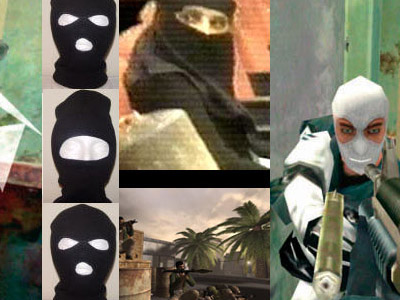 O.U.T.: Operation Urban Terrain :a live action wireless gaming urban intervention
O.U.T.: Operation Urban Terrain :a live action wireless gaming urban intervention
When: August 30, during the Republican National Convention, New York City.
Two women in gear are on the ground. One with a laptop and the other with a projector pointing onto building walls in 3 key locations in the city. They are connected through a mobile wireless bicycle to an online team of five game players located around the world. They intervene on servers in a popular online military simulation game with performance actions carried out by the whole team.The live projections in the city can also be viewed through a web cam on the OUT website.
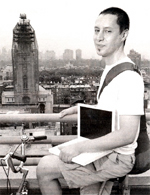 Magicbike is a mobile WiFi (wireless Internet) hotspot that gives free Internet connectivity wherever its ridden or parked. By turning a common bicycle into a wireless hotspot, Magicbike explores new delivery and use strategies for wireless networks and modern-day urbanites. Wireless bicycles disappear into the urban fabric and bring Internet to yet unserved spaces and communities. Mixing public art with techno-activism, Magicbikes are perfect for setting up adhoc Internet connectivity for art and culture events, emergency access, public demonstrations, and communities on the struggling end of the digital-divide.
Magicbike is a mobile WiFi (wireless Internet) hotspot that gives free Internet connectivity wherever its ridden or parked. By turning a common bicycle into a wireless hotspot, Magicbike explores new delivery and use strategies for wireless networks and modern-day urbanites. Wireless bicycles disappear into the urban fabric and bring Internet to yet unserved spaces and communities. Mixing public art with techno-activism, Magicbikes are perfect for setting up adhoc Internet connectivity for art and culture events, emergency access, public demonstrations, and communities on the struggling end of the digital-divide.
Posted by michelle at 01:51 PM | Comments (1)

